Welcome to Snowflake! This entry-level guide, designed for database and data warehouse administrators and architects, will help you navigate the Snowflake interface and introduce you to some of our core capabilities. Sign up for a free 30-day trial of Snowflake and follow along with this lab. Once we cover the basics, you'll be ready to start processing your own data and diving into Snowflake's more advanced features!
Free Virtual Hands-on Lab
This Snowflake Guide is available as a free, instructor-led Virtual Hands on Lab. Sign up for the VHOL today.
Prerequisites:
- Use of the Snowflake free 30-day trial environment
- Basic knowledge of SQL, database concepts, and objects
- Familiarity with CSV (comma-delimited) files and JSON semi-structured data
What You'll Learn:
- How to create stages, databases, tables, views, and virtual warehouses.
- How to load structured and semi-structured data.
- How to consume Snowflake Public Data data from the Snowflake Data Marketplace.
- How to perform analytical queries on data in Snowflake, including joins between tables.
- How to clone objects.
- How to undo user errors using Time Travel.
- How to create roles and users, and grant them privileges.
- How to securely and easily share data with other accounts.
Data You'll Use:
Snowflake Public Data is a next generation data company creating a real-time view of the world's economy with analytics-ready data exclusively on Snowflake Marketplace. Initially focused on consumer insights, Snowflake Public Data enables you to access external data directly in your Snowflake instance — no ETL required.
This lab will use the following Snowflake Public Data datasets:
- Snowflake Public Data (Free)
Check out Snowflake Public Data's Snowflake Public Data (Free) product and explore all public sources Snowflake Public Data offers on the Snowflake Marketplace.
If you haven't already, register for a Snowflake free 30-day trial. This lab assumes you are using a new Snowflake account created by registering for a trial.
The Snowflake edition (Standard, Enterprise, Business Critical, etc.), cloud provider (AWS, Azure, GCP), and Region (US East, EU, etc.) you use for this lab, do not matter. However, we suggest you select the region that is physically closest to you and Enterprise, our most popular offering, as your Snowflake edition.
After registering, you will receive an email with an activation link and URL for accessing your Snowflake account.
Logging into the Snowflake User Interface (UI)
Open a browser window and enter the URL of your Snowflake 30-day trial environment that was sent with your registration email. Enter the username and password that you specified during the registration:
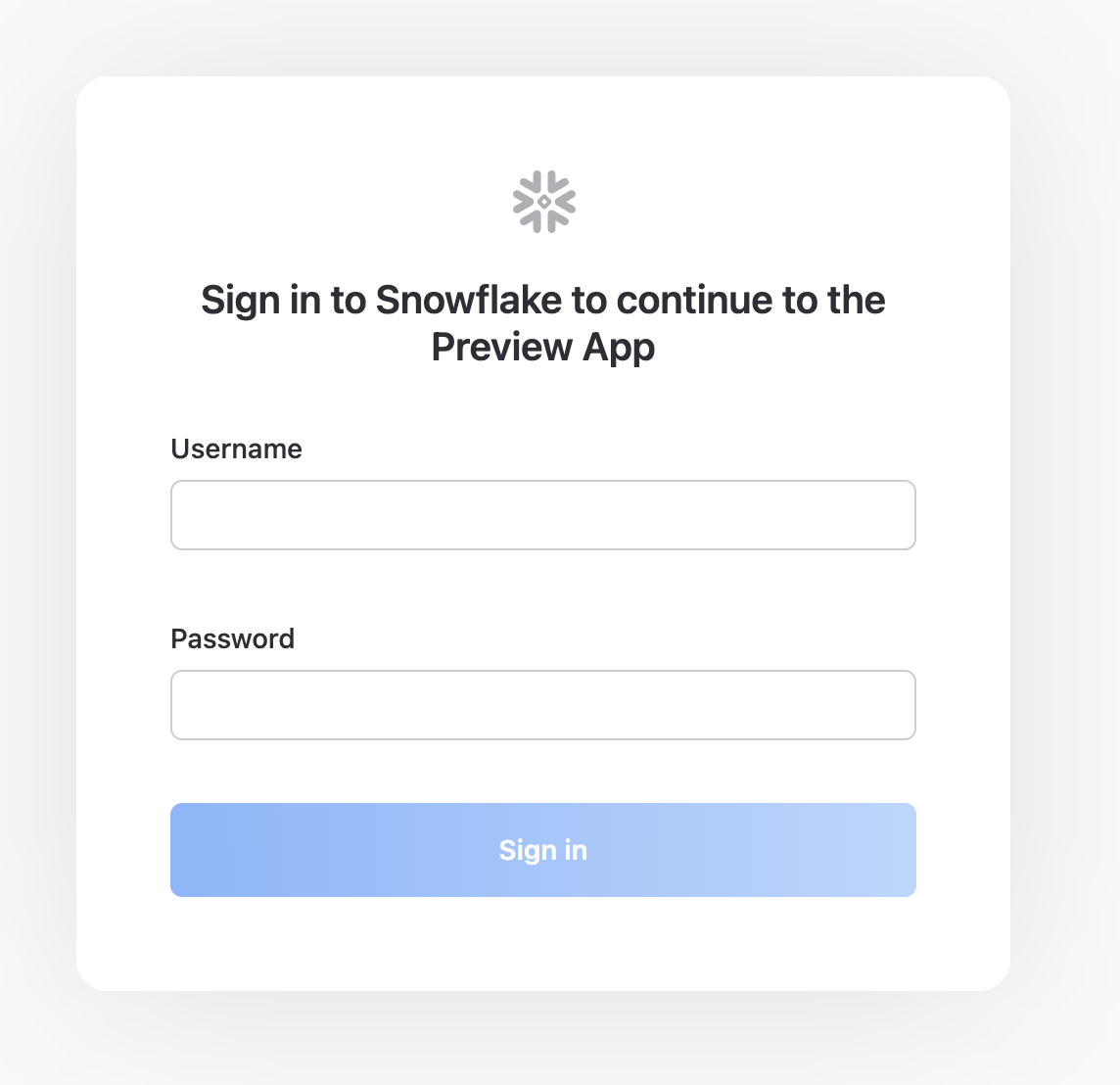
Navigating the Snowflake UI
Let's get you acquainted with Snowflake! This section covers the basic components of the user interface.
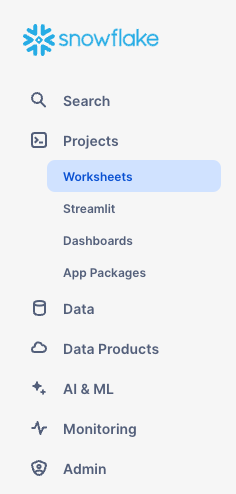
Projects > Worksheets
Under Projects on the left-hand panel, select the Worksheets tab or go directly by clicking here. This provides an interface for submitting SQL queries, performing DDL and DML operations, and viewing results as your queries or operations complete. A new worksheet is created by clicking + on the top right.
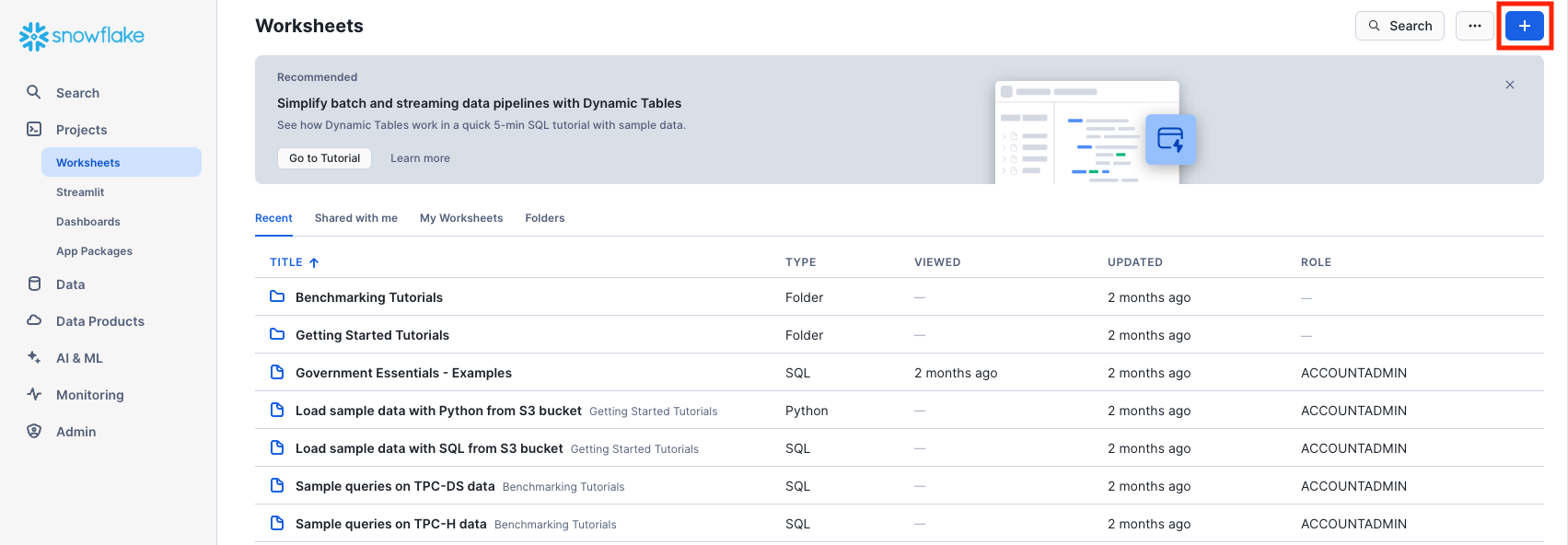
Worksheet Structure
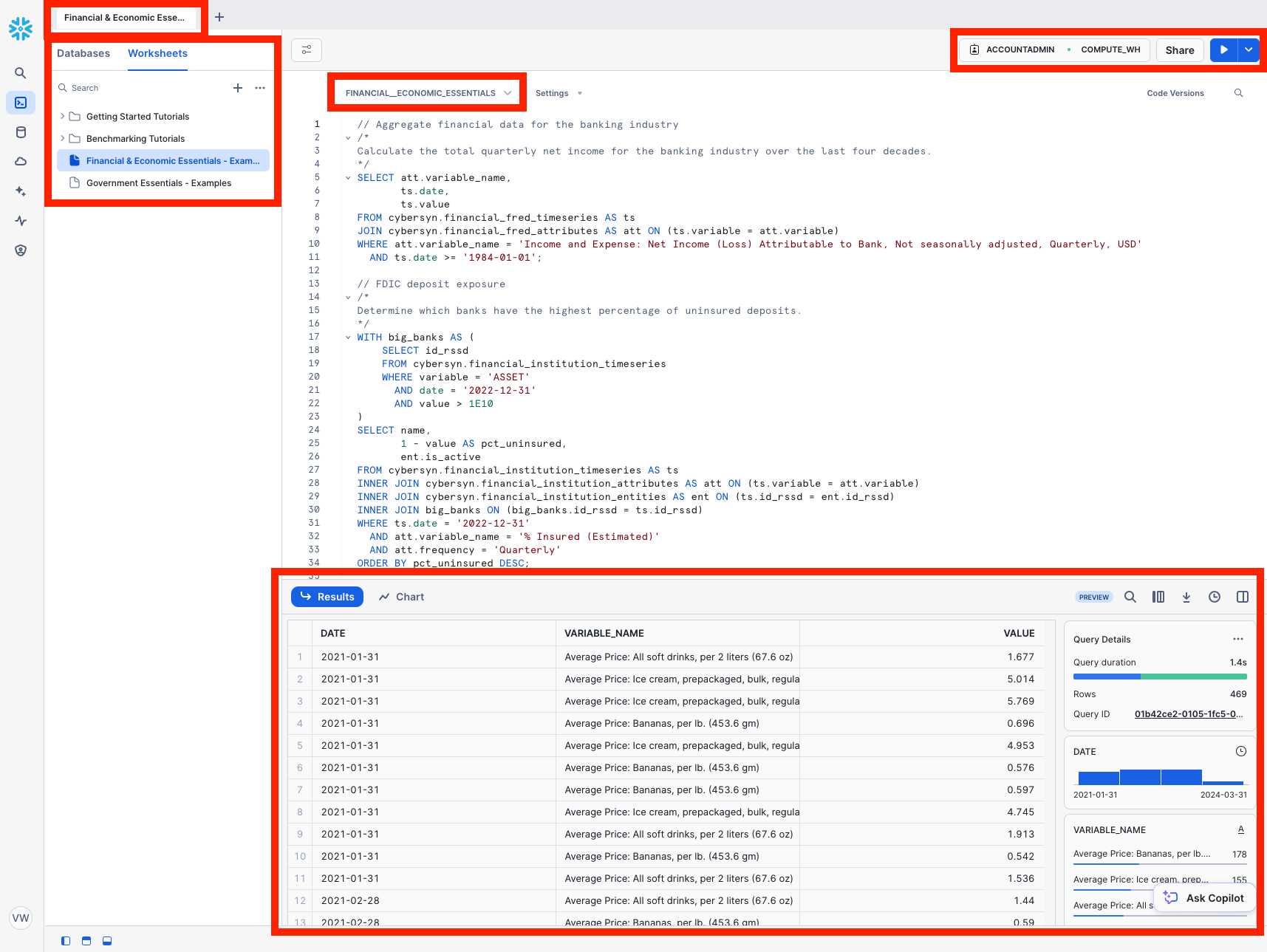
The top left corner contains the following:
- Snowflake icon: Use this to get back to the main console/close the worksheet.
- Worksheet_name drop-down: The default name is the timestamp when the worksheet was created. Click the timestamp to edit the worksheet name. The drop-down also displays additional actions you can perform for the worksheet.
- Filters button: Custom filters are special keywords that resolve as a subquery or list of values.
The top right corner contains the following:
- Context box: This lets Snowflake know which role and warehouse to use during this session. It can be changed via the UI or SQL commands.
- Share button: Open the sharing menu to share to other users or copy the link to the worksheet.
- Play/Run button: Run the SQL statement where the cursor currently is or multiple selected statements.
The middle pane contains the following:
- Drop-down at the top for setting the database/schema/object context for the worksheet.
- General working area where you enter and execute queries and other SQL statements.
The middle-left panel contains the following:
- Worksheets tab: Use this tab to quickly select and jump between different worksheets
- Databases tab: Use this tab to view all of the database objects available to the current role
- Search bar: database objects browser which enables you to explore all databases, schemas, tables, and views accessible by the role currently in use for the worksheet.
The bottom pane displays the results of queries and other operations. Also includes 4 options (Object, Query, Result, Chart) that open/close their respective panels on the UI. Chart opens a visualization panel for the returned results. More on this later.
The various panes on this page can be resized by adjusting their sliders. If you need more room in the worksheet, collapse the database objects browser in the left panel. Many of the screenshots in this guide keep this panel closed.
Projects > Dashboards
Under Projects on the left-hand panel, select the Dashboards tab or click here. This tab allows you to create flexible displays of one or more charts (in the form of tiles, which can be rearranged). Tiles and widgets are produced by executing SQL queries that return results in a worksheet. Dashboards work at a variety of sizes with minimal configuration.
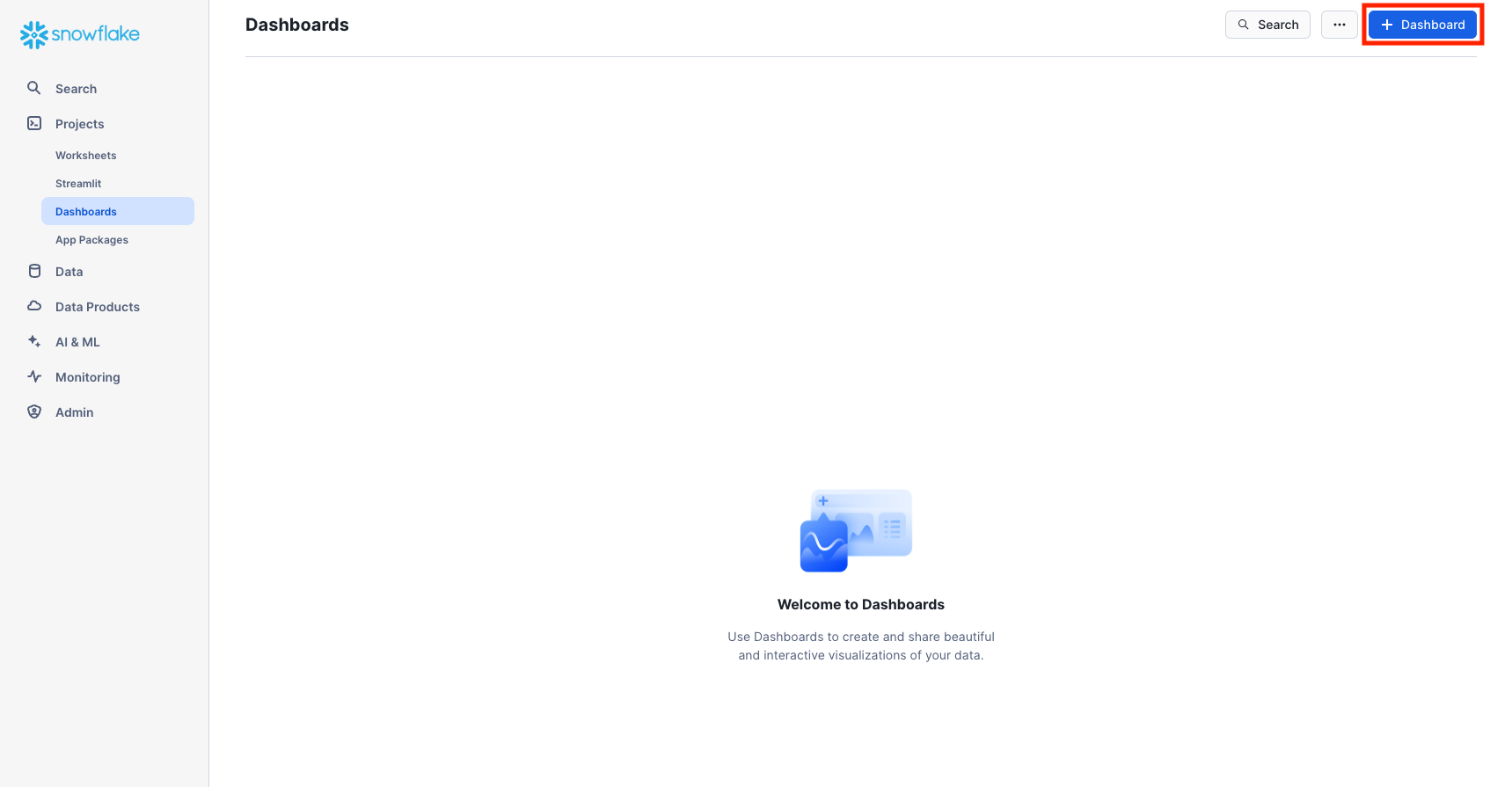
Data > Databases
Under Discover & Collaborate, the Catalog > Database Explorer tab shows information about the databases you have created or have permission to access. Click here to naviage to the Database Explorer directly. You can create, clone, drop, or transfer ownership of databases, as well as load data in the UI. Notice that a database already exists in your environment. However, we will not be using it in this lab.
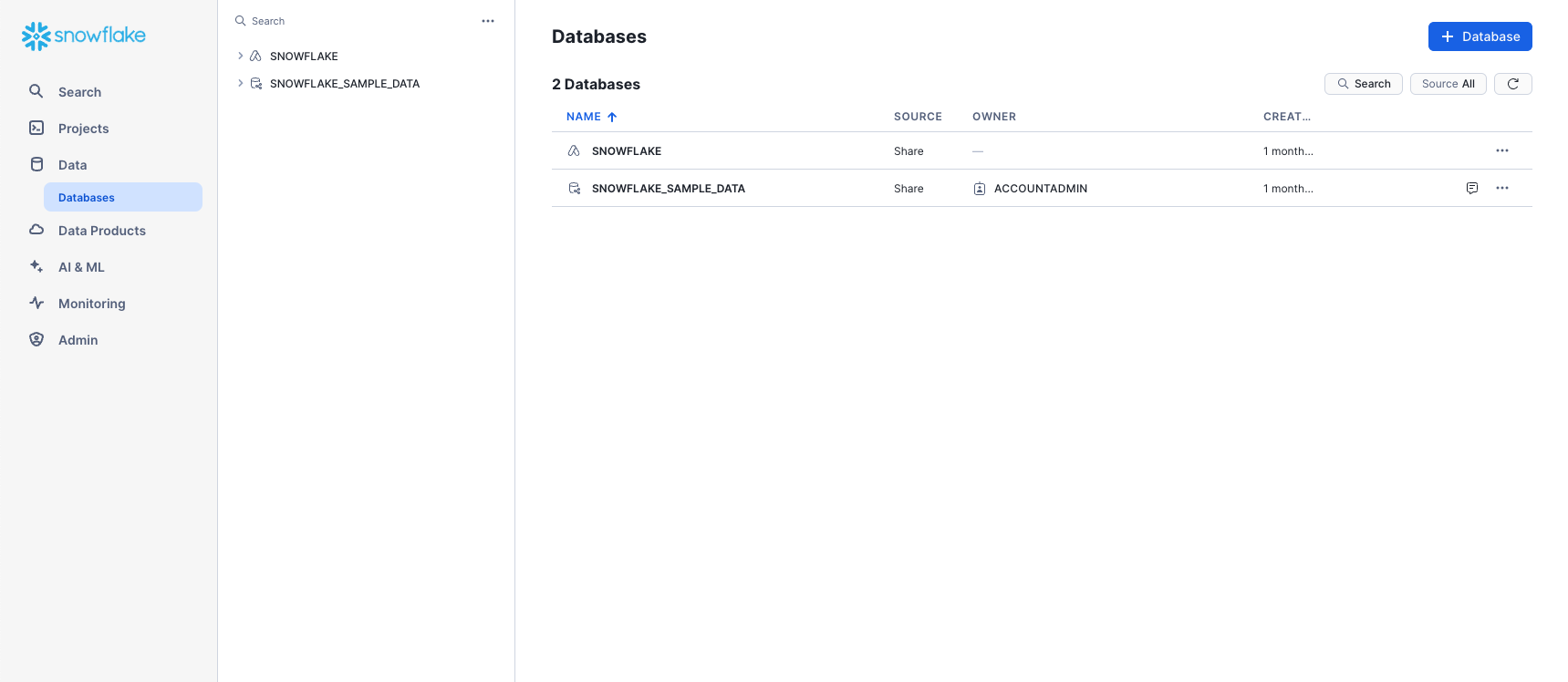
Data Products > Marketplace
The Marketplace tab is where any Snowflake customer can browse and consume data sets made available by providers. Click here to navigate direclty to the Marketplace.There are two types of shared data: Public and Personalized. Public data is free data sets available for querying instantaneously. Personalized data requires reaching out to the provider of data for approval of sharing data.
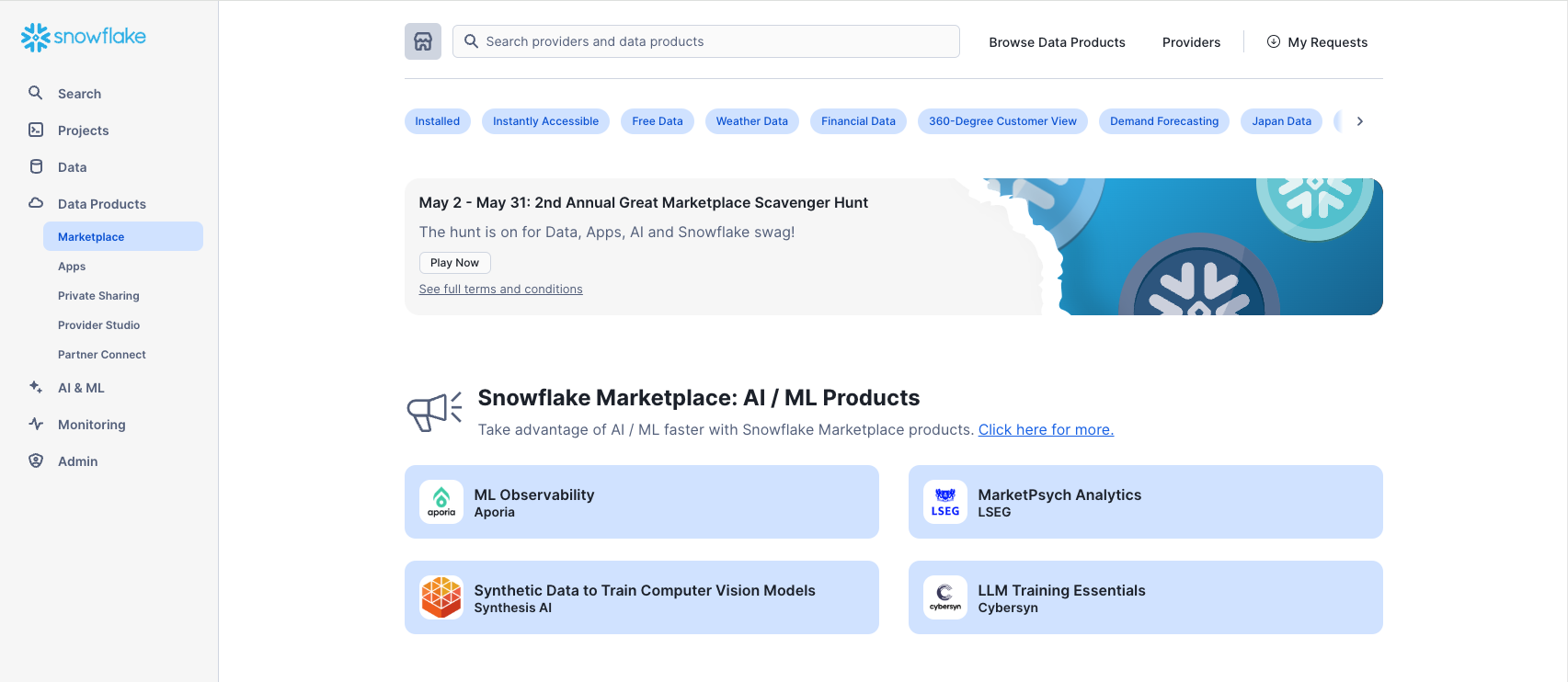
Data Products > Private Sharing
Under Data Products, the Private Sharing tab is where data sharing can be configured to easily and securely share Snowflake tables among separate Snowflake accounts or external users, without having to create a copy of the data. Browse directly to Private Sharing by clicking here.
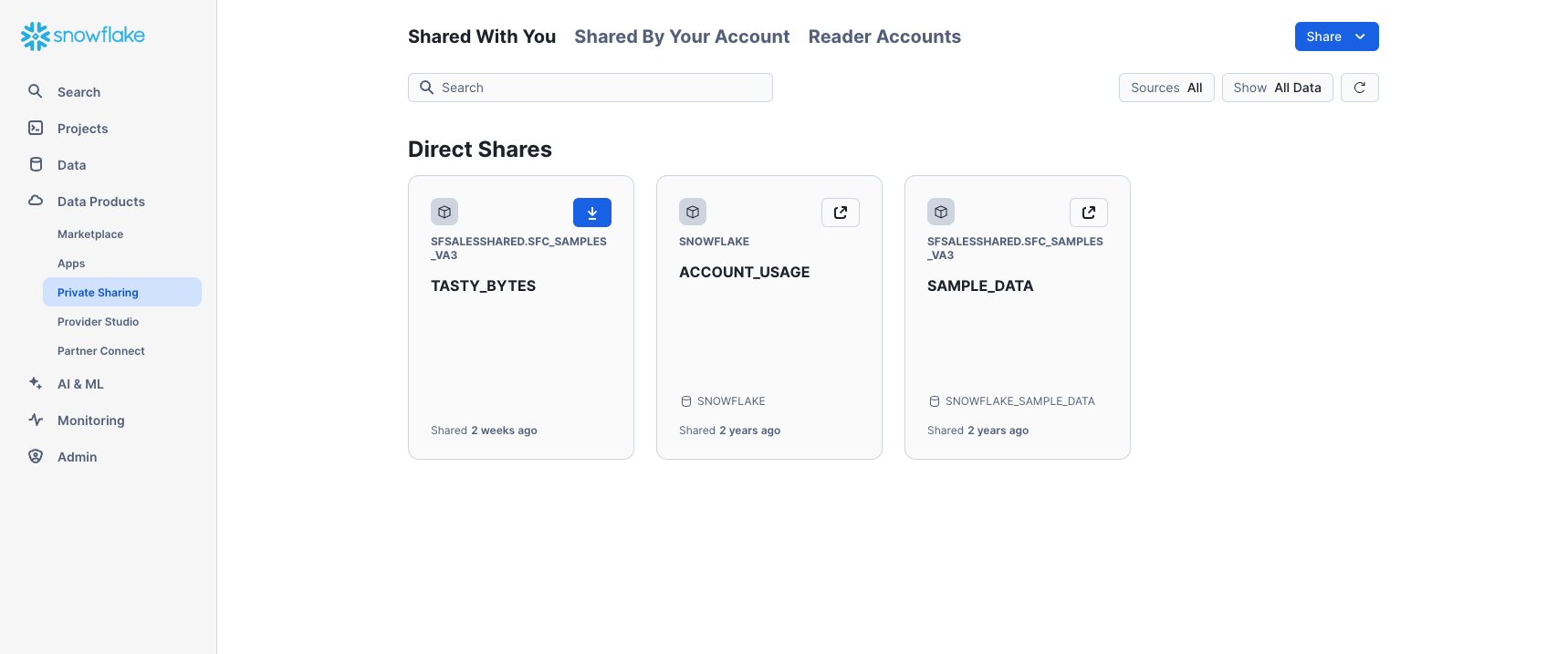
Monitoring > Query History
Under Monitoring there are multiple tabs for tracking your usage of your Snowflake account:
- Query History is where previous queries are shown, along with filters that can be used to hone results (user, warehouse, status, query tag, etc.). View the details of all queries executed in the last 14 days from your Snowflake account. Click a query ID to drill into it for more information.
- Copy History shows the status of copy commands run to ingest data into Snowflake.
- Task History allows you to see the execution history for tasks and tasks graphs. (Tasks let you schedule the execution of SQL code. It is associated with a specific database and schema.)
- Dynamic Tables is where you can use Snowsight to monitor dynamic table refreshes and examine dynamic tables and dynamic table graphs.
- Governance tracks row- and column-level security, object tagging, data classification, access history, and more.
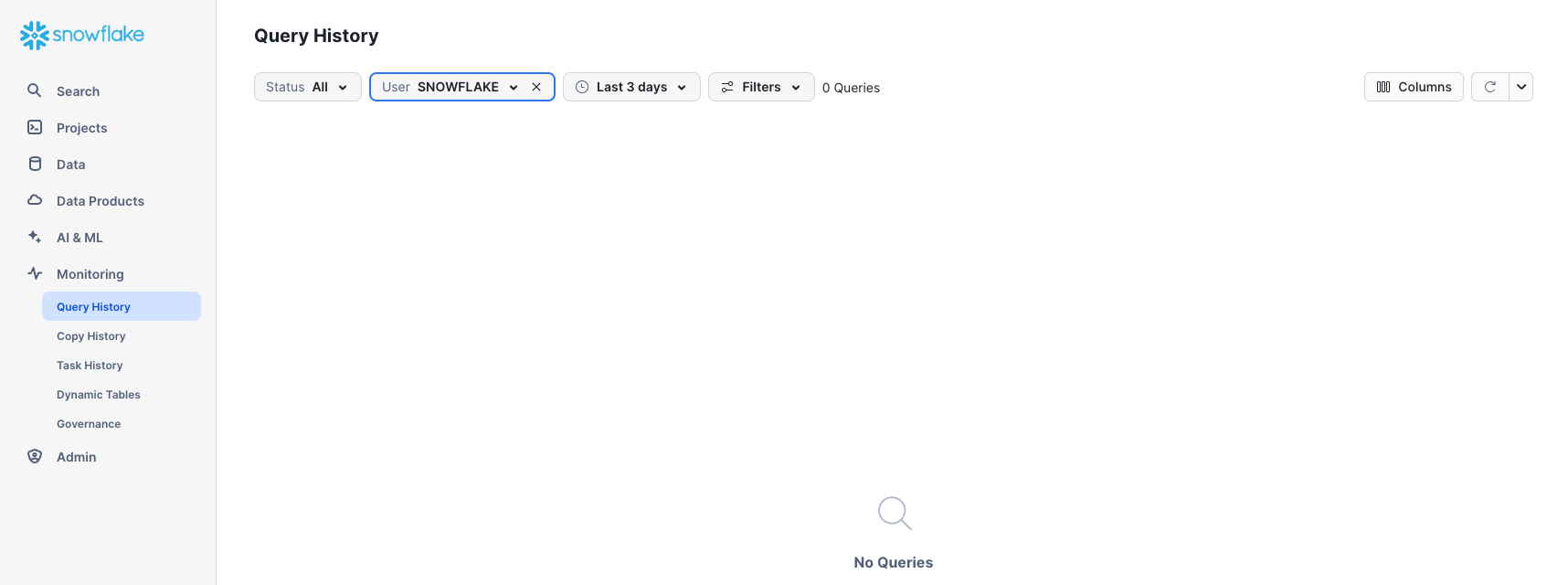
Admin > Warehouses
Under Admin, the Warehouses tab is where you set up and manage compute resources known as virtual warehouses to load or query data in Snowflake. A warehouse called COMPUTE_WH already exists in your environment. Click here to go directly to the Warehouses tab.
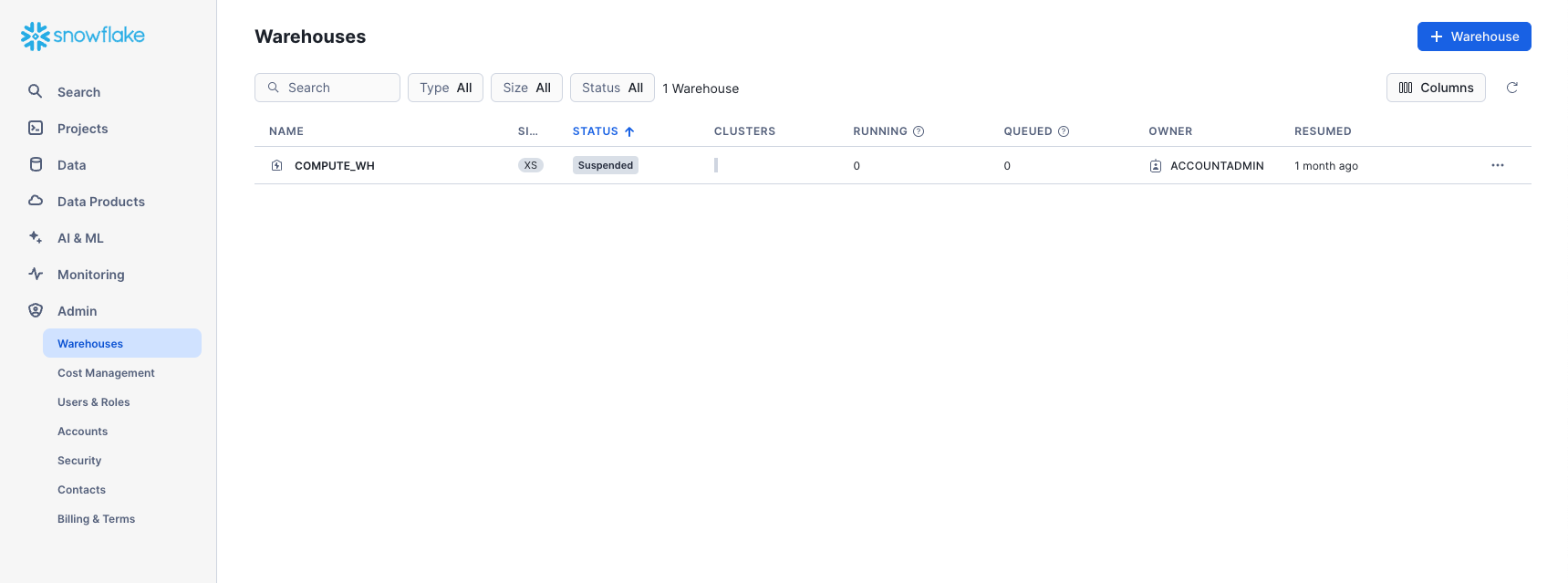
Admin > Cost Management
Under Admin, the Cost Management tab shows an overview of account consumption and budgets. It also includes details on all the resource monitors that have been created to control the number of credits that virtual warehouses consume. For each resource monitor, it shows the credit quota, type of monitoring, schedule, and actions performed when the virtual warehouse reaches its credit limit.
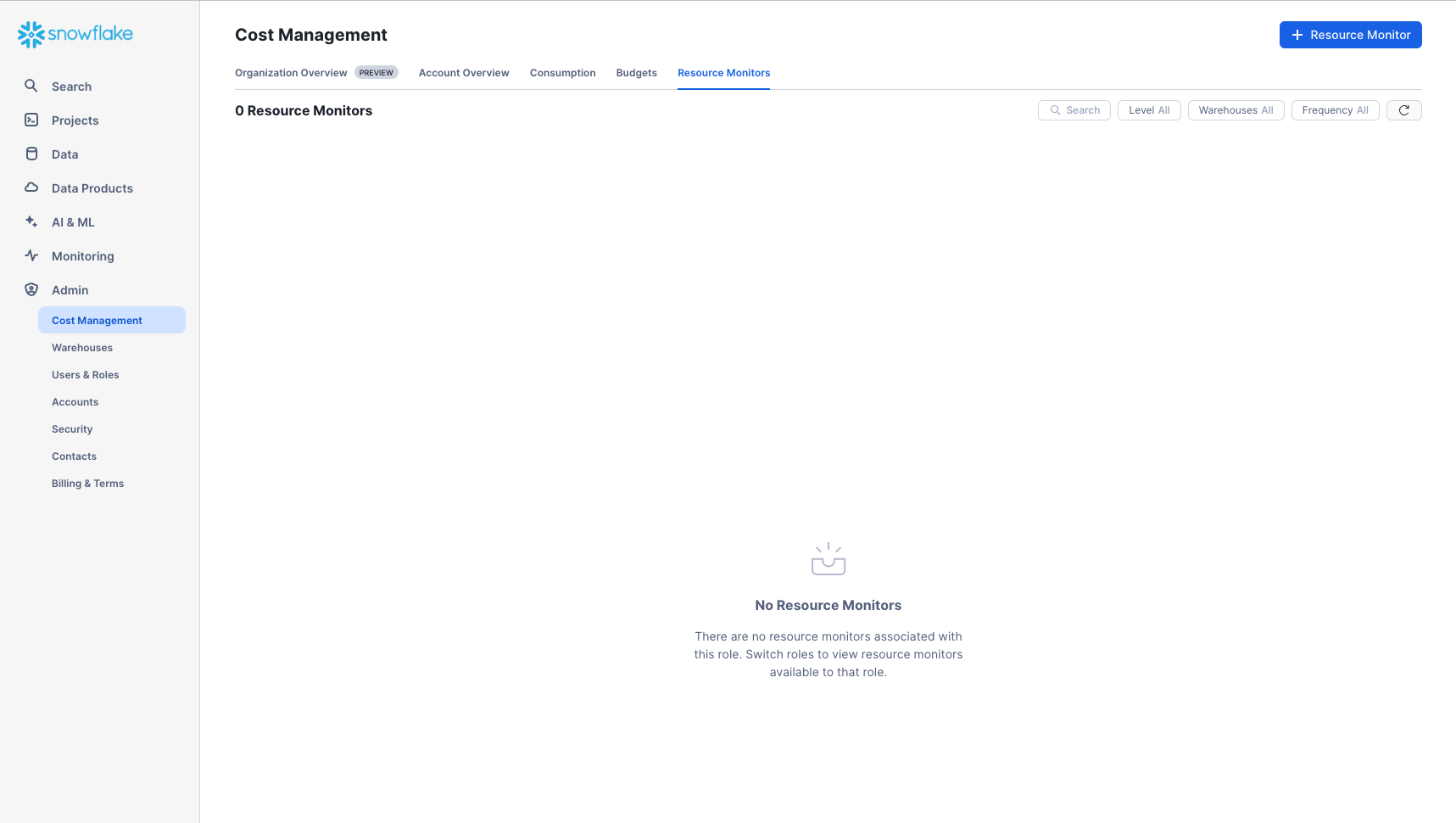
Admin > Users & Roles
The Roles sub-tab of the Users & Roles tab shows a list of the roles and their hierarchies. Roles can be created, reorganized, and granted to users in this tab. The roles can also be displayed in tabular/list format by selecting the Table sub-tab.
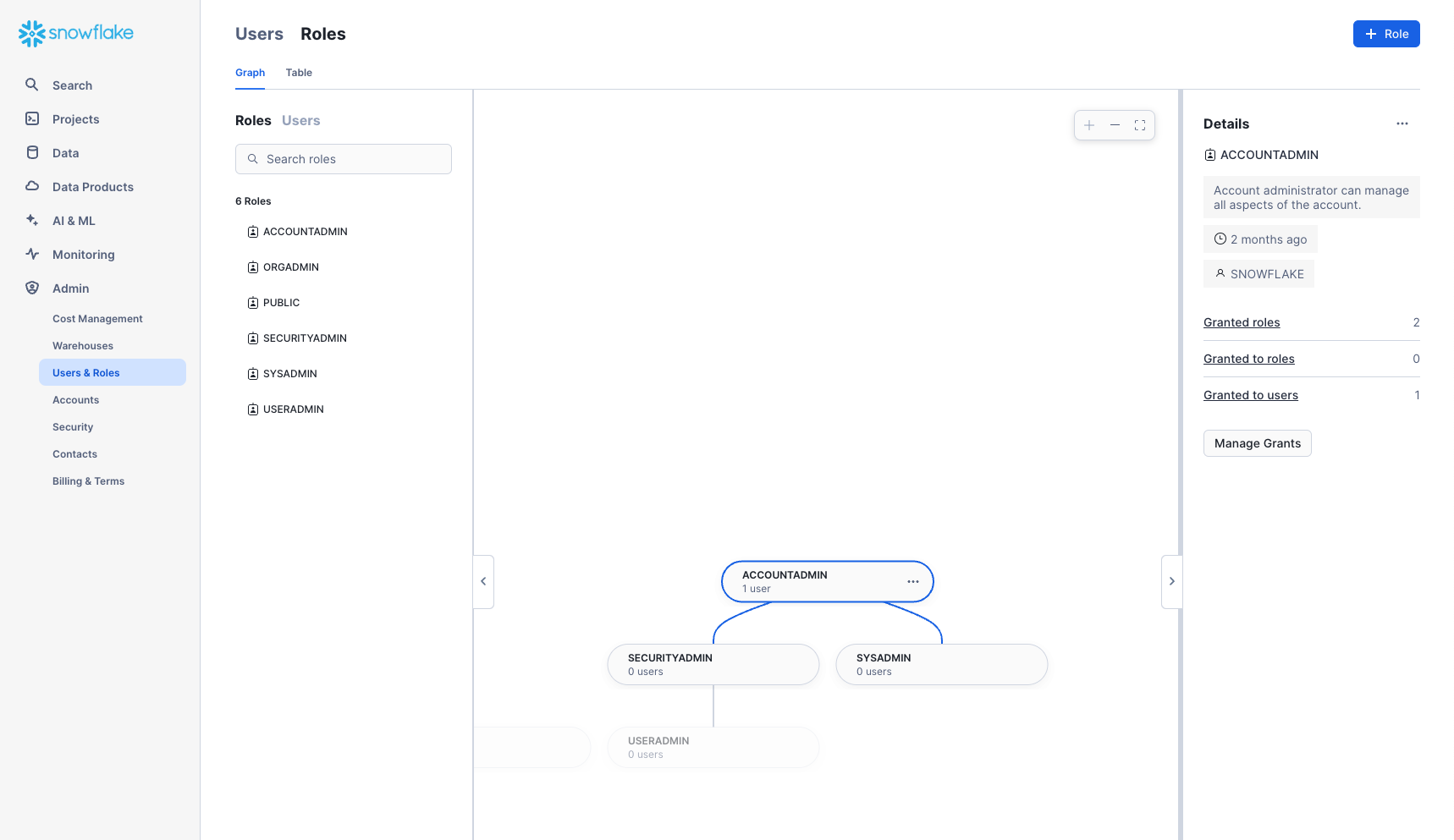
Users
The Users sub-tab of the Users & Roles tab shows a list of users in the account, default roles, and owner of the users. For a new account, no records are shown because no additional roles have been created. Permissions granted through your current role determine the information shown for this tab. To see all the information available on the tab, switch your role to ACCOUNTADMIN.
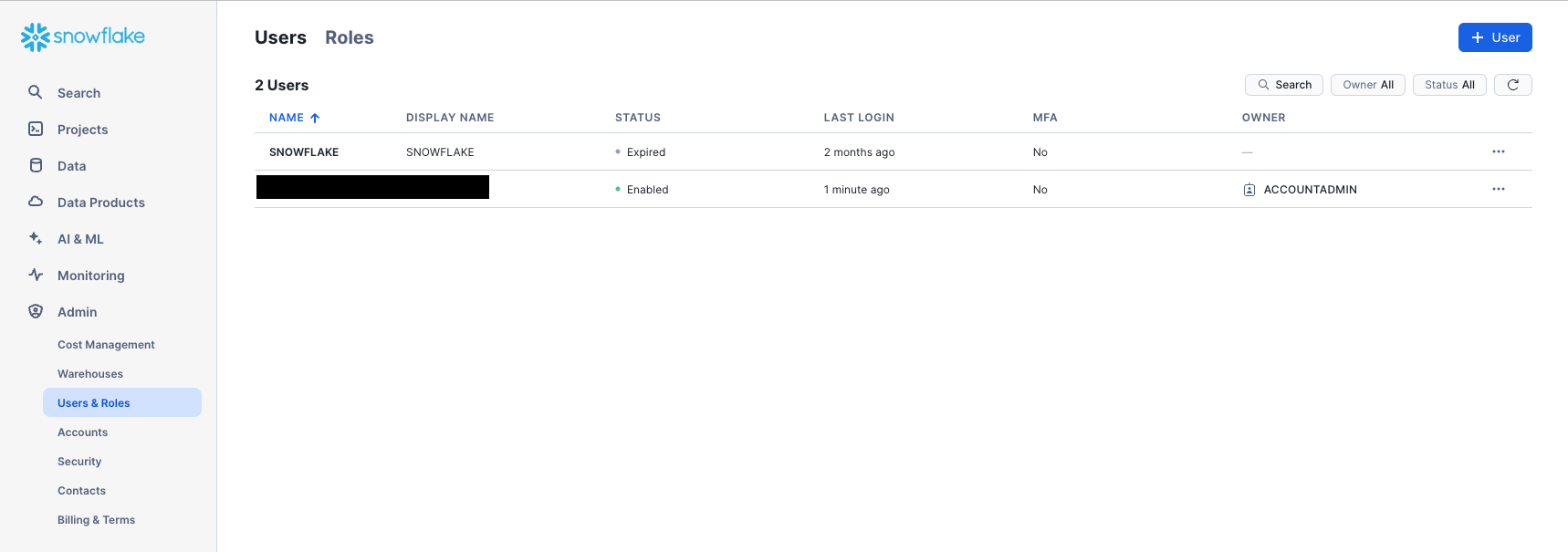
Clicking on your username in the bottom right of the UI allows you to change your password, roles, and preferences. Snowflake has several system defined roles. You are currently in the default role of SYSADMIN and will stay in this role for the majority of the lab.
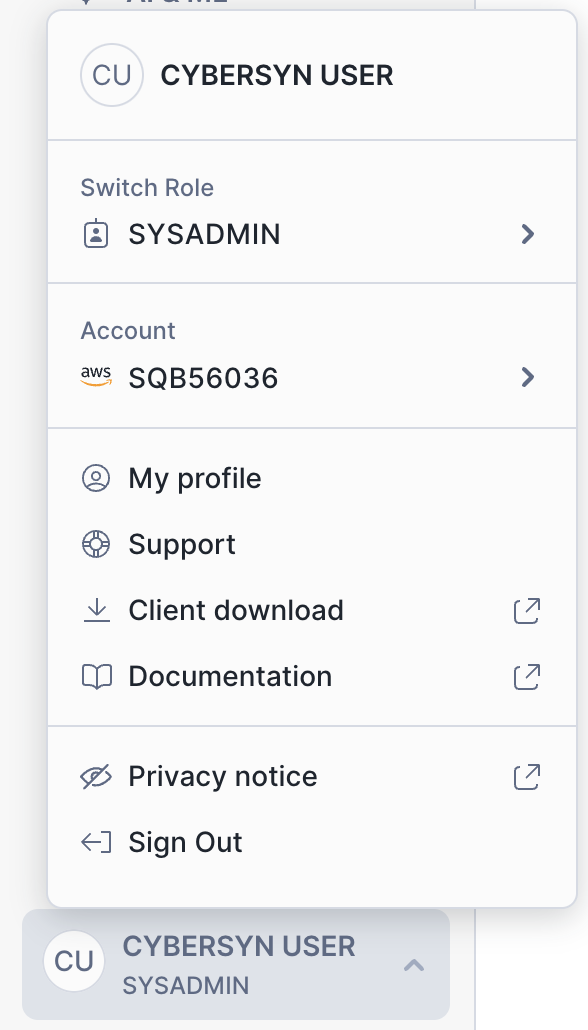
The Lab Story
You work at a grocery retailer. You want to understand the performance of major consumer goods (CPG) companies in the US that supply your store. This lab takes a look at daily stock price data and quarterly and annual Securities Exchange Commission (SEC) company filings to understand the performance of the CPG landscape. Public companies are required to submit a quarterly and annual report to the SEC detailing their financial data.
We will start by collecting data from three different sources:
- Load company metadata
.csvfile. - Load SEC filings from a semi-structured JSON format.
- Use the Snowflake Marketplace to find free stock price data in "Snowflake Public Data (Free)" from Snowflake Public Data.
Let's start by preparing to load structured .csv data into Snowflake.
We are using company metadata developed from the Securities and Exchange Commission (SEC) that details the consumer packaged goods (CPG) companies we want to evaluate. The data has been exported and pre-staged for you in an Amazon AWS S3 bucket in the US-EAST region. It is in comma-delimited format with a single header line and double quotes enclosing all string values, including the field headings in the header line. This will be important when we configure the Snowflake table to store this data.
Getting Data into Snowflake Data can be ingested into Snowflake from many locations by using the COPY command, Snowpipe auto-ingestion, external connectors, or third-party ETL/ELT solutions. For more information on getting data into Snowflake, see the Snowflake documentation. For the purposes of this lab, we use the COPY command and AWS S3 storage to load data manually. In a real-world scenario, you would more likely use an ETL solution or grab data directly from the Snowflake Marketplace!
Create a Database and Table
Ensure you are using the SYSADMIN role by selecting your name at the top left, Switch Role > SYSADMIN.
Navigate to the Databases tab. Click Create, name the database Public_Data, then click CREATE.
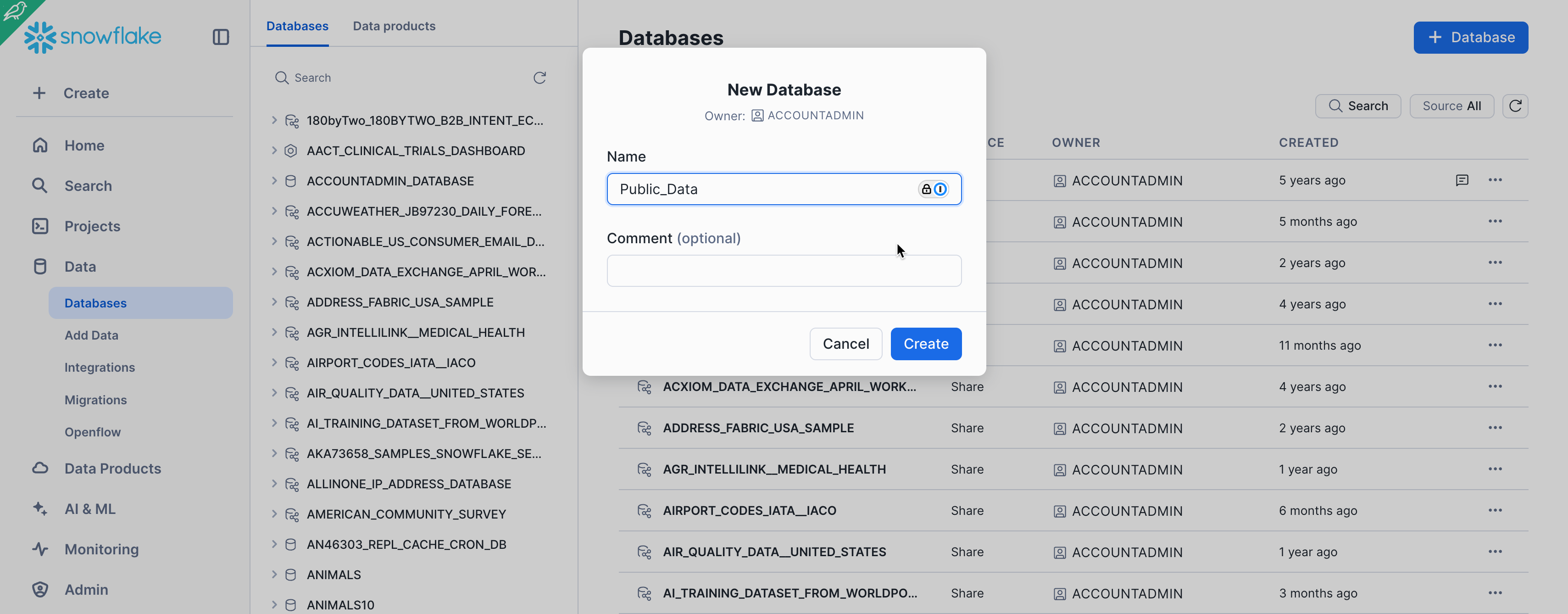
Now navigate to the Worksheets tab. You should see the worksheet we created in step 3.

We need to set the context appropriately within the worksheet. In the upper right corner of the worksheet, click the box to the left of the Share button to show the context menu. Here we control the elements you can see and run from each worksheet. We are using the UI here to set the context. Later in the lab, we will accomplish the same thing via SQL commands within the worksheet.
Select the following context settings:
Role: SYSADMINWarehouse: COMPUTE_WH
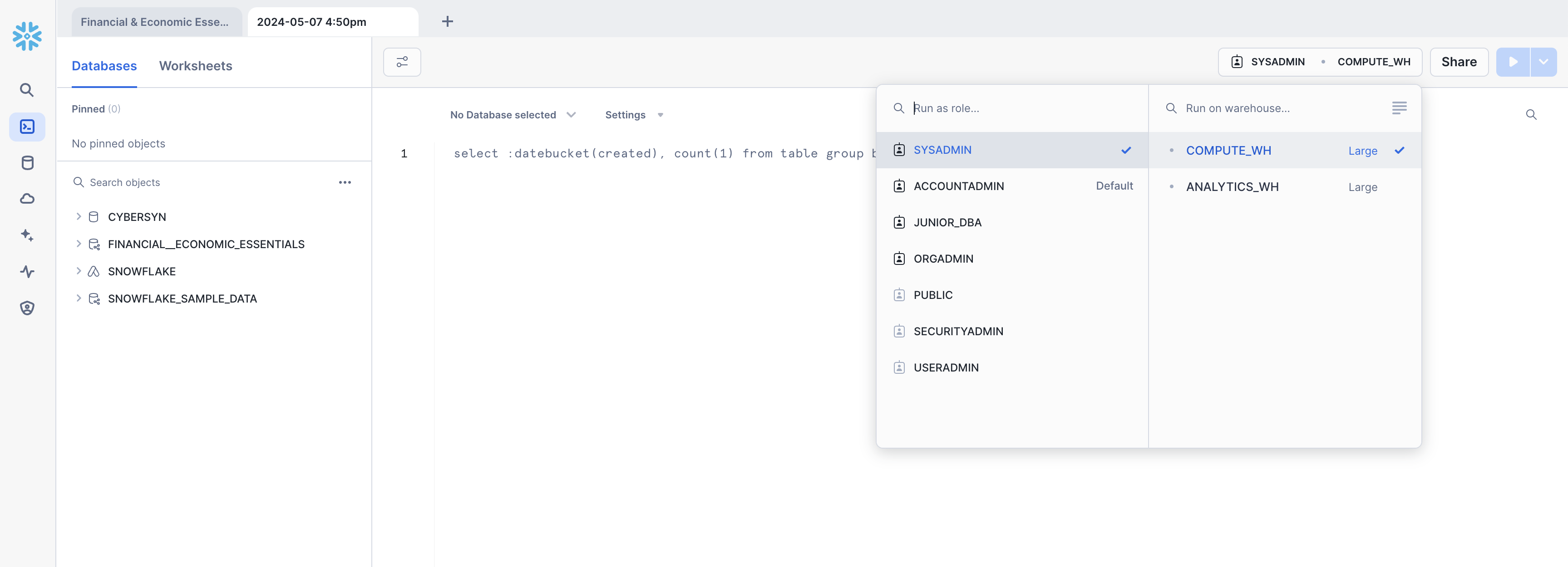
Next, in the drop-down for the database, select the following context settings:
Database: Public_DataSchema: PUBLIC
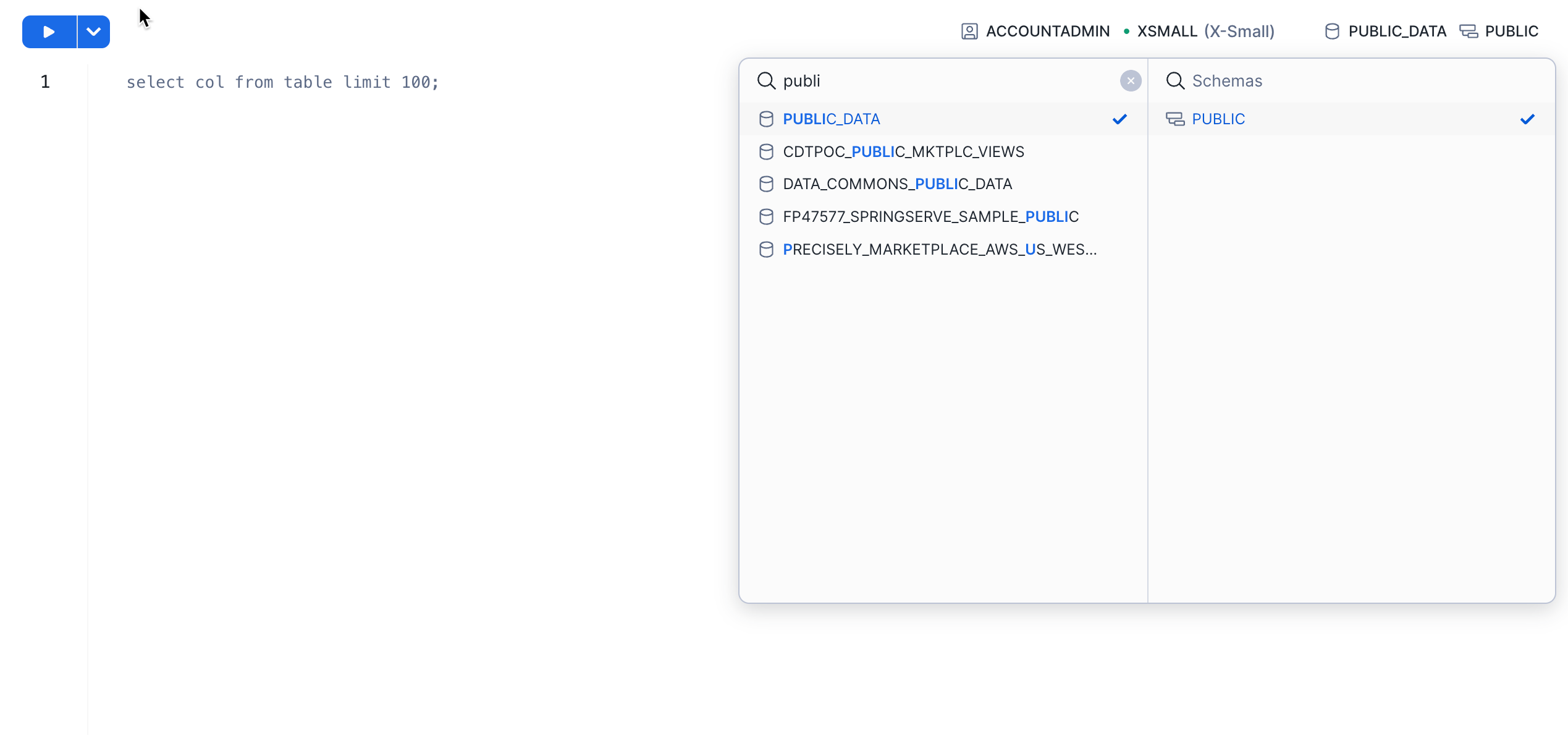
To make working in the worksheet easier, let's rename it. In the top left corner, double-click the worksheet name, which is the timestamp when the worksheet was created, and change it to ZERO_TO_SNOWFLAKE_WITH_PUBLIC_DATA.
Next we create a table called COMPANY_METADATA to use for loading the comma-delimited data. Instead of using the UI, we use the worksheet to run the DDL that creates the table. Copy the following SQL text into your worksheet:
CREATE OR REPLACE TABLE company_metadata
(cybersyn_company_id string,
company_name string,
permid_security_id string,
primary_ticker string,
security_name string,
asset_class string,
primary_exchange_code string,
primary_exchange_name string,
security_status string,
global_tickers variant,
exchange_code variant,
permid_quote_id variant);
Run the query by placing your cursor anywhere in the SQL text and clicking the blue Play/Run button in the top right of the worksheet. Or use the keyboard shortcut [Ctrl]/[Cmd]+[Enter].
Verify your COMPANY_METADATA table has been created. At the bottom of the worksheet, you should see a Results section displaying a "Table COMPANY_METADATA successfully created" message.
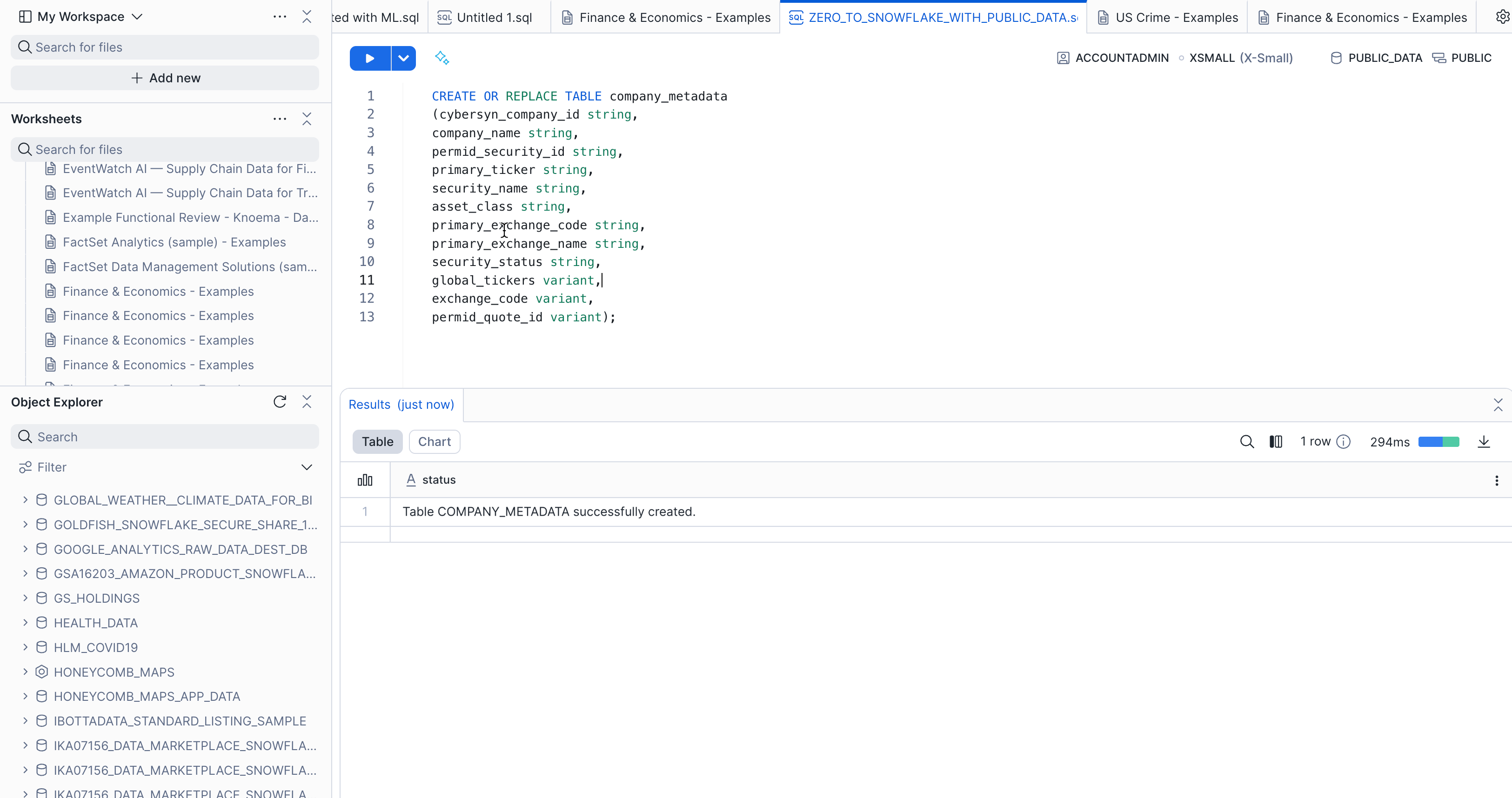
Navigate to the Databases tab by clicking the HOME icon in the upper left corner of the worksheet. Then click Data > Databases. In the list of databases, click Public_Data > PUBLIC > TABLES to see your newly created COMPANY_METADATA table. If you don't see any databases on the left, expand your browser because they may be hidden.
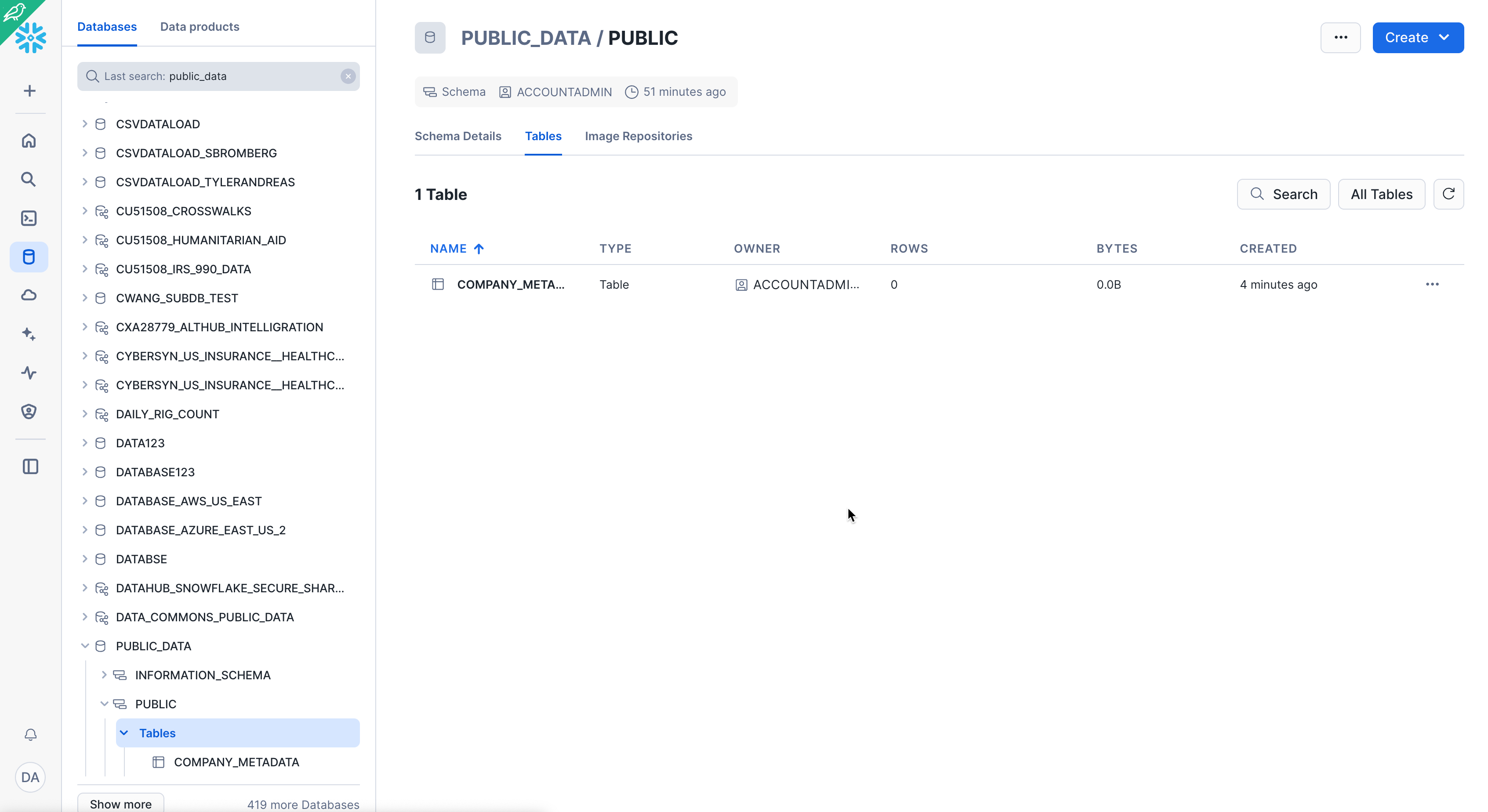
Click COMPANY_METADATA and the Columns tab to see the table structure you just created.
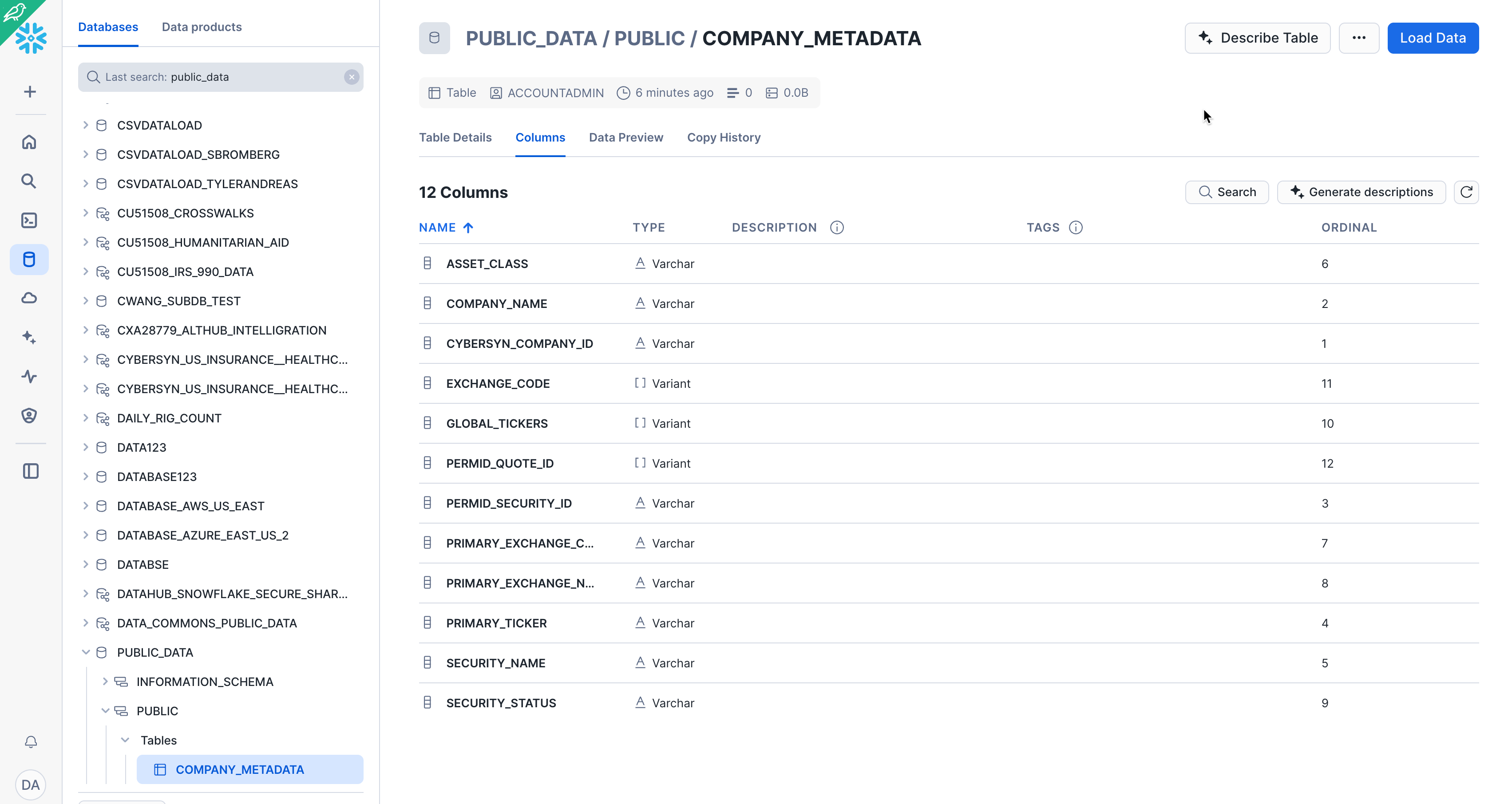
Create an External Stage
We are working with structured, comma-delimited data that has already been staged in a public, external S3 bucket. Before we can use this data, we first need to create a stage that specifies the location of our external bucket.
From the Databases tab, click the Public_Data database and PUBLIC schema. Click the Create button, then Stage > Amazon S3.
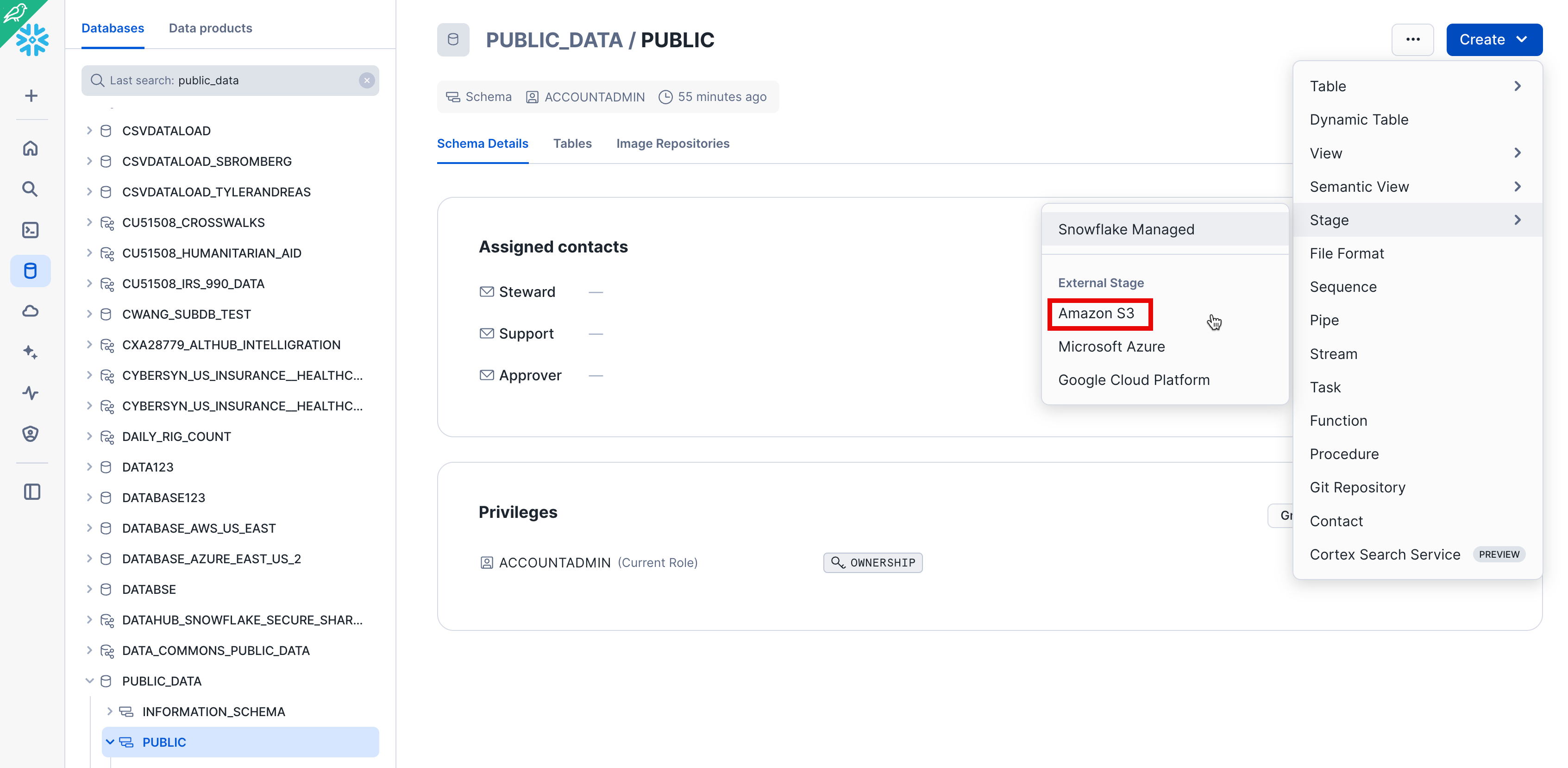
In the Create Stage dialog that opens, replace the following values in the SQL statement:
Stage Name: Public_Data_company_metadataURL: s3://sfquickstarts/zero_to_snowflake/cybersyn-consumer-company-metadata-csv/
Note: Make sure to include the final forward slash (/) at the end of the URL or you will encounter errors later when loading data from the bucket. Also ensure you have removed ‘credentials = (...)' statement which is not required. You can also comment it out like the picture below by using ‘–'. The create stage command should resemble the below picture or not include the 3rd line.
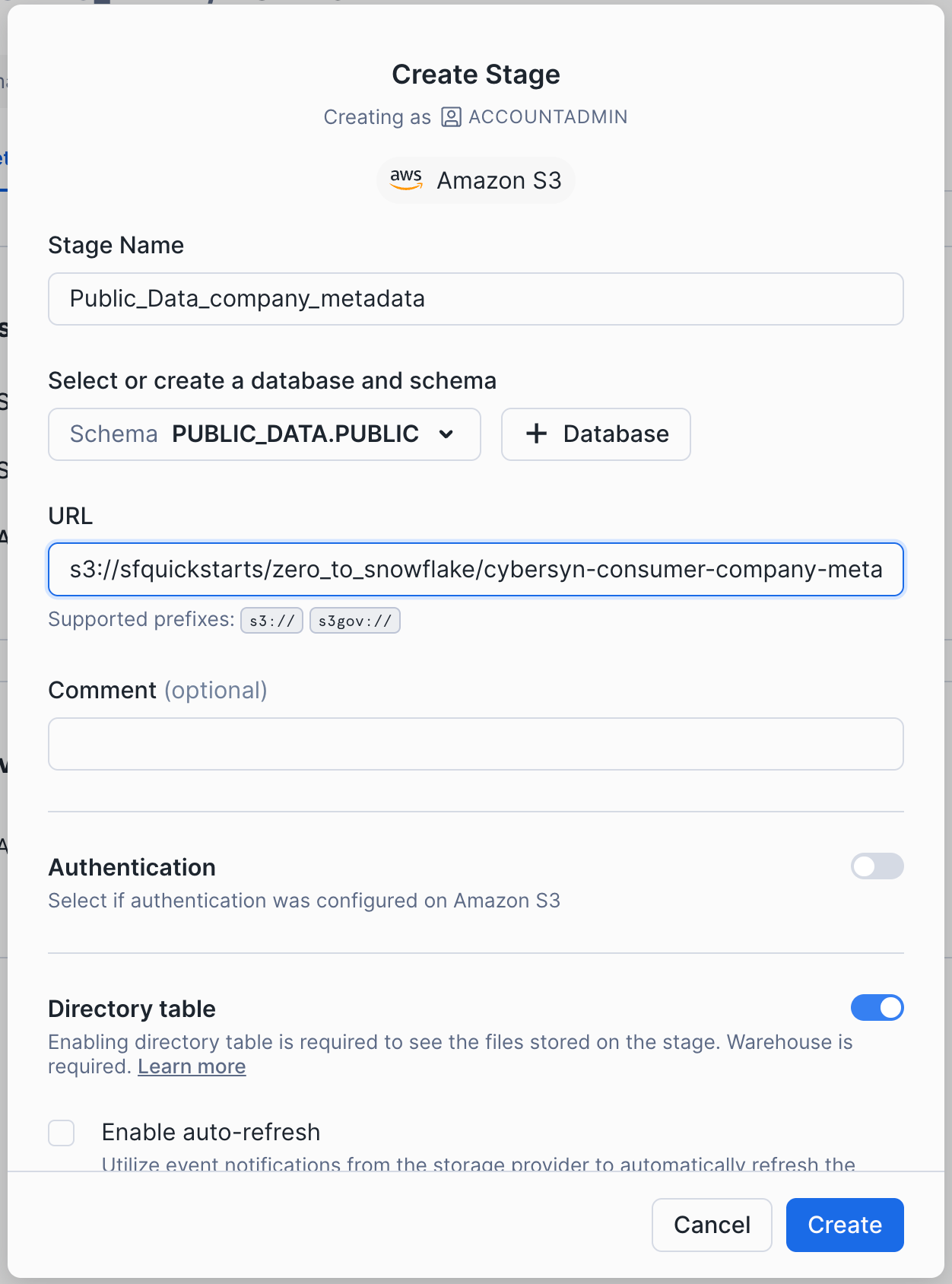
Now let's take a look at the contents of the Public_Data_company_metadata stage. Navigate back to the Worksheets tab and open the ZERO_TO_SNOWFLAKE_WITH_Public_Data worksheet we made.
Add the following SQL statement below the previous code and then execute:
LIST @Public_Data_company_metadata;
In the results in the bottom pane, you should see the list of files in the stage:
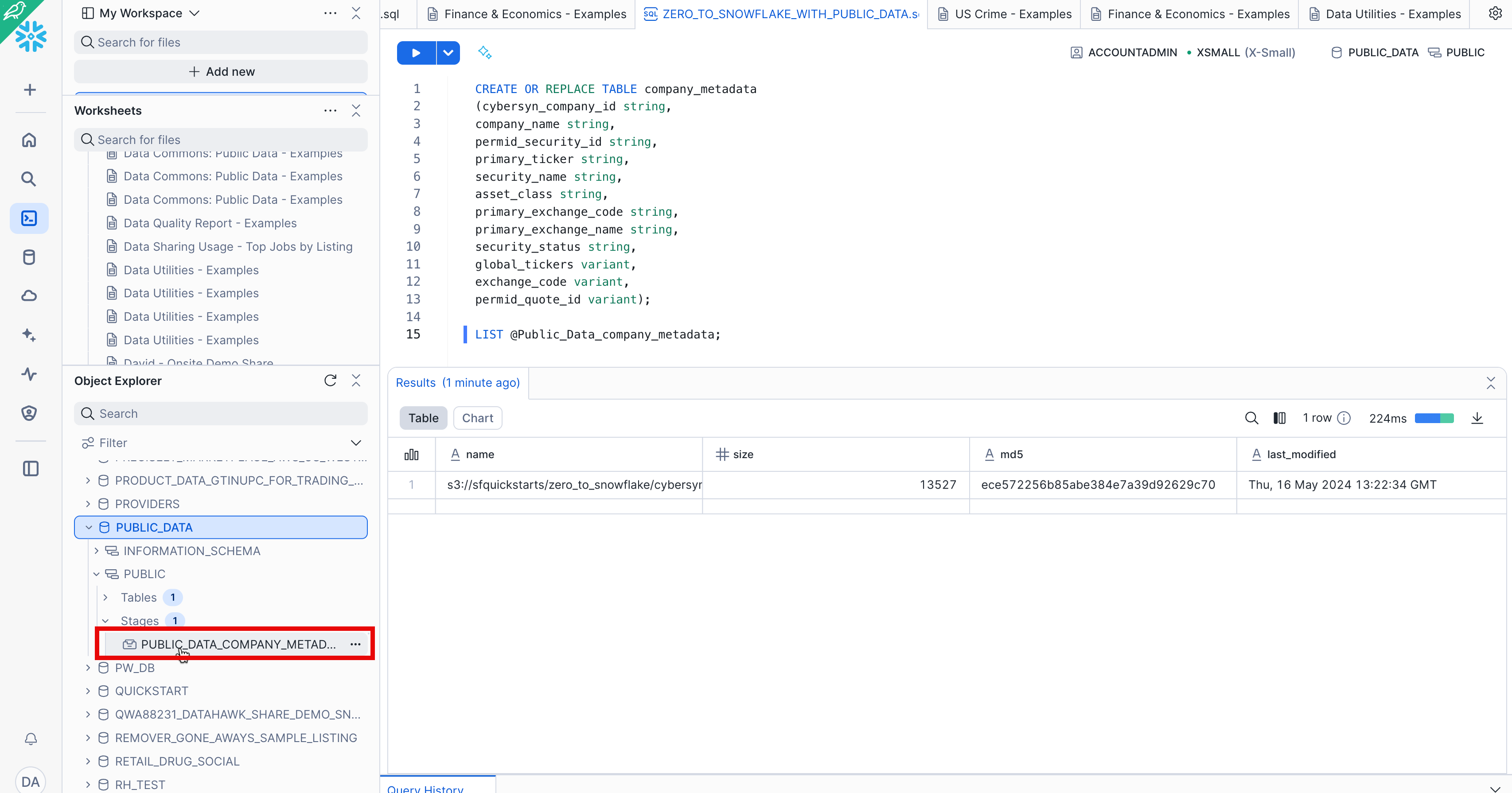
Create a File Format
Before we can load the data into Snowflake, we have to create a file format that matches the data structure. In the worksheet, again add the following command below the rest and execute to create the file format:
CREATE OR REPLACE FILE FORMAT csv
TYPE = 'CSV'
COMPRESSION = 'AUTO' -- Automatically determines the compression of files
FIELD_DELIMITER = ',' -- Specifies comma as the field delimiter
RECORD_DELIMITER = '\n' -- Specifies newline as the record delimiter
SKIP_HEADER = 1 -- Skip the first line
FIELD_OPTIONALLY_ENCLOSED_BY = '\042' -- Fields are optionally enclosed by double quotes (ASCII code 34)
TRIM_SPACE = FALSE -- Spaces are not trimmed from fields
ERROR_ON_COLUMN_COUNT_MISMATCH = FALSE -- Does not raise an error if the number of fields in the data file varies
ESCAPE = 'NONE' -- No escape character for special character escaping
ESCAPE_UNENCLOSED_FIELD = '\134' -- Backslash is the escape character for unenclosed fields
DATE_FORMAT = 'AUTO' -- Automatically detects the date format
TIMESTAMP_FORMAT = 'AUTO' -- Automatically detects the timestamp format
NULL_IF = ('') -- Treats empty strings as NULL values
COMMENT = 'File format for ingesting data for zero to snowflake';
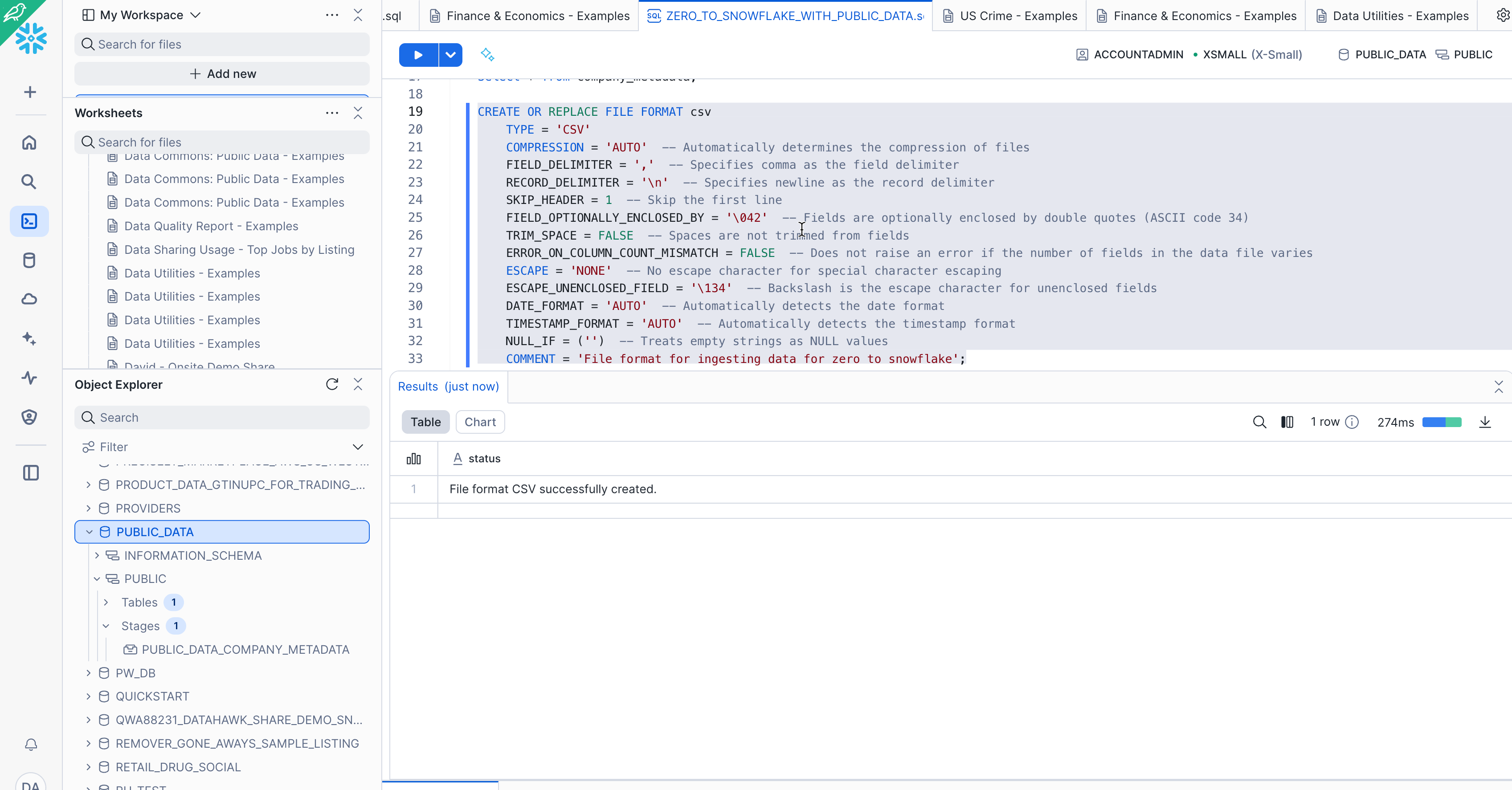
Verify the file format has been created with the correct settings by executing the following command:
SHOW FILE FORMATS IN DATABASE Public_Data;
The file format created should be listed in the result: 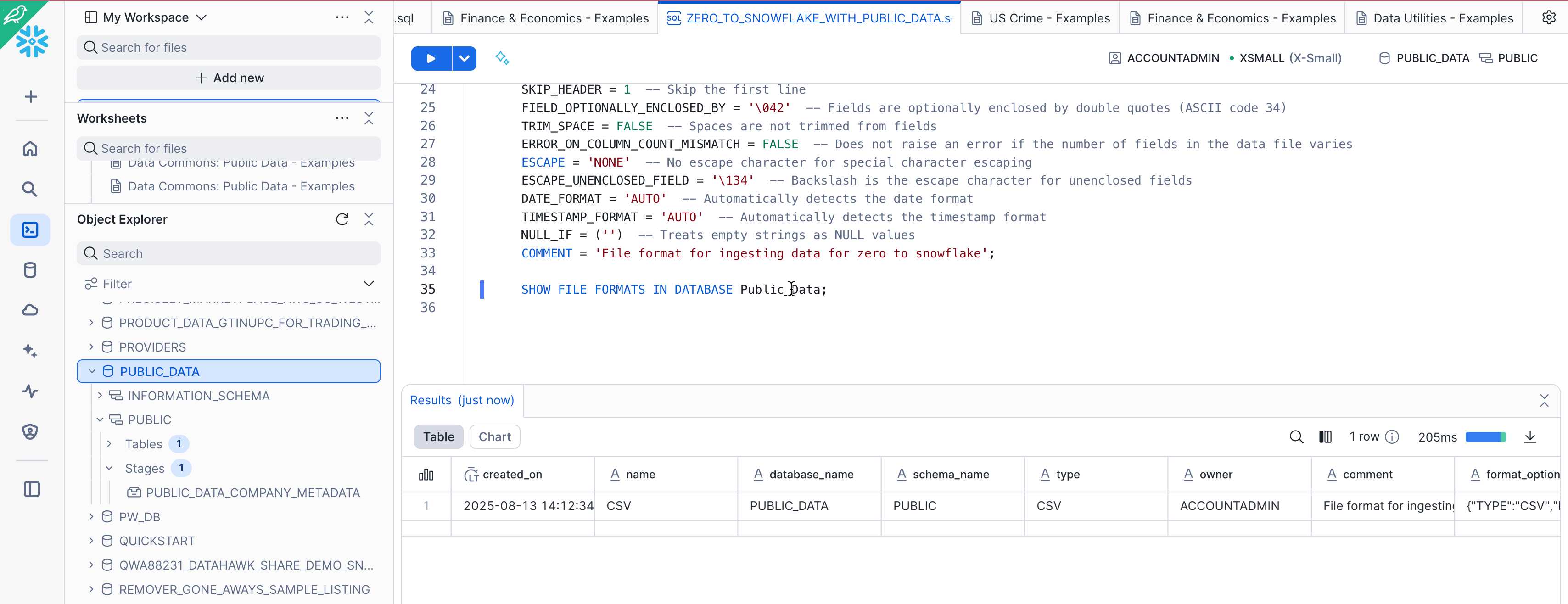
Resize and Use a Warehouse for Data Loading
We will now use a virtual warehouse and the COPY command to initiate bulk loading of structured data into the Snowflake table we created.
Compute resources are needed for loading data. Snowflake's compute nodes are called virtual warehouses and they can be dynamically sized up or out according to workload, whether you are loading data, running a query, or performing a DML operation. Each workload can have its own warehouse so there is no resource contention.
Navigate to the Warehouses tab (under Admin). This is where you can view all of your existing warehouses, as well as analyze their usage trends.
Note the + Warehouse option in the upper right corner of the top. This is where you can quickly add a new warehouse. However, we want to use the existing warehouse COMPUTE_WH included in the 30-day trial environment.
Click the row of the COMPUTE_WH warehouse. Then click the [...] in the upper right corner text above it to see the actions you can perform on the warehouse. We will use this warehouse to load the data from AWS S3.
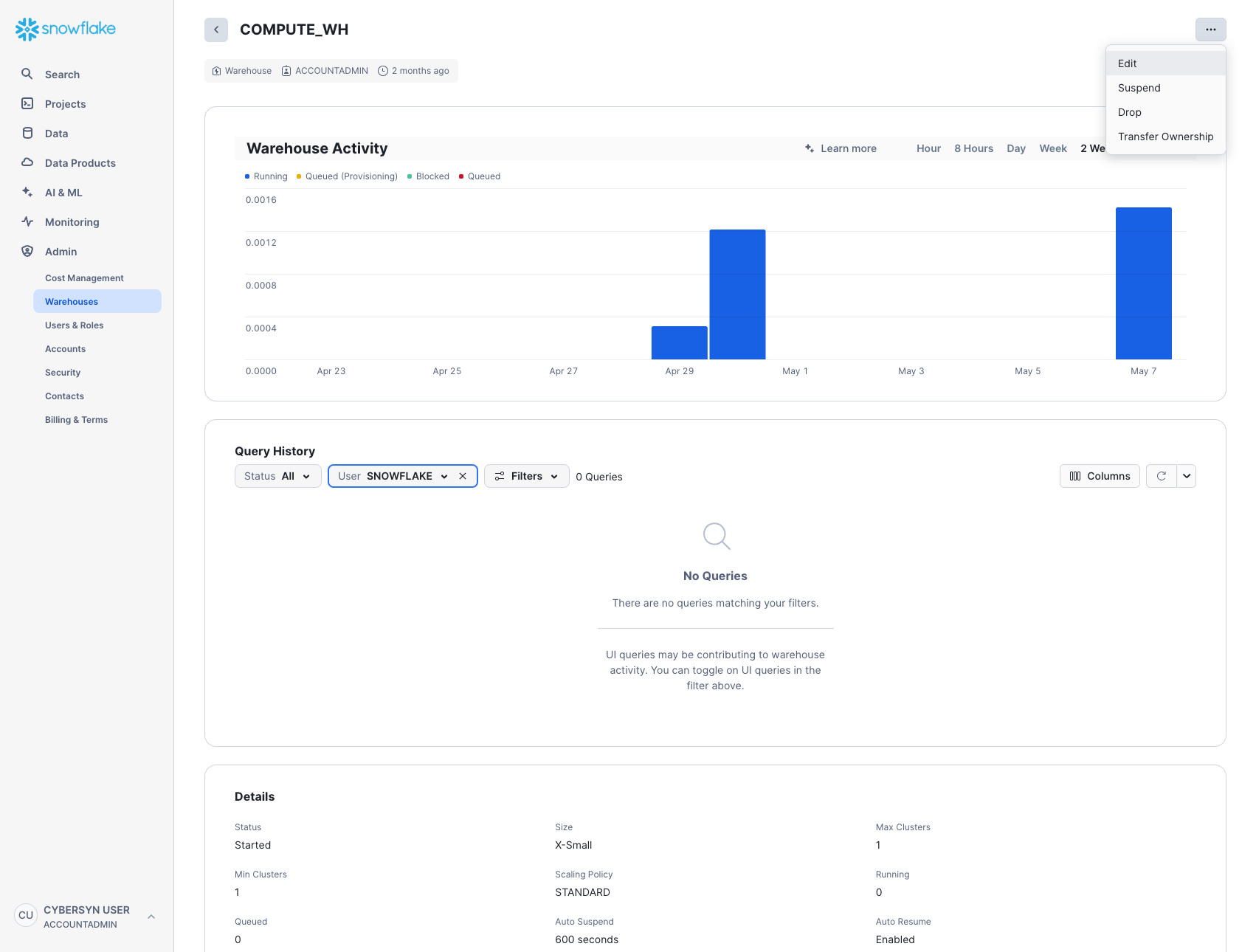
Click Edit to walk through the options of this warehouse and learn some of Snowflake's unique functionality.
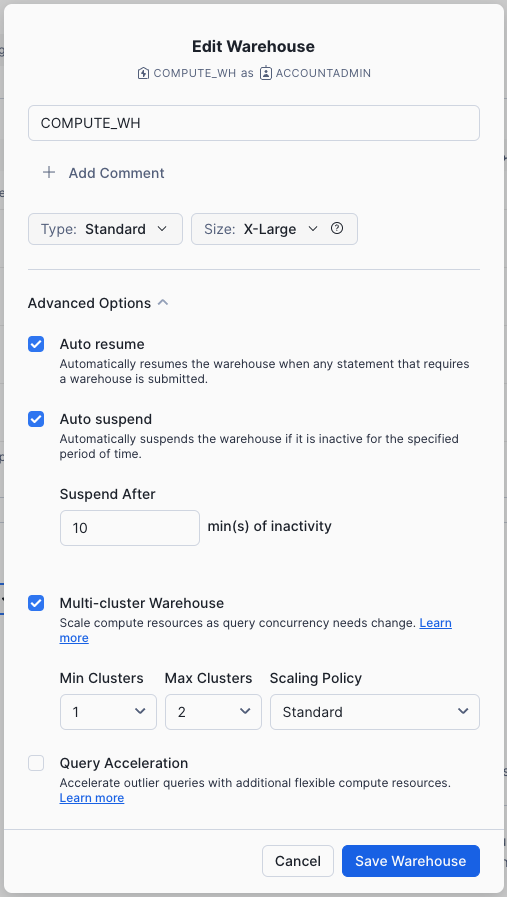
- The Size drop-down is where the capacity of the warehouse is selected. For larger data loading operations or more compute-intensive queries, a larger warehouse is recommended. The sizes translate to the underlying compute resources provisioned from the cloud provider (AWS, Azure, or GCP) where your Snowflake account is hosted. It also determines the number of credits consumed by the warehouse for each full hour it runs. The larger the size, the more compute resources from the cloud provider are allocated to the warehouse and the more credits it consumes. For example, the
4X-Largesetting consumes 128 credits for each full hour. This sizing can be changed up or down at any time with a simple click. - If you are using Snowflake Enterprise Edition (or higher) the Query Acceleration option is available. When it is enabled for a warehouse, it can improve overall warehouse performance by reducing the impact of outlier queries, which are queries that use more resources than the typical query. Leave this disabled
- If you are using Snowflake Enterprise Edition (or higher) and the Multi-cluster Warehouse option is enabled, you will see additional options. This is where you can set up a warehouse to use multiple clusters of compute resources, up to 10 clusters. For example, if a
4X-Largemulti-cluster warehouse is assigned a maximum cluster size of 10, it can scale out to 10 times the compute resources powering that warehouse...and it can do this in seconds! However, note that this will increase the number of credits consumed by the warehouse to 1280 if all 10 clusters run for a full hour (128 credits/hour x 10 clusters). Multi-cluster is ideal for concurrency scenarios, such as many business analysts simultaneously running different queries using the same warehouse. In this use case, the various queries are allocated across multiple clusters to ensure they run quickly. - Under Advanced Warehouse Options, the options allow you to automatically suspend the warehouse when not in use so no credits are needlessly consumed. There is also an option to automatically resume a suspended warehouse so when a new workload is sent to it, it automatically starts back up. This functionality enables Snowflake's efficient "pay only for what you use" billing model which allows you to scale your resources when necessary and automatically scale down or turn off when not needed, nearly eliminating idle resources. Additionally, there is an option to change the Warehouse type from Standard to Snowpark-optimized. Snowpark-optmized warehouses provide 16x memory per node and are recommended for workloads that have large memory requirements such as ML training use cases using a stored procedure on a single virtual warehouse node. Leave this type as Standard
Warning - Watch Your Spend! During or after this lab, you should be careful about performing the following actions without good reason or you may burn through your $400 of free credits more quickly than desired:
- Do not disable auto-suspend. If auto-suspend is disabled, your warehouses continues to run and consume credits even when not in use.
- Do not use a warehouse size that is excessive given the workload. The larger the warehouse, the more credits are consumed.
We are going to use this virtual warehouse to load the structured data in the CSV files (stored in the AWS S3 bucket) into Snowflake. However, we are first going to change the size of the warehouse to increase the compute resources it uses. After the load, note the time taken and then, in a later step in this section, we will re-do the same load operation with an even larger warehouse, observing its faster load time.
Change the Size of this data warehouse from X-Small to Small. then click the Save Warehouse button:
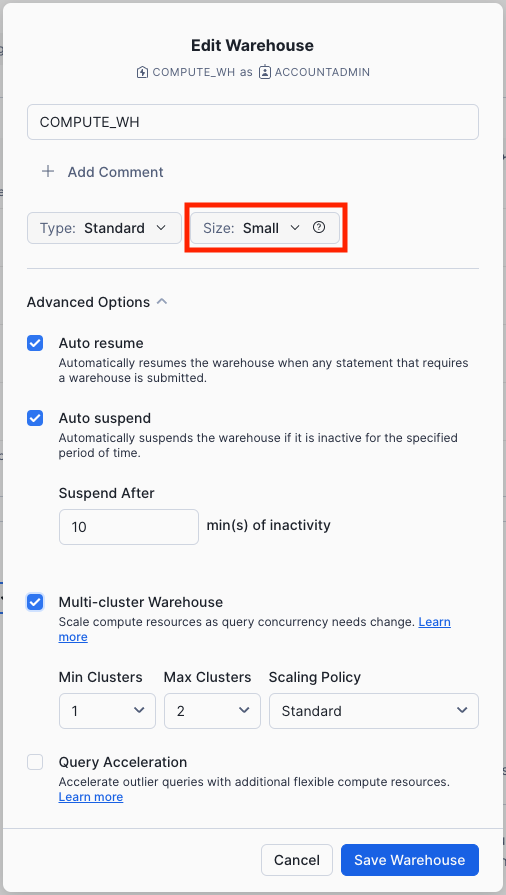
Load the Data
Now we can run a COPY command to load the data into the COMPANY_METADATA table we created earlier.
Navigate back to the ZERO_TO_SNOWFLAKE_WITH_PUBLIC_DATA worksheet in the Worksheets tab. Make sure the worksheet context is correctly set:
Role: SYSADMINWarehouse: COMPUTE_WHDatabase: Public_DataSchema: PUBLIC
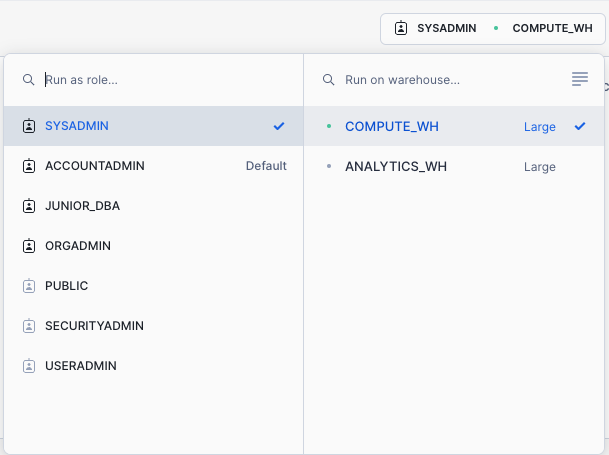
Execute the following statements in the worksheet to load the staged data into the table. This may take up to 30 seconds.
COPY INTO company_metadata FROM @Public_Data_company_metadata file_format=csv PATTERN = '.*csv.*' ON_ERROR = 'CONTINUE';
In the result pane, you should see the status of each file that was loaded. Once the load is done, in the Query Details pane on the bottom right, you can scroll through the various statuses, error statistics, and visualizations for the last statement executed.
Next, navigate to the Query History tab by clicking the Home icon and then Activity > Query History. Select the query at the top of the list, which should be the COPY INTO statement that was last executed. Select the Query Profile tab and note the steps taken by the query to execute, query details, most expensive nodes, and additional statistics.
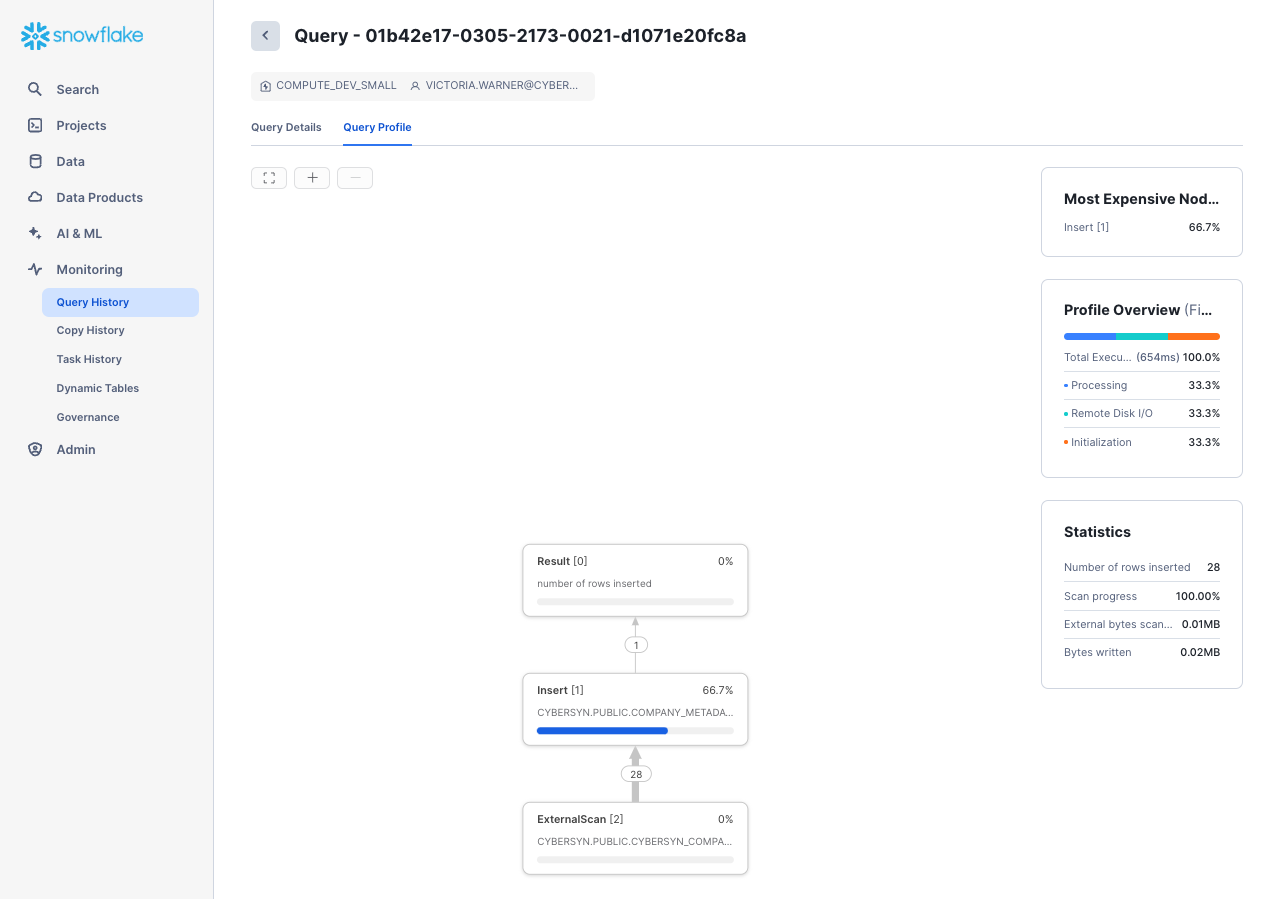
Now let's reload the COMPANY_METADATA table with a larger warehouse to see the impact the additional compute resources have on the loading time.
Go back to the worksheet and use the TRUNCATE TABLE command to clear the table of all data and metadata:
TRUNCATE TABLE company_metadata;
-- Verify that the table is empty by running the following command:
SELECT * FROM company_metadata LIMIT 10;
The result should show Query produced no results. Change the warehouse size to LARGE using the following ALTER WAREHOUSE:
ALTER WAREHOUSE compute_wh SET warehouse_size='large';
-- Verify the change using the following SHOW WAREHOUSES:
SHOW WAREHOUSES;
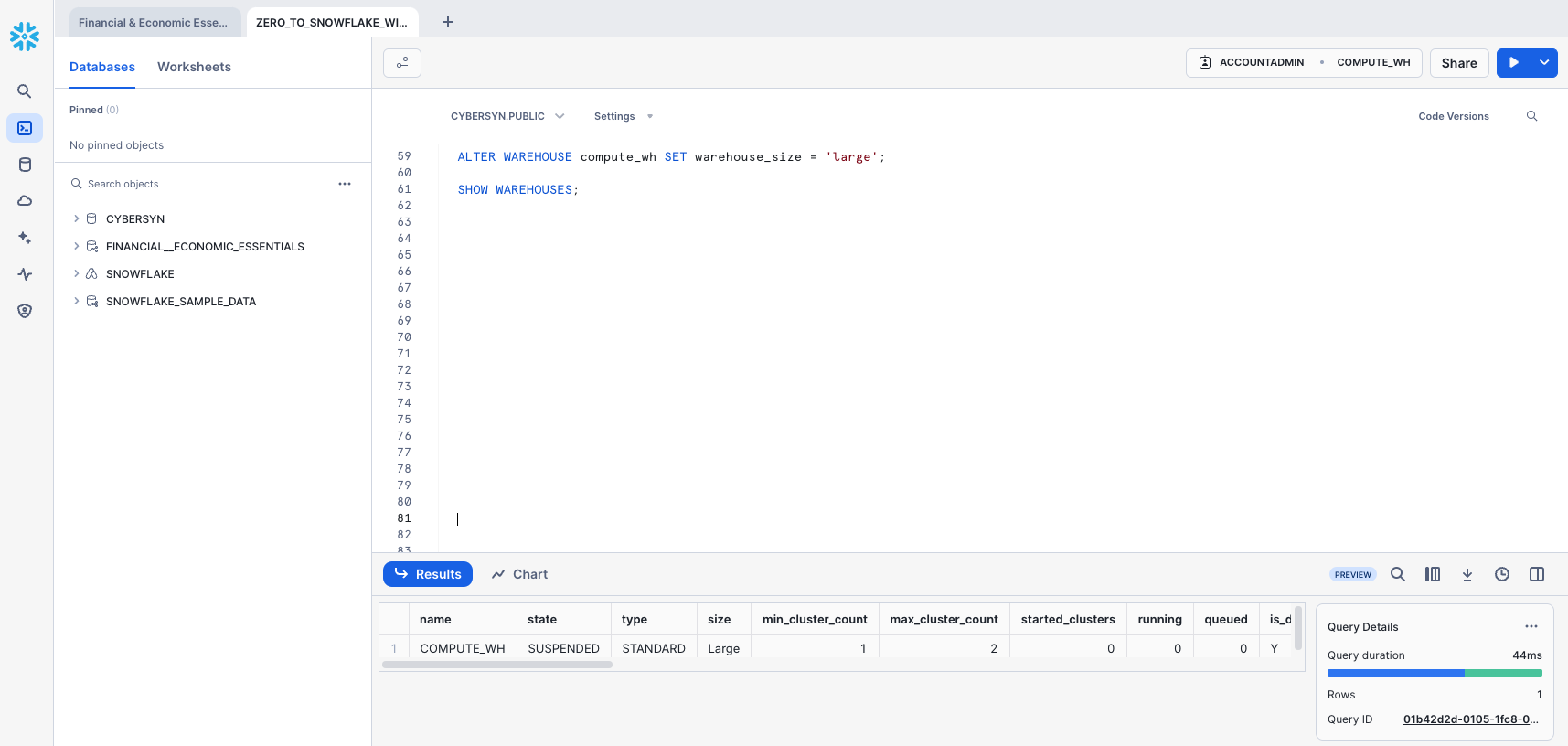
The size can also be changed using the UI by clicking on the worksheet context box, then the Configure (3-line) icon on the right side of the context box, and changing Small to Large in the Size drop-down:
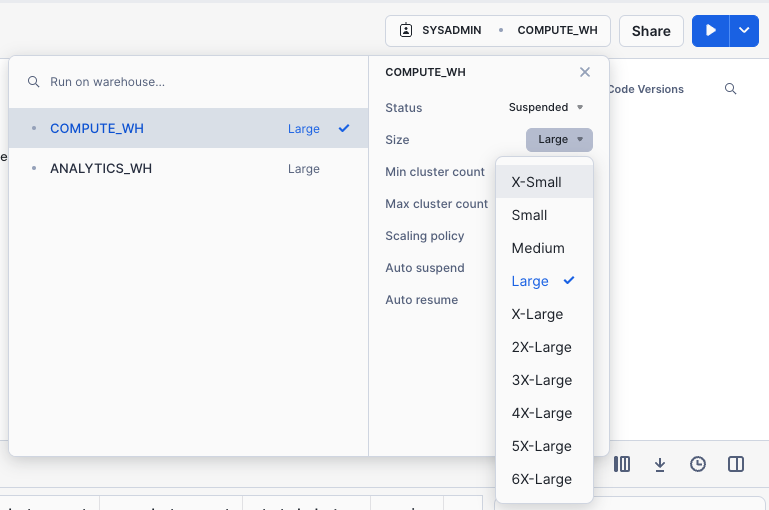
Execute the same COPY INTO statement as before to load the same data again:
COPY INTO company_metadata FROM @Public_Data_company_metadata file_format=csv PATTERN = '.*csv.*' ON_ERROR = 'CONTINUE';
Once the load is done, navigate back to the Queries page (Home icon > Activity > Query History). Compare the times of the two COPY INTO commands. The load using the Large warehouse was significantly faster.
Create a New Warehouse for Data Analytics
Let's assume our internal analytics team wants to eliminate resource contention between their data loading/ETL workloads and the analytical end users using BI tools to query Snowflake. As mentioned earlier, Snowflake can easily do this by assigning different, appropriately-sized warehouses to various workloads. Since our company already has a warehouse for data loading, let's create a new warehouse for the end users running analytics. We will use this warehouse to perform analytics in the next section.
Navigate to the Admin > Warehouses tab, click + Warehouse, and name the new warehouse and set the size to Large.
If you are using Snowflake Enterprise Edition (or higher) and Multi-cluster Warehouses is enabled, you will see additional settings:
- Make sure Max Clusters is set to
1. - Leave all the other settings at their defaults.
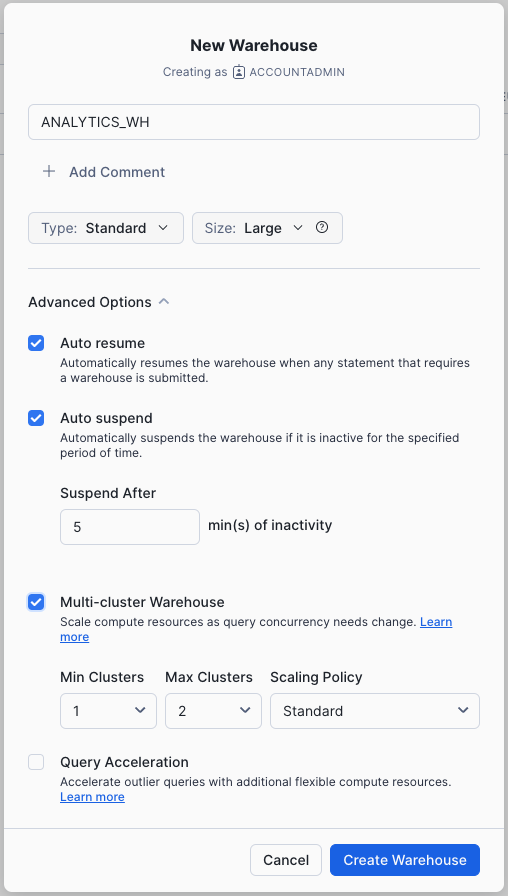
Click the Create Warehouse button to create the warehouse.
Going back to the lab's example, our company's analytics team wants to evaluate the performance of CPG companies through the lens of their reported metrics in SEC filings. To do this, in this section, we will:
- Load SEC filing data in semi-structured JSON format held in a public S3 bucket.
- Create a view and query the JSON data using SQL dot notation.
The JSON data consists of SEC filings provided by Snowflake Public Data, detailing the historical performance of consumer-packaged goods companies from 2019-2023. It is also staged on AWS S3. If viewed in a text editor, the raw JSON in the GZ files looks like:
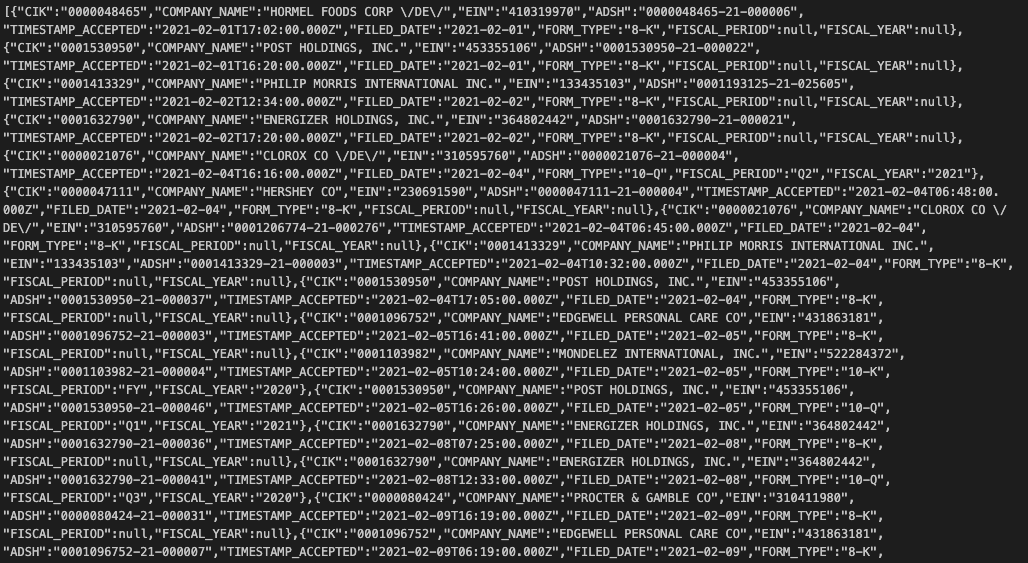
(The full dataset available for free in Snowflake Marketplace from Snowflake Public Data – no ETL required. For the purposes of this demo, we will focus on working with the semi-structured JSON file to learn how to load structured data into Snowflake.)
Create a New Database and Table for the Data
Next, let's create two tables, SEC_FILINGS_INDEX and SEC_FILINGS_ATTRIBUTES to use for loading JSON data. In the worksheet, execute the following CREATE TABLE commands:
CREATE TABLE sec_filings_index (v variant);
CREATE TABLE sec_filings_attributes (v variant);
Note that Snowflake has a special data type called VARIANT that allows storing the entire JSON object as a single row and querying the object directly.
In the results pane at the bottom of the worksheet, verify that your tables, SEC_FILINGS_INDEX and SEC_FILINGS_ATTRIBUTES, were created:
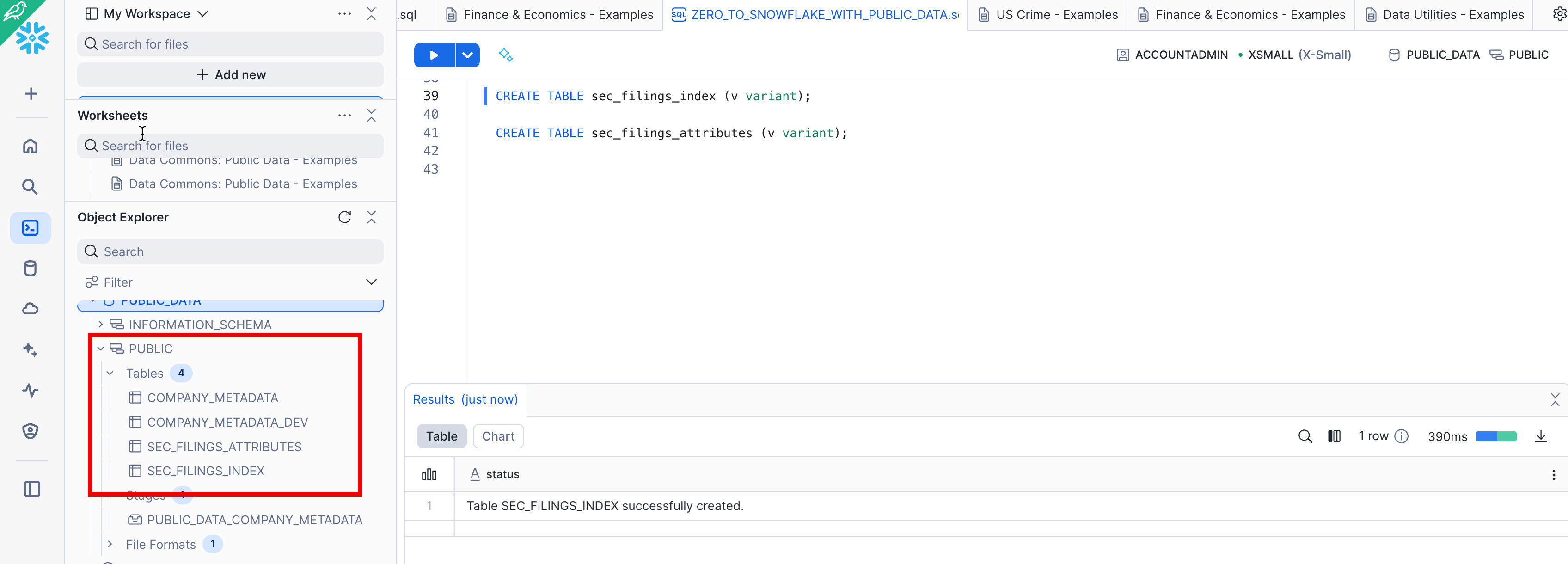
Create Another External Stage
In the ZERO_TO_SNOWFLAKE_WITH_Public_Data worksheet, use the following command to create a stage that points to the bucket where the semi-structured JSON data is stored on AWS S3:
CREATE STAGE Public_Data_sec_filings
url = 's3://sfquickstarts/zero_to_snowflake/cybersyn_cpg_sec_filings/';
Now let's take a look at the contents of the Public_Data_sec_filings stage. Execute the following LIST command to display the list of files:
LIST @Public_Data_sec_filings;
In the results pane, you should see a list of .gz files from S3: 
Load and Verify the Semi-structured Data
We will now use a warehouse to load the data from an S3 bucket into the tables we created earlier. In the ZERO_TO_SNOWFLAKE_WITH_PUBLIC_DATA worksheet, execute the COPY` command below to load the data.
Note that you can specify a FILE FORMAT object inline in the command. In the previous section where we loaded structured data in CSV format, we had to define a file format to support the CSV structure. Because the JSON data here is well-formed, we are able to simply specify the JSON type and use all the default settings:
COPY INTO sec_filings_index
FROM @Public_Data_sec_filings/cybersyn_sec_report_index.json.gz
file_format = (type = json strip_outer_array = true);
COPY INTO sec_filings_attributes
FROM @Public_Data_sec_filings/cybersyn_sec_report_attributes.json.gz
file_format = (type = json strip_outer_array = true);
Verify that each file has a status of LOADED: 
Now, let's take a look at the data that was loaded:
SELECT * FROM sec_filings_index LIMIT 10;
SELECT * FROM sec_filings_attributes LIMIT 10;
Click any of the rows to display the formatted JSON in the right panel:
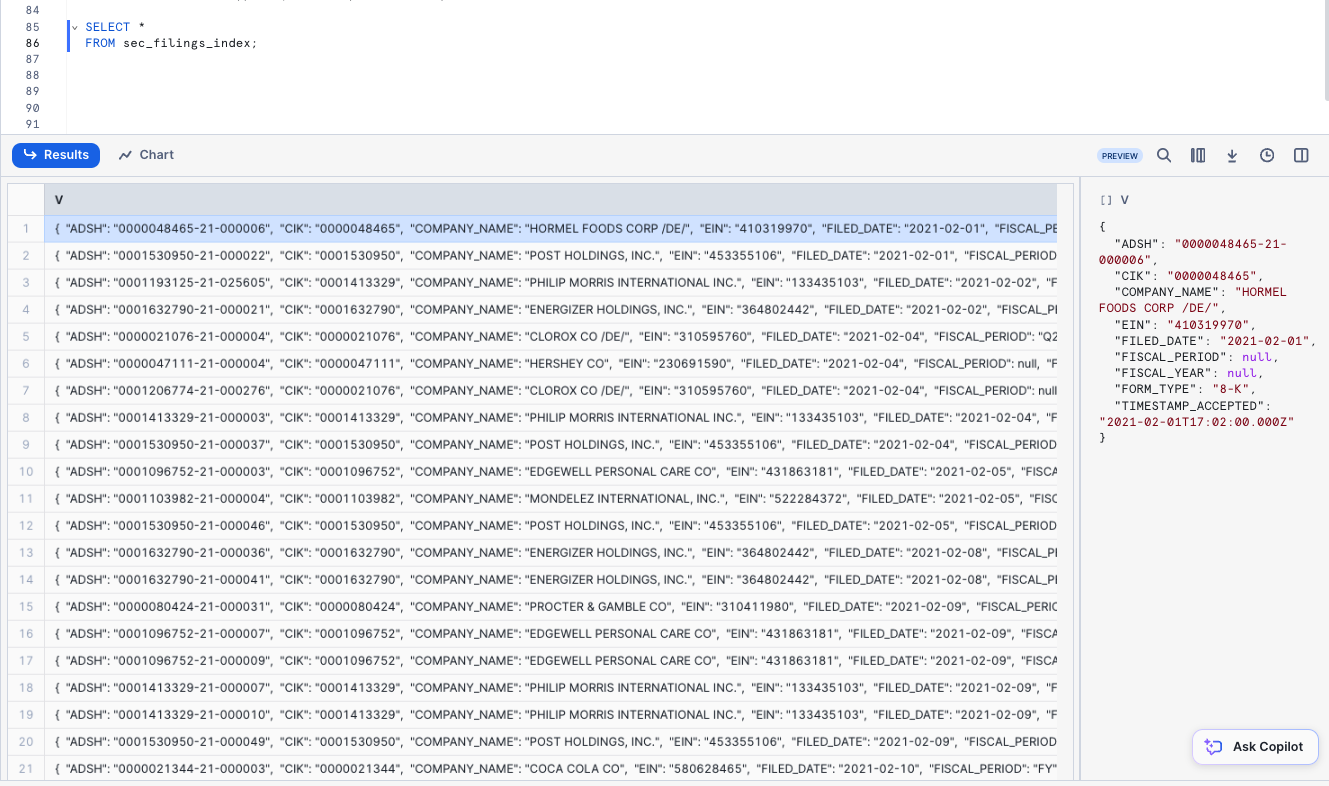
To close the display in the panel and display the query details again, click the X (Close) button that appears when you hover your mouse in the right corner of the panel.
Create a View and Query Semi-Structured Data
Next, let's look at how Snowflake allows us to create a view and also query the JSON data directly using SQL.
Snowflake also supports materialized views in which the query results are stored as though the results are a table. This allows faster access, but requires storage space. Materialized views can be created and queried if you are using Snowflake Enterprise Edition (or higher).
Run the following command to create a columnar view of the semi-structured JSON SEC filing data, so it is easier for analysts to understand and query. The CIK corresponds to the Central Index Key, or unique identifier that SEC gives to each filing entity. The ADSH is the document number for any filing submitted to the SEC.
CREATE OR REPLACE VIEW sec_filings_index_view AS
SELECT
v:CIK::string AS cik,
v:COMPANY_NAME::string AS company_name,
v:EIN::int AS ein,
v:ADSH::string AS adsh,
v:TIMESTAMP_ACCEPTED::timestamp AS timestamp_accepted,
v:FILED_DATE::date AS filed_date,
v:FORM_TYPE::string AS form_type,
v:FISCAL_PERIOD::string AS fiscal_period,
v:FISCAL_YEAR::string AS fiscal_year
FROM sec_filings_index;
CREATE OR REPLACE VIEW sec_filings_attributes_view AS
SELECT
v:VARIABLE::string AS variable,
v:CIK::string AS cik,
v:ADSH::string AS adsh,
v:MEASURE_DESCRIPTION::string AS measure_description,
v:TAG::string AS tag,
v:TAG_VERSION::string AS tag_version,
v:UNIT_OF_MEASURE::string AS unit_of_measure,
v:VALUE::string AS value,
v:REPORT::int AS report,
v:STATEMENT::string AS statement,
v:PERIOD_START_DATE::date AS period_start_date,
v:PERIOD_END_DATE::date AS period_end_date,
v:COVERED_QTRS::int AS covered_qtrs,
TRY_PARSE_JSON(v:METADATA) AS metadata
FROM sec_filings_attributes;
SQL dot notation v:VARIABLE is used in this command to pull out values at lower levels within the JSON object hierarchy. This allows us to treat each field as if it were a column in a relational table.
The new view should appear as SEC_FILINGS_INDEX_VIEW under Public_data > PUBLIC > Views in the object browser on the left. You may need to expand or refresh the objects browser in order to see it.
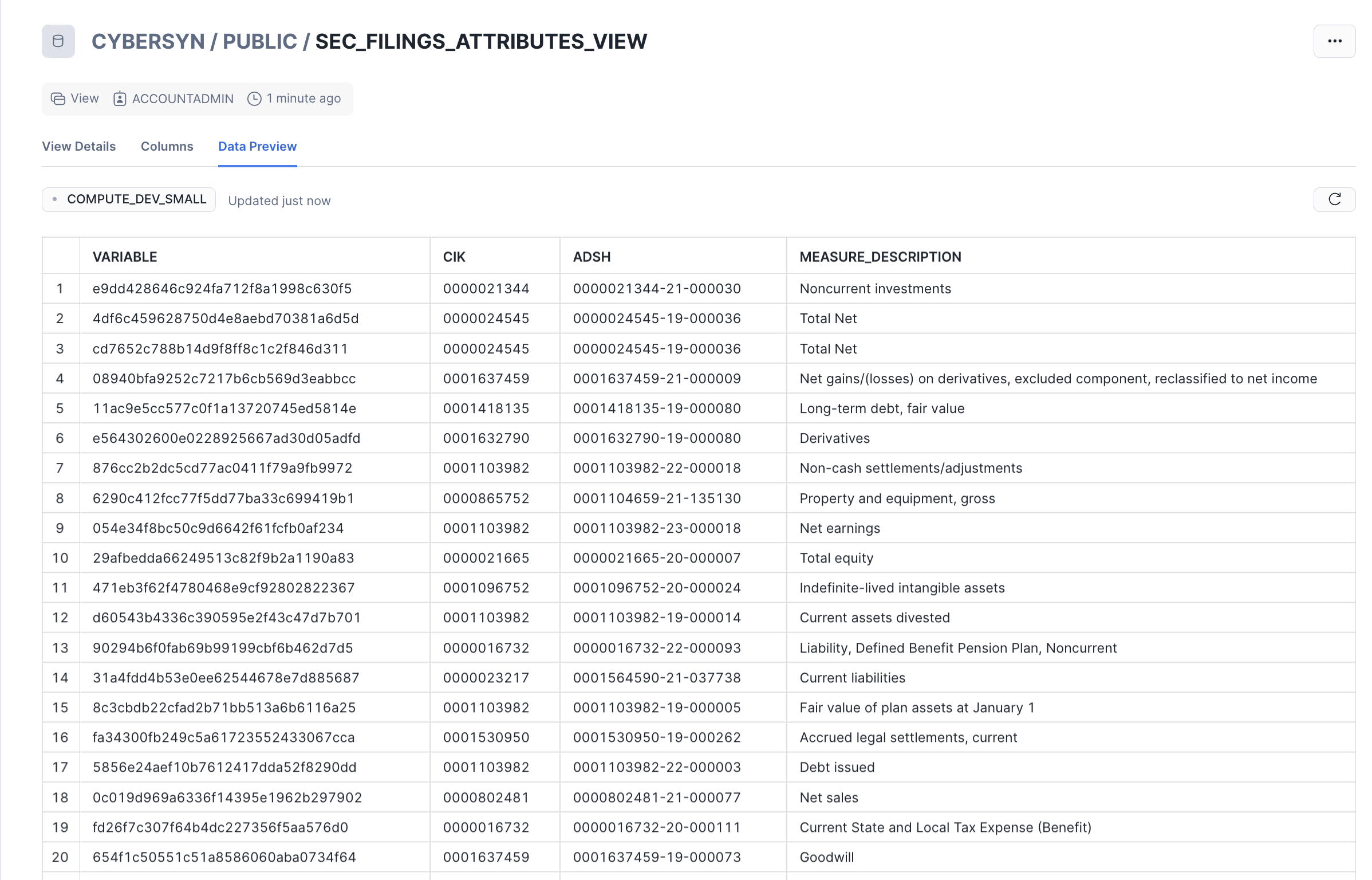
Notice the results look just like a regular structured data source:
SELECT *
FROM sec_filings_index_view
LIMIT 20;
Snowflake Data Marketplace
Make sure you're using the ACCOUNTADMIN role and, navigate to the Marketplace (Data Products > Marketplace):
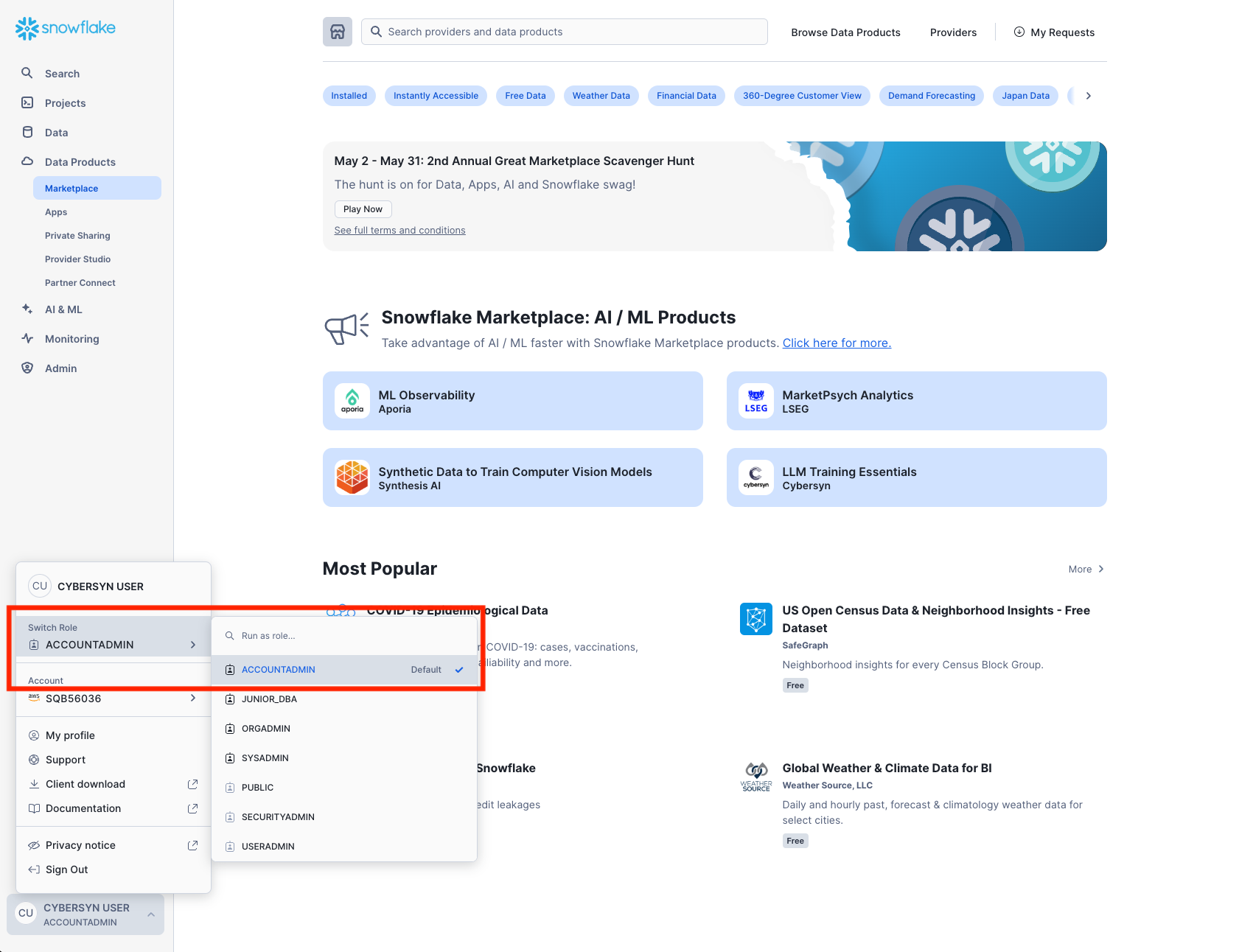
Find a listing
Type Snowflake Public Data (Free) in the search box at the top, scroll through the results, and select Snowflake Public Data (Free) (provided by Snowflake Public Data).
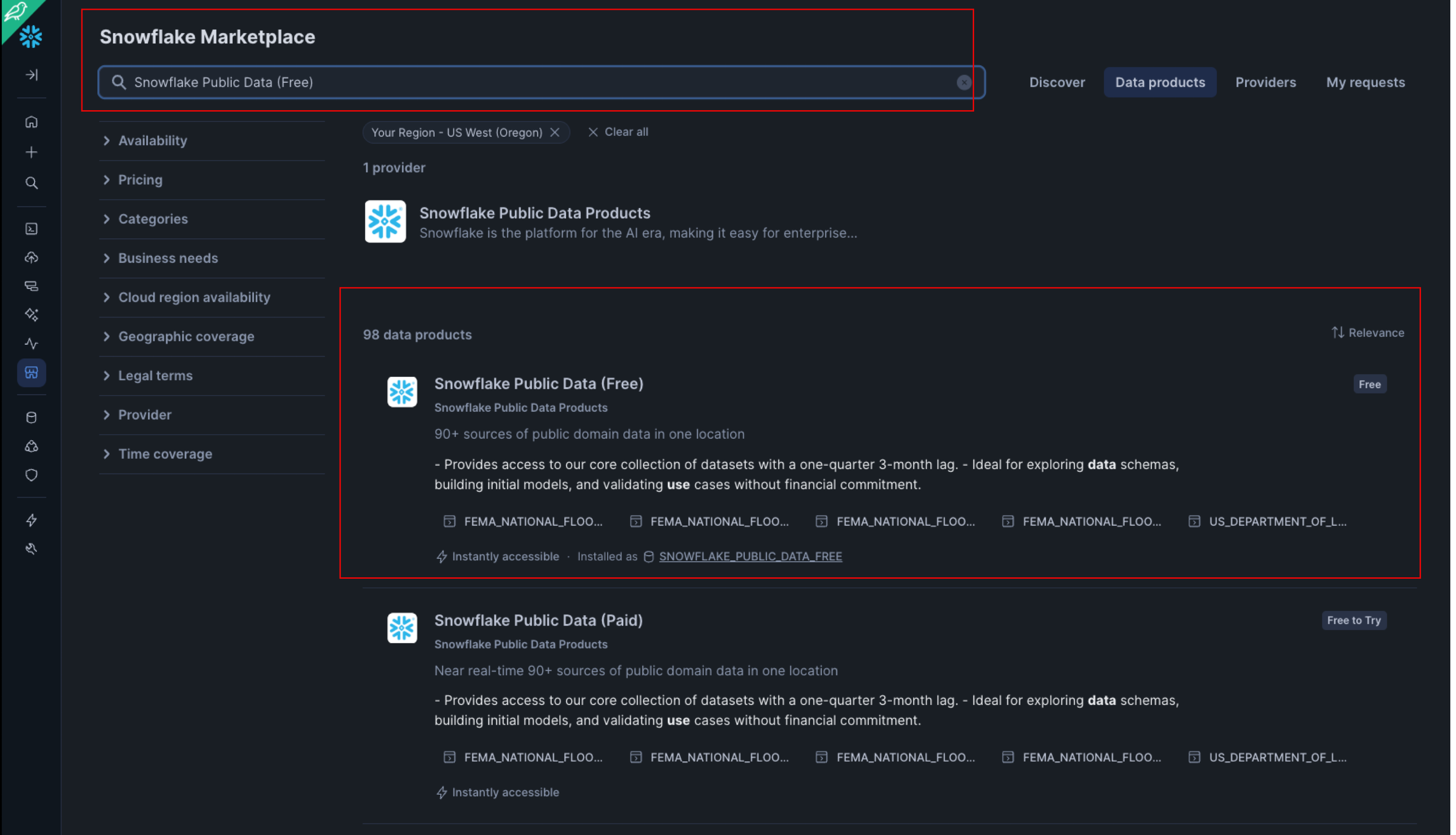
In the Snowflake Public Data (Free) page, you can learn more about the contents of the data listing, explore data dictionaries, and see some sample queries. You will also see links to documentation and the dataset's cloud region availability. When you're ready, click the Get button to make this information available within your Snowflake account:
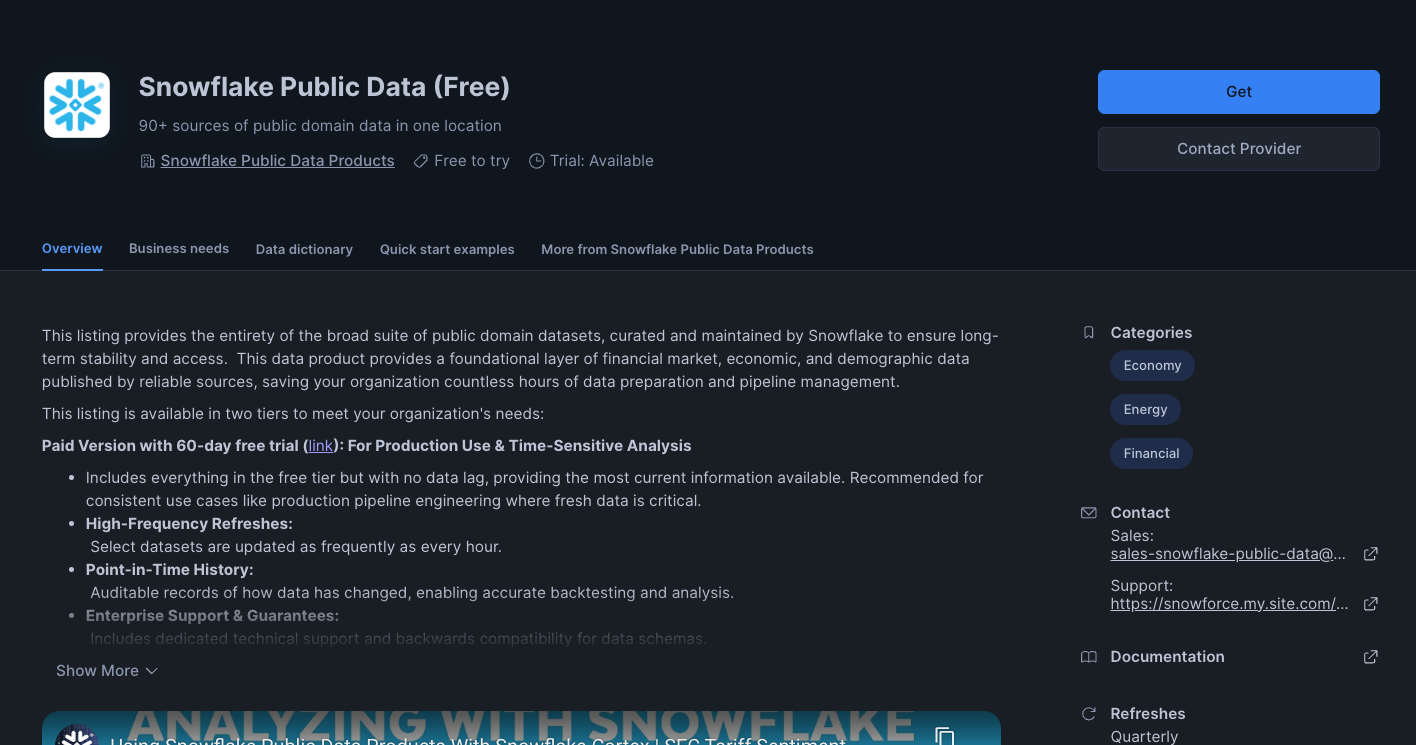
Review the information in the dialog and click Get again:
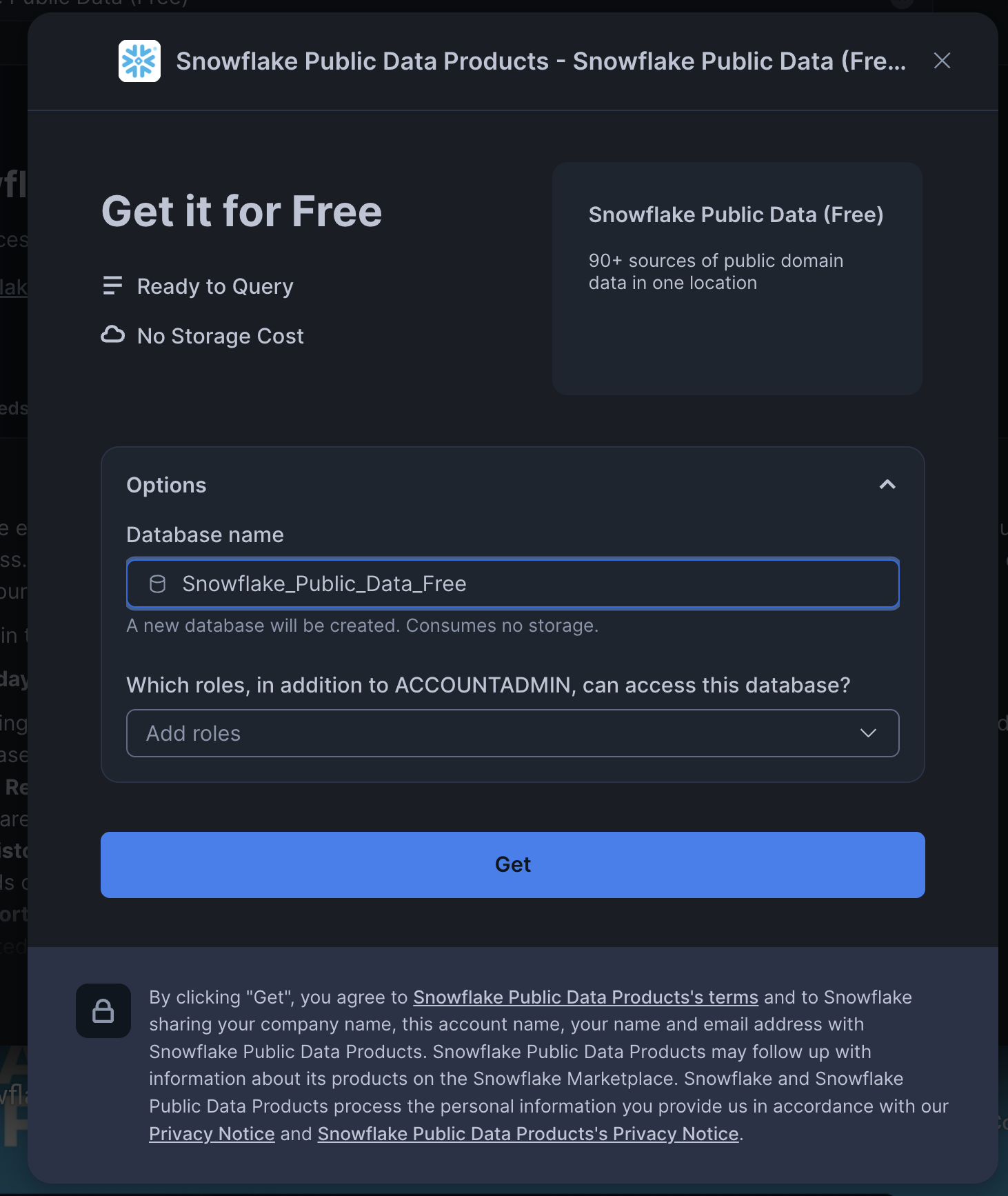
You can now click Done or choose to run the sample queries provided by Snowflake Public Data:
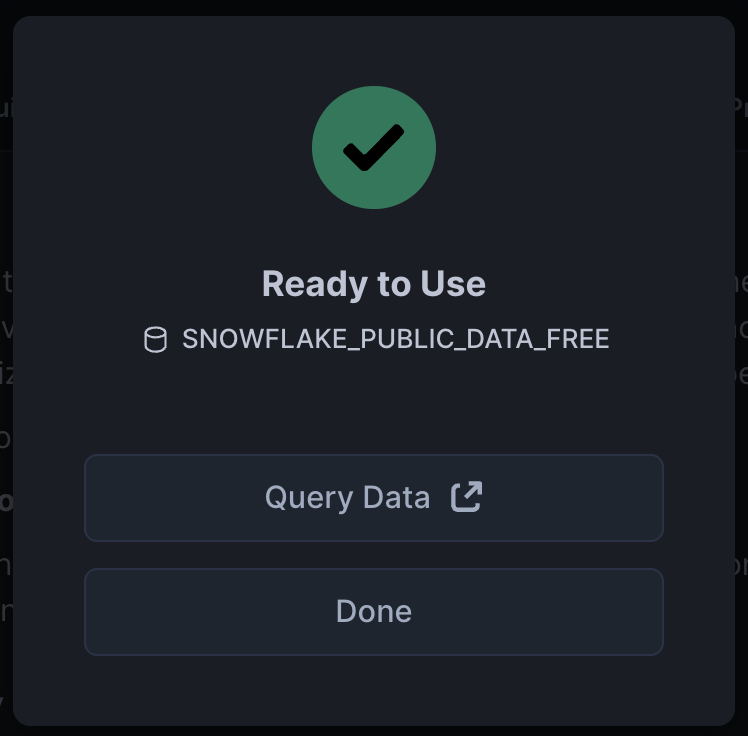
If you chose Query Data, a new worksheet opens in a new browser tab/window:
- Set your context
- Select the query you want to run (or place your cursor in the query text).
- Click the Run/Play button (or use the keyboard shortcut).
- You can view the data results in the bottom pane.
- When you are done running the sample queries, click the Home icon in the upper left corner.
Next:
- Click Data > Databases.
- Click the
SNOWFLAKE_PUBLIC_DATA_FREEdatabase. - You can see details about the schemas, tables, and views that are available to query.

That's it! You have now successfully subscribed to the Snowflake Public Data (Free) from Snowflake Public Data, which is updated regularly with global financial data. Notice we didn't have to create databases, tables, views, or an ETL process. We simply searched for and accessed shared data from the Snowflake Data Marketplace.
In the previous exercises, we loaded data into two tables using Snowflake's COPY bulk loader command and the COMPUTE_WH virtual warehouse. Now we are going to take on the role of the analytics users at our company who need to query data in those tables using the worksheet and the second warehouse ANALYTICS_WH.
Execute Some Queries
Go to the ZERO_TO_SNOWFLAKE_WITH_Public_Data worksheet and change the warehouse to use the new warehouse you created in the last section. Your worksheet context should be the following:
Role: SYSADMINWarehouse: ANALYTICS_WH (L)Database: Public_DataSchema: PUBLIC
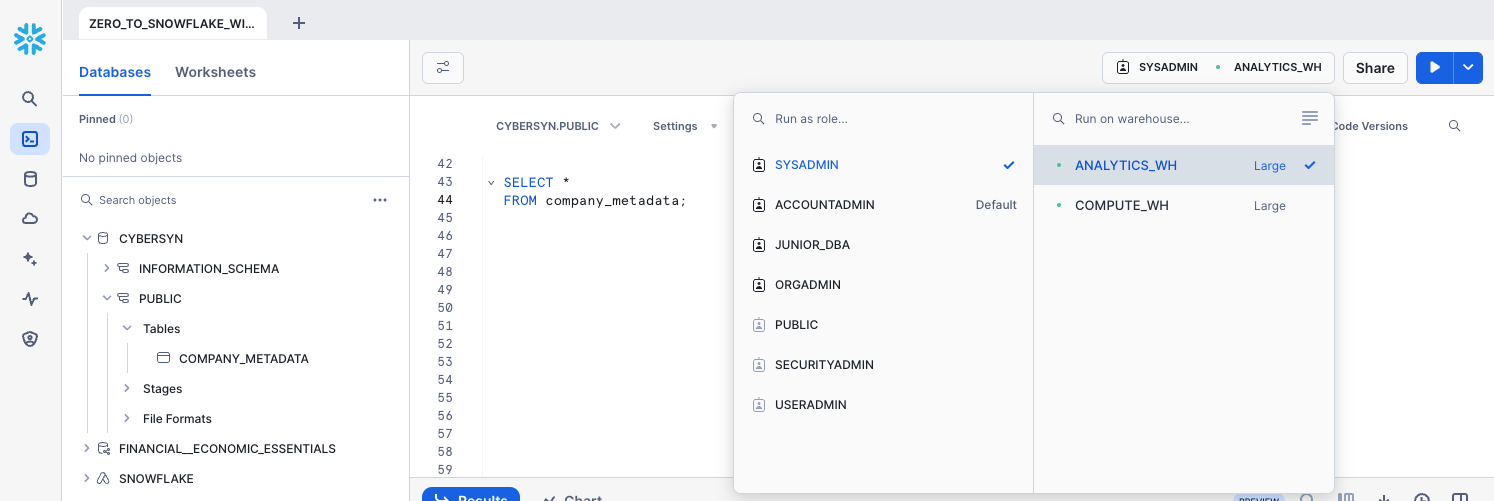
Run the following query to see a sample of the company_metadata data:
SELECT * FROM company_metadata;
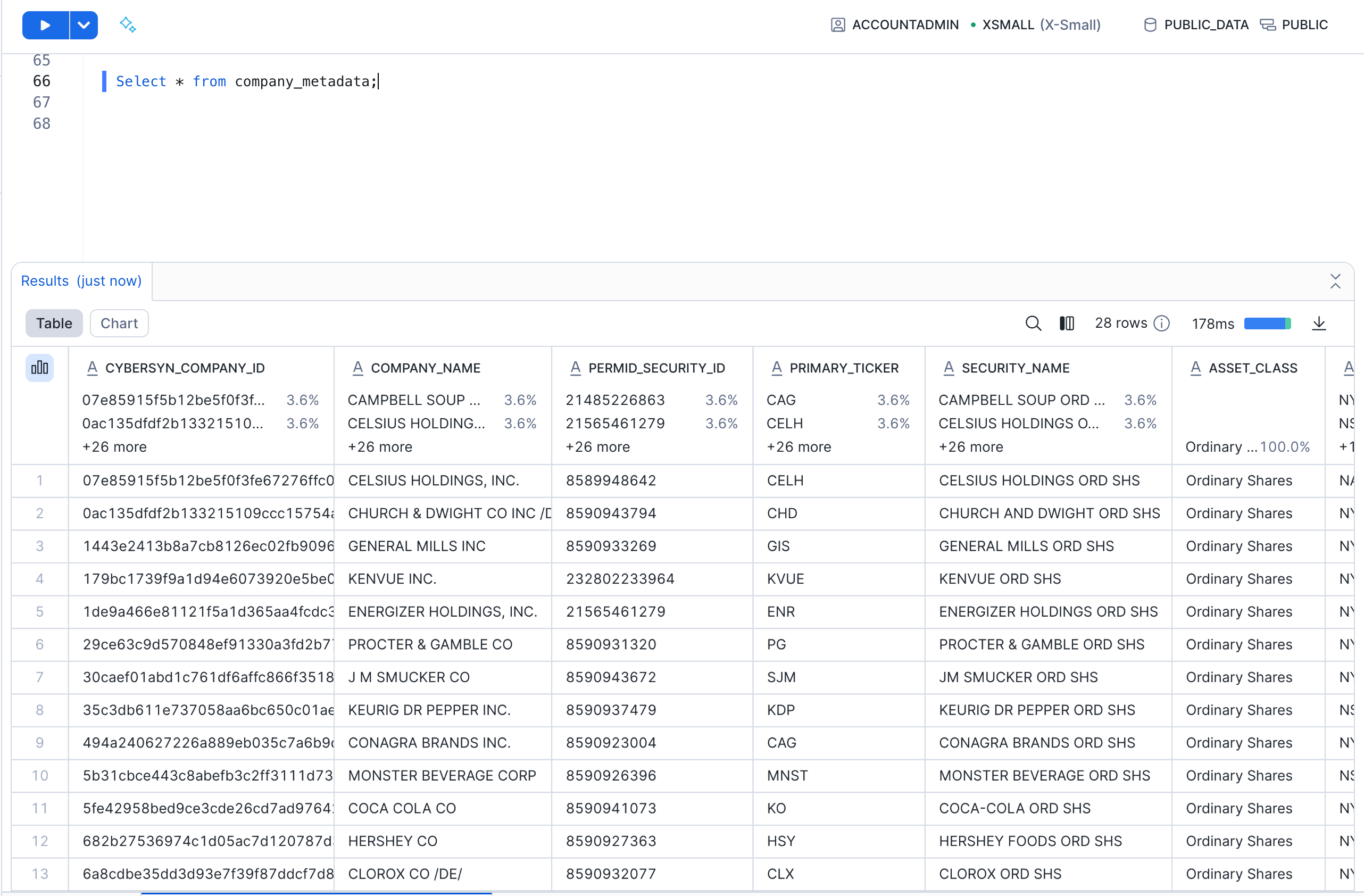
Now, let's look at the performance of these companies in the stock market. Run the queries below in the worksheet.
Closing Price Statistics: First, calculate the daily return of a stock (the percent change in the stock price from the close of the previous day to the close of the current day) and 5-day moving average from closing prices (which helps smooth out daily price fluctuations to identify trends).
SELECT
meta.primary_ticker,
meta.company_name,
ts.date,
ts.value AS post_market_close,
(ts.value / LAG(ts.value, 1) OVER (PARTITION BY meta.primary_ticker ORDER BY ts.date))::DOUBLE AS daily_return,
AVG(ts.value) OVER (PARTITION BY meta.primary_ticker ORDER BY ts.date ROWS BETWEEN 4 PRECEDING AND CURRENT ROW) AS five_day_moving_avg_price
FROM SNOWFLAKE_PUBLIC_DATA_FREE.PUBLIC_DATA_FREE.STOCK_PRICE_TIMESERIES ts
INNER JOIN company_metadata meta
ON ts.ticker = meta.primary_ticker
WHERE ts.variable_name = 'Post-Market Close';
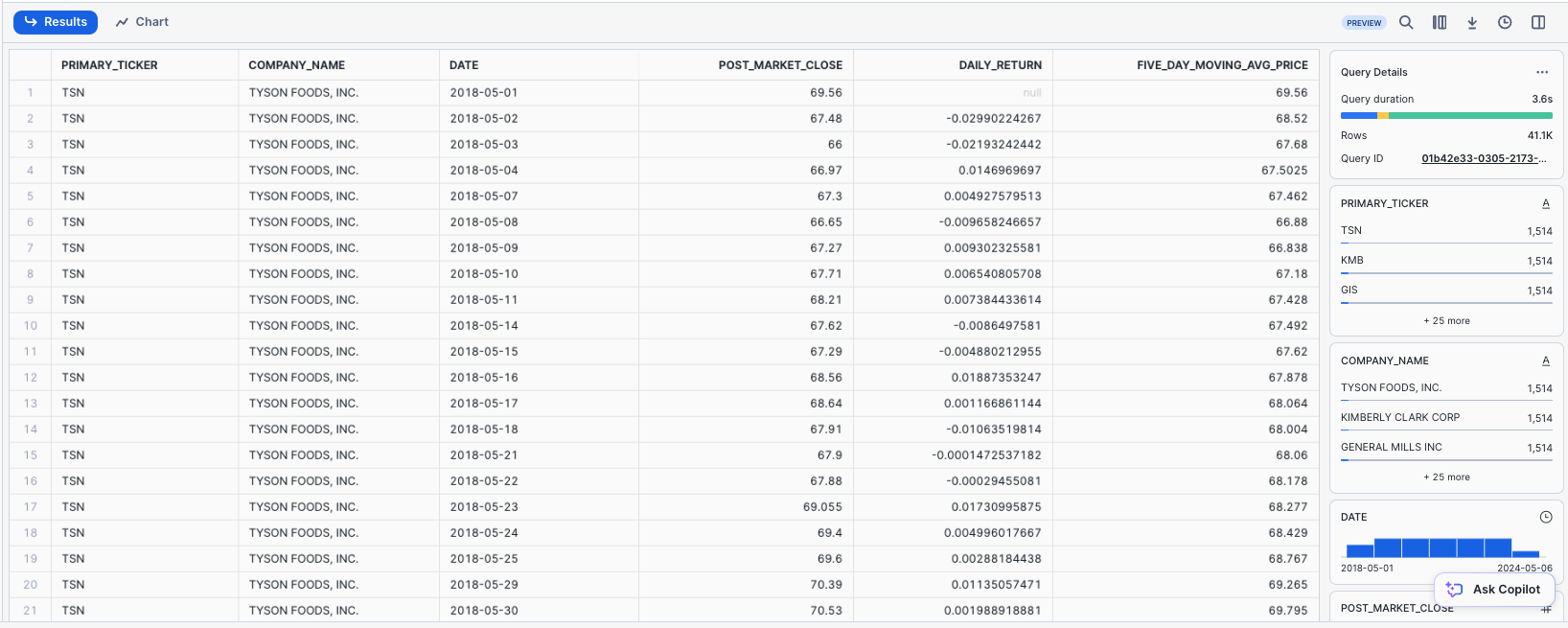
Trading Volume Statistics: Then, calculate the trading volume change from one day to the next to see if there's an increase or decrease in trading activity. This can be a sign of increasing or decreasing interest in a stock.
SELECT
meta.primary_ticker,
meta.company_name,
ts.date,
ts.value AS nasdaq_volume,
(ts.value / LAG(ts.value, 1) OVER (PARTITION BY meta.primary_ticker ORDER BY ts.date))::DOUBLE AS volume_change
FROM SNOWFLAKE_PUBLIC_DATA_FREE.PUBLIC_DATA_FREE.STOCK_PRICE_TIMESERIES ts
INNER JOIN company_metadata meta
ON ts.ticker = meta.primary_ticker
WHERE ts.variable_name = 'Nasdaq Volume';
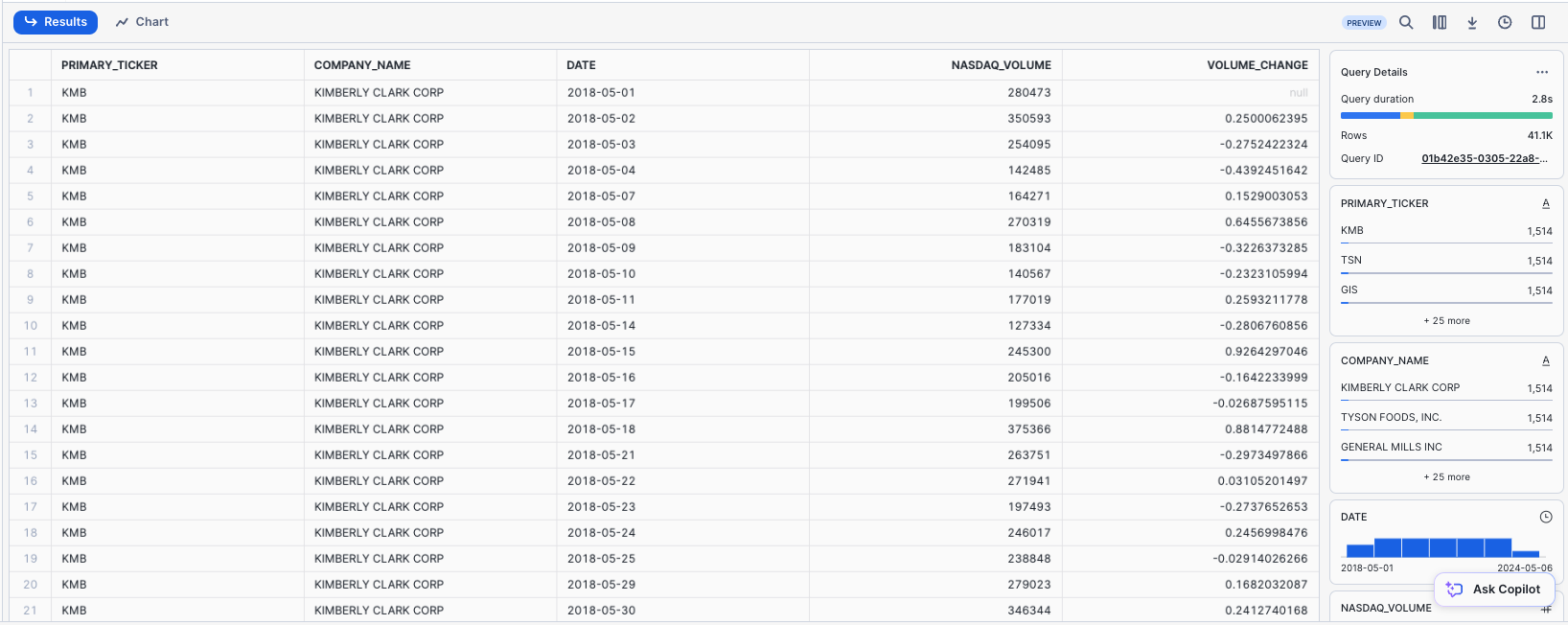
Use the Result Cache
Snowflake has a result cache that holds the results of every query executed in the past 24 hours. These are available across warehouses, so query results returned to one user are available to any other user on the system who executes the same query, provided the underlying data has not changed. Not only do these repeated queries return extremely fast, but they also use no compute credits.
Let's see the result cache in action by running the exact same query again.
SELECT
meta.primary_ticker,
meta.company_name,
ts.date,
ts.value AS post_market_close,
(ts.value / LAG(ts.value, 1) OVER (PARTITION BY primary_ticker ORDER BY ts.date))::DOUBLE AS daily_return,
AVG(ts.value) OVER (PARTITION BY primary_ticker ORDER BY date ROWS BETWEEN 4 PRECEDING AND CURRENT ROW) AS five_day_moving_avg_price
FROM SNOWFLAKE_PUBLIC_DATA_FREE.PUBLIC_DATA_FREE.STOCK_PRICE_TIMESERIES ts
INNER JOIN company_metadata meta
ON ts.ticker = meta.primary_ticker
WHERE variable_name = 'Post-Market Close';
In the Query Details pane on the right, note that the query runs significantly faster because the results have been cached. 
Clone a Table
Snowflake allows you to create clones, also known as "zero-copy clones" of tables, schemas, and databases in seconds. When a clone is created, Snowflake takes a snapshot of data present in the source object and makes it available to the cloned object. The cloned object is writable and independent of the clone source. Therefore, changes made to either the source object or the clone object are not included in the other.
A popular use case for zero-copy cloning is to clone a production environment for use by Development & Testing teams to test and experiment without adversely impacting the production environment and eliminating the need to set up and manage two separate environments.
Run the following command in the worksheet to create a development (dev) table clone of the company_metadata table:
CREATE TABLE company_metadata_dev CLONE company_metadata;
Click the three dots (...) in the left pane and select Refresh. Expand the object tree under the Public_Data database and verify that you see a new table named company_metadata_dev. Your Development team now can do whatever they want with this table, including updating or deleting it, without impacting the company_metadata table or any other object.
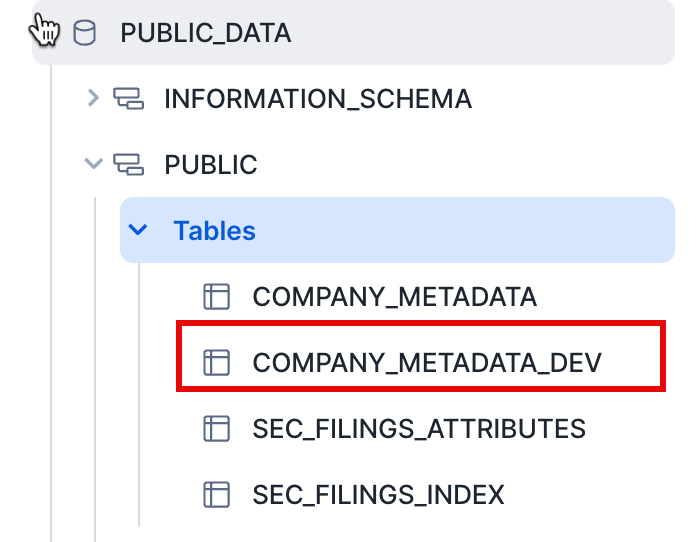
Joining Tables
We will now join the JSON SEC filing datasets together to investigate the revenue of one CPG company, Kraft Heinz. Run the query below to join SEC_FILINGS_INDEX to SEC_FILINGS_ATTRIBUTES to see how Kraft Heinz (KHC) business segments have performed over time:
WITH data_prep AS (
SELECT
idx.cik,
idx.company_name,
idx.adsh,
idx.form_type,
att.measure_description,
CAST(att.value AS DOUBLE) AS value,
att.period_start_date,
att.period_end_date,
att.covered_qtrs,
TRIM(att.metadata:"ProductOrService"::STRING) AS product
FROM sec_filings_attributes_view att
JOIN sec_filings_index_view idx
ON idx.cik = att.cik AND idx.adsh = att.adsh
WHERE idx.cik = '0001637459'
AND idx.form_type IN ('10-K', '10-Q')
AND LOWER(att.measure_description) = 'net sales'
AND (att.metadata IS NULL OR OBJECT_KEYS(att.metadata) = ARRAY_CONSTRUCT('ProductOrService'))
AND att.covered_qtrs IN (1, 4)
AND value > 0
QUALIFY ROW_NUMBER() OVER (
PARTITION BY idx.cik, idx.company_name, att.measure_description, att.period_start_date, att.period_end_date, att.covered_qtrs, product
ORDER BY idx.filed_date DESC
) = 1
)
SELECT
company_name,
measure_description,
product,
period_end_date,
CASE
WHEN covered_qtrs = 1 THEN value
WHEN covered_qtrs = 4 THEN value - SUM(value) OVER (
PARTITION BY cik, measure_description, product, YEAR(period_end_date)
ORDER BY period_end_date
ROWS BETWEEN 4 PRECEDING AND 1 PRECEDING
)
END AS quarterly_value
FROM data_prep
ORDER BY product, period_end_date;
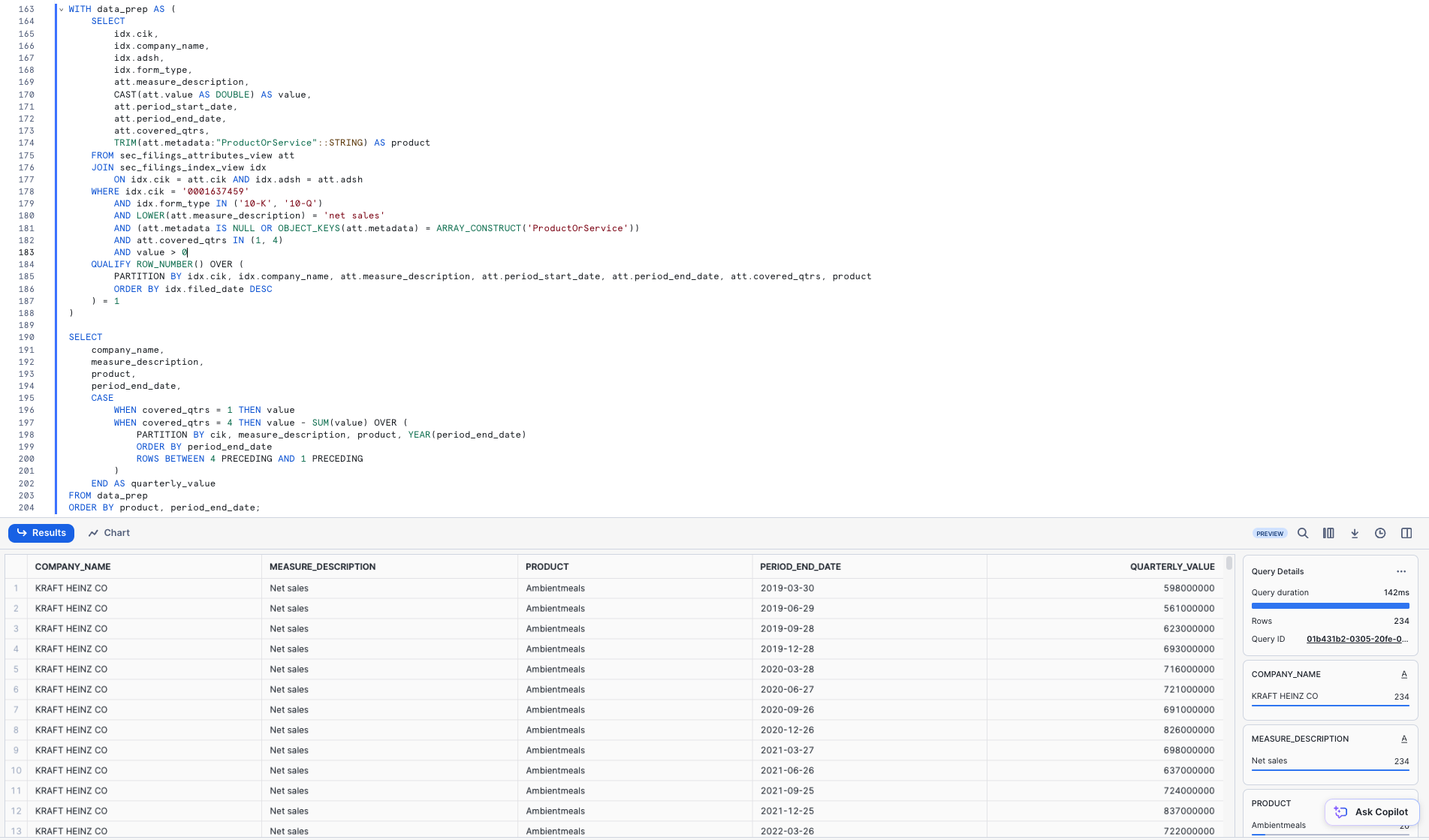
Snowflake's powerful Time Travel feature enables accessing historical data, as well as the objects storing the data, at any point within a period of time. The default window is 24 hours and, if you are using Snowflake Enterprise Edition, can be increased up to 90 days. Most data warehouses cannot offer this functionality, but - you guessed it - Snowflake makes it easy!
Some useful applications include:
- Restoring data-related objects such as tables, schemas, and databases that may have been deleted.
- Duplicating and backing up data from key points in the past.
- Analyzing data usage and manipulation over specified periods of time.
Drop and Undrop a Table
First let's see how we can restore data objects that have been accidentally or intentionally deleted.
In the ZERO_TO_SNOWFLAKE_WITH_Public_Data worksheet, run the following DROP command to remove the SEC_FILINGS_INDEX table:
DROP TABLE sec_filings_index;
-- Run a query on the table:
SELECT * FROM sec_filings_index LIMIT 10;
In the results pane at the bottom, you should see an error because the underlying table has been dropped: 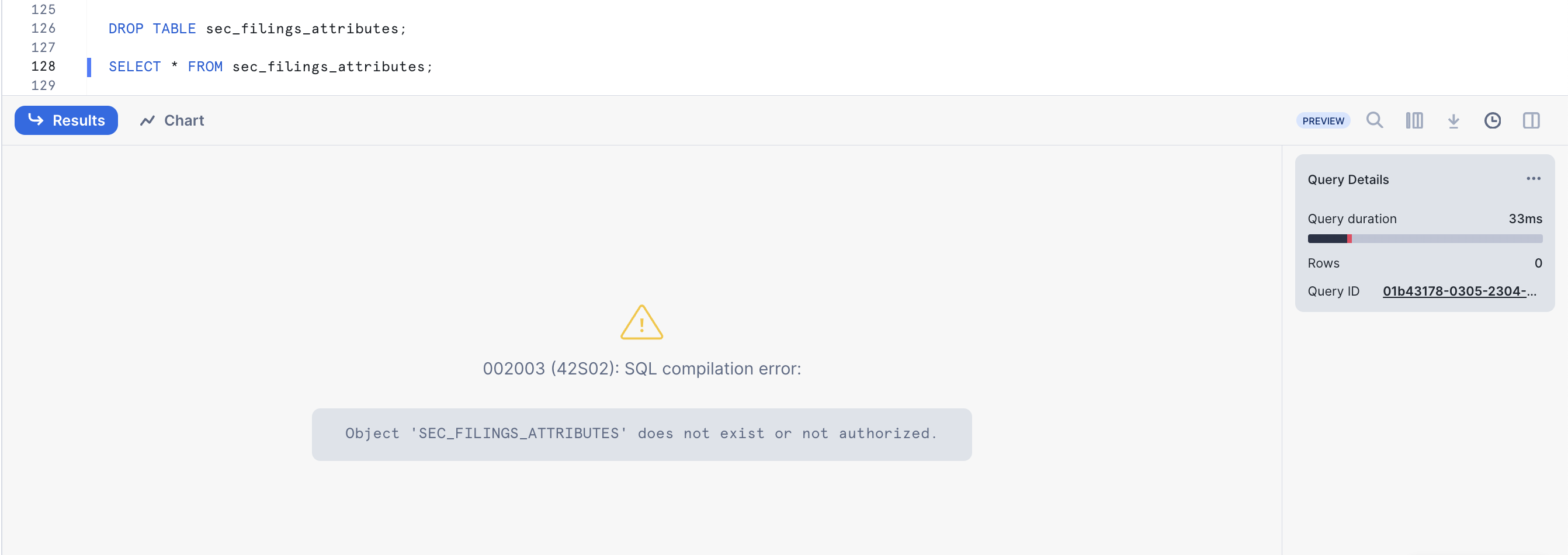
Now, restore the table:
UNDROP TABLE sec_filings_index;
The SEC filing index table should be restored. Verify by running the following query:
SELECT * FROM sec_filings_index LIMIT 10;
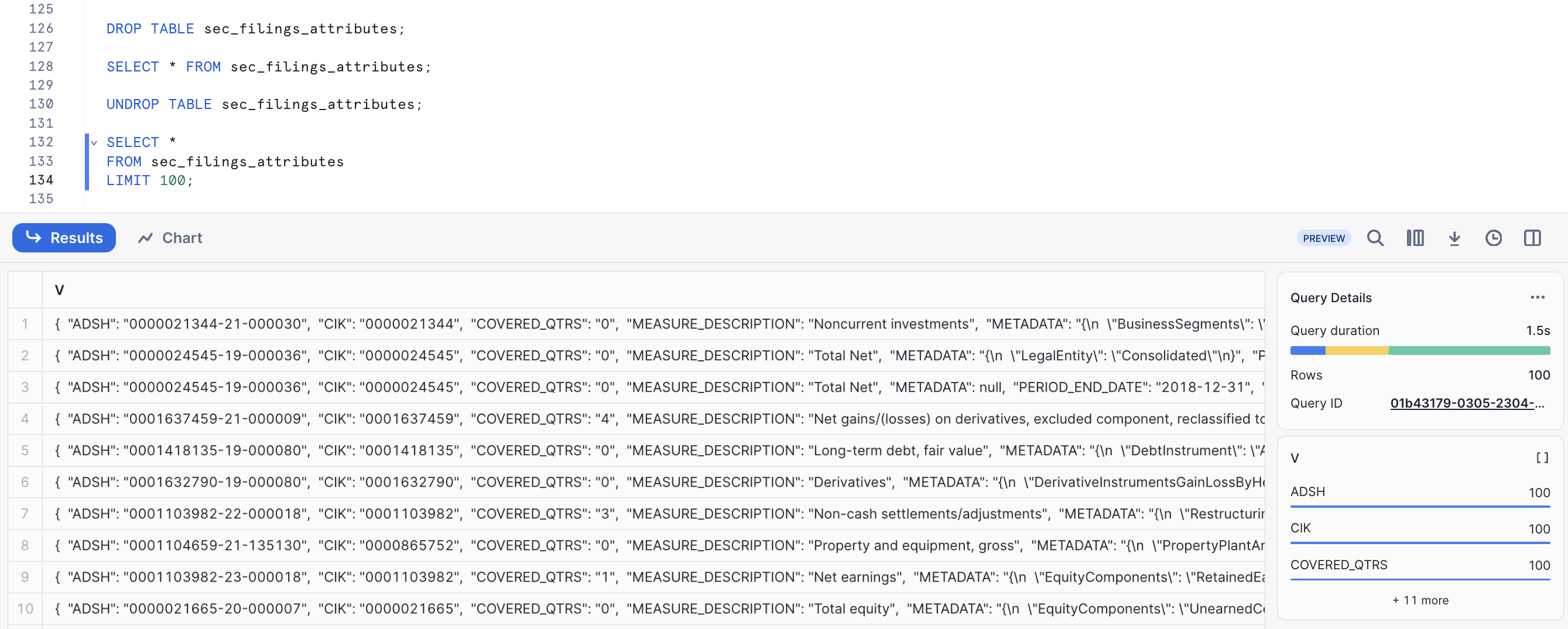
Roll Back a Table
Let's roll back the COMPANY_METADATA table in the Public_Data database to a previous state to fix an unintentional DML error that replaces all the company names in the table with the word "oops".
First, run the following SQL statements to switch your worksheet to the proper context:
USE ROLE sysadmin;
USE WAREHOUSE compute_wh;
USE DATABASE Public_Data;
USE SCHEMA public;
Run the following command to replace all of the company names in the table with the word "oops":
UPDATE company_metadata SET company_name = 'oops';
Now, run a query that returns the companies. Notice that the company names are all the same:
SELECT *
FROM company_metadata;

Normally we would need to scramble and hope we have a backup lying around. In Snowflake, we can simply run a command to find the query ID of the last UPDATE command and store it in a variable named $QUERY_ID.
Use Time Travel to recreate the table with the correct company names and verify the company names have been restored:
-- Set the session variable for the query_id
SET query_id = (
SELECT query_id
FROM TABLE(information_schema.query_history_by_session(result_limit=>5))
WHERE query_text LIKE 'UPDATE%'
ORDER BY start_time DESC
LIMIT 1
);
-- Use the session variable with the identifier syntax (e.g., $query_id)
CREATE OR REPLACE TABLE company_metadata AS
SELECT *
FROM company_metadata
BEFORE (STATEMENT => $query_id);
-- Verify the company names have been restored
SELECT *
FROM company_metadata;
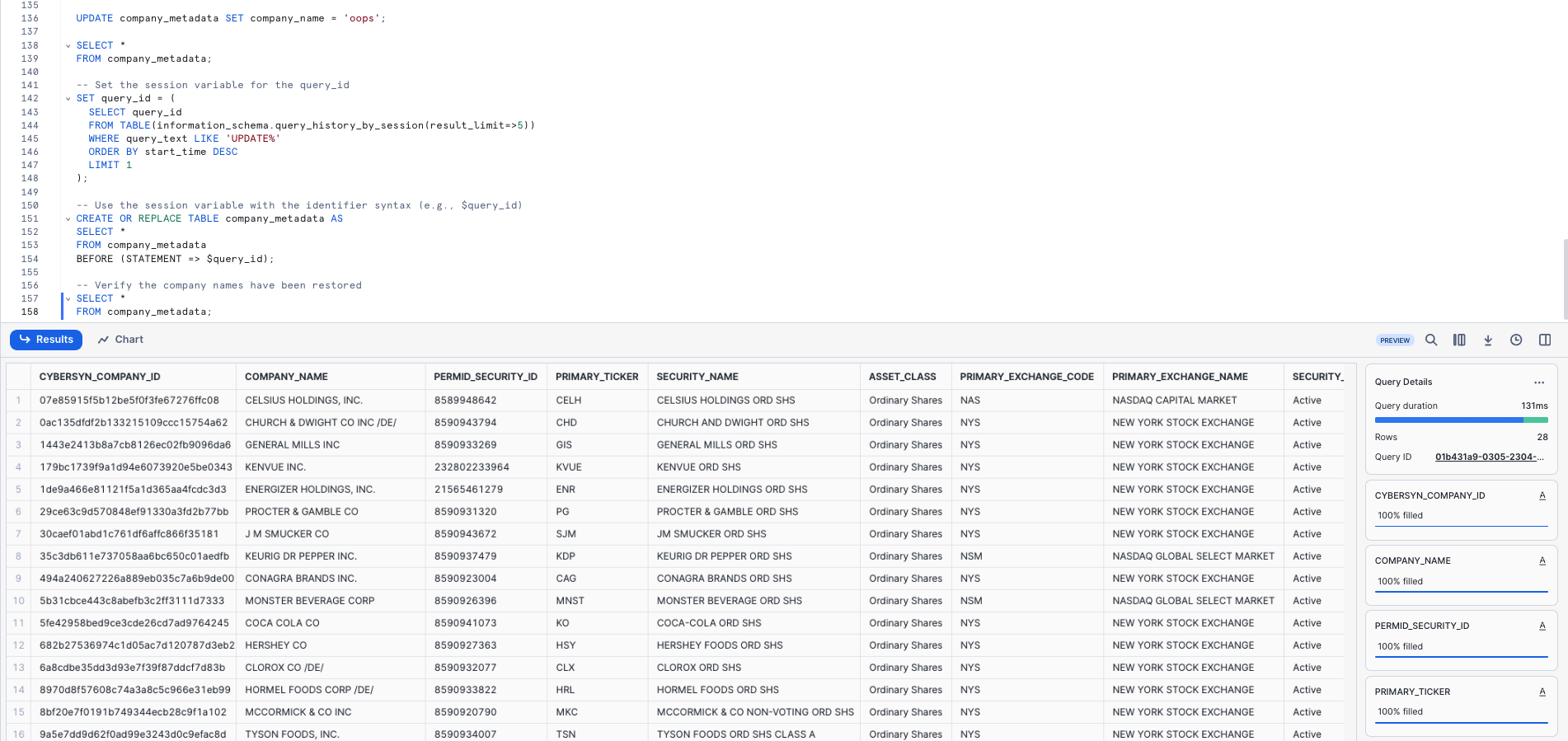
In this section, we will explore aspects of Snowflake's access control security model, such as creating a role and granting it specific permissions. We will also explore other usage of the ACCOUNTADMIN (Account Administrator) role.
Continuing with the lab story, let's assume a junior DBA has joined our internal analytics team, and we want to create a new role for them with less privileges than the system-defined, default role of SYSADMIN.
Create a New Role and Add a User
In the ZERO_TO_SNOWFLAKE_WITH_PUBLIC_DATA worksheet, switch to the ACCOUNTADMIN role to create a new role. ACCOUNTADMIN encapsulates the SYSADMIN and SECURITYADMIN system-defined roles. It is the top-level role in the account and should be granted only to a limited number of users.
USE ROLE accountadmin;
Notice that, in the top right of the worksheet, the context has changed to ACCOUNTADMIN:
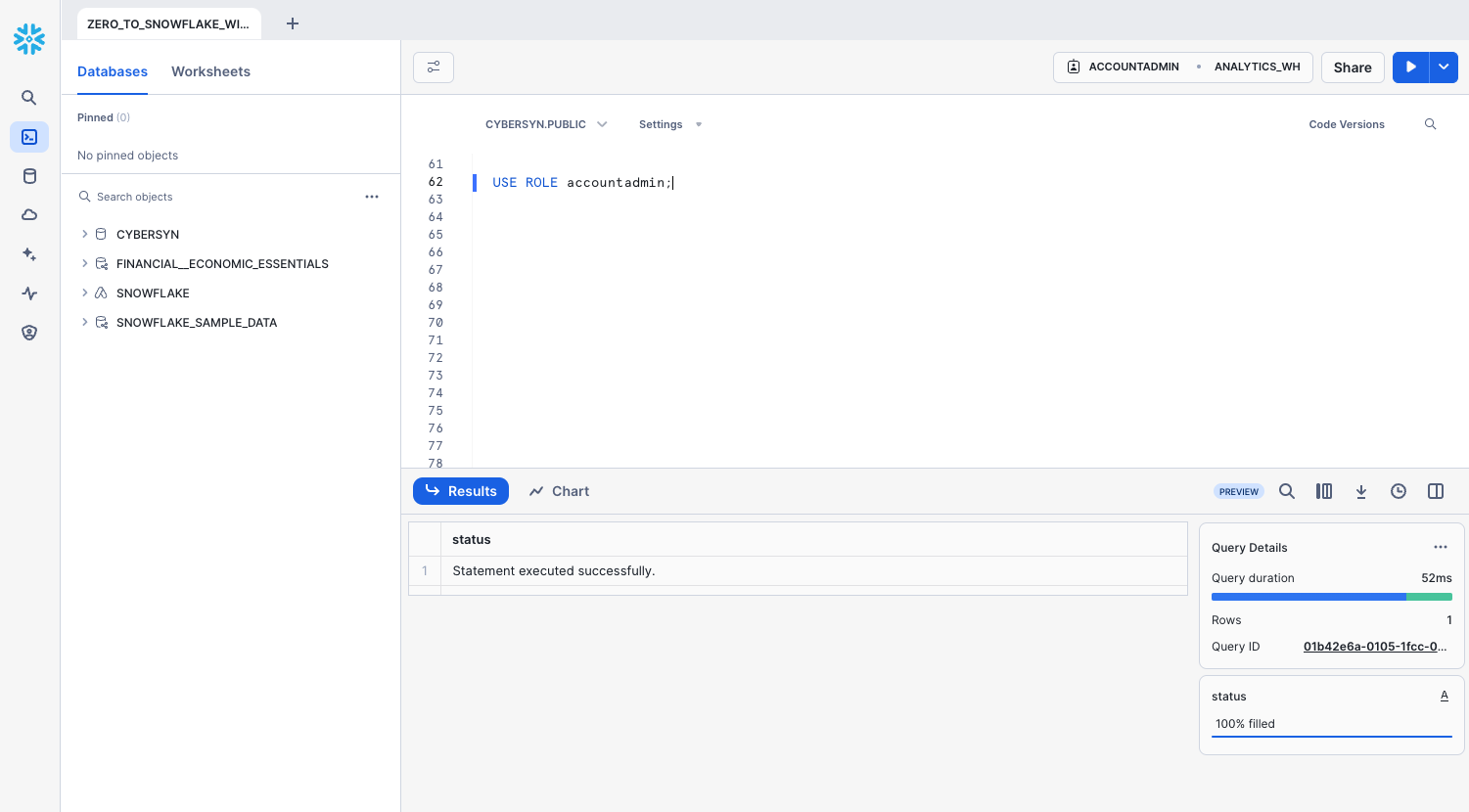
Before a role can be used for access control, at least one user must be assigned to it. So let's create a new role named JUNIOR_DBA and assign it to your Snowflake user. To complete this task, you need to know your username, which is the name you used to log in to the UI.
Use the following commands to create the role and assign it to you. Before you run the GRANT ROLE command, replace YOUR_USERNAME_GOES_HERE with your username:
CREATE ROLE junior_dba;
GRANT ROLE junior_dba TO USER YOUR_USERNAME_GOES_HERE;
Change your worksheet context to the new JUNIOR_DBA role:
USE ROLE junior_dba;
In the top right of the worksheet, notice that the context has changed to reflect the JUNIOR_DBA role.
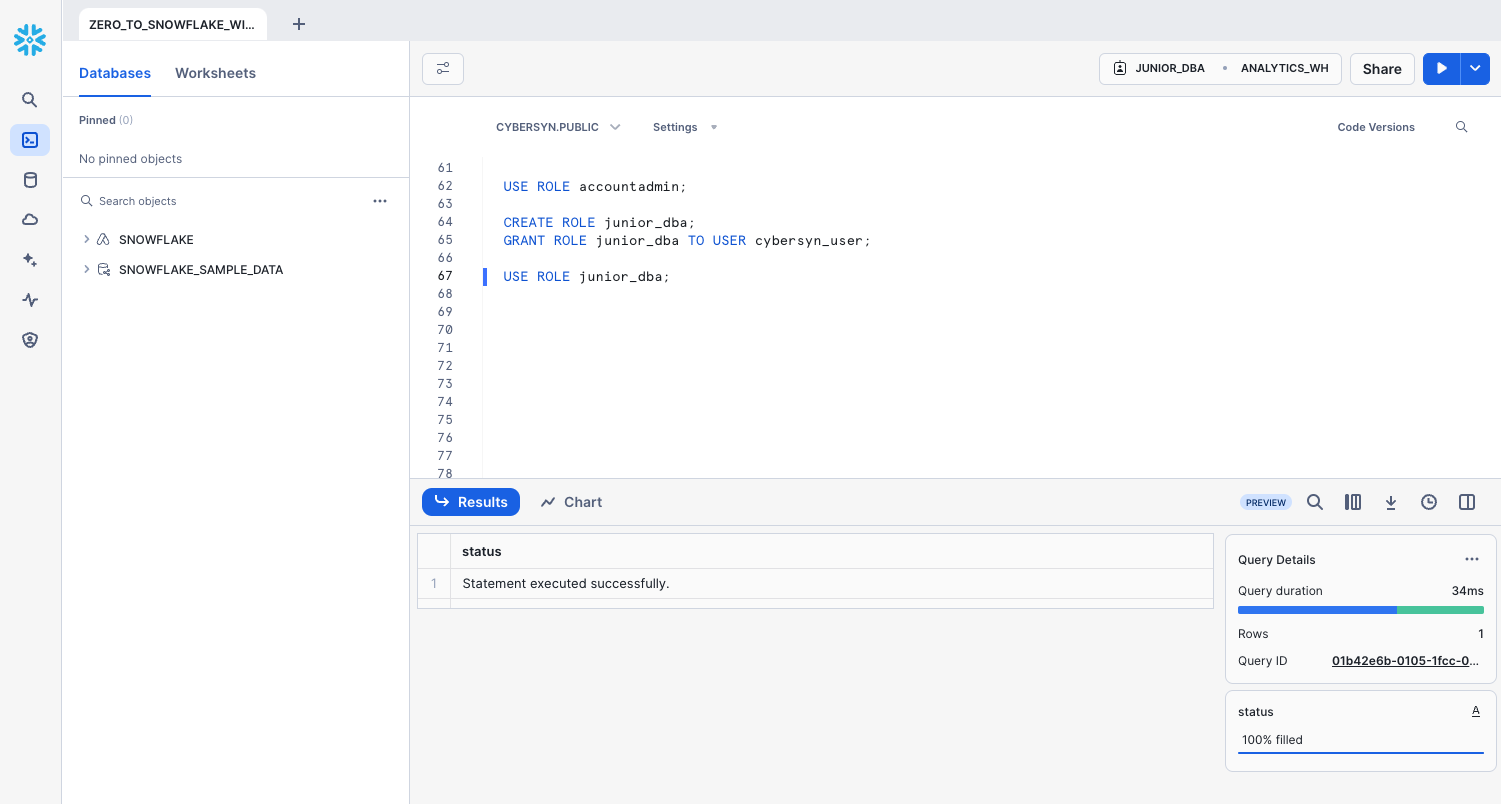
Also, the warehouse is not selected because the newly created role does not have usage privileges on any warehouse. Let's fix it by switching back to ACCOUNTADMIN role and grant usage privileges to COMPUTE_WH warehouse.
USE ROLE accountadmin;
GRANT USAGE ON WAREHOUSE compute_wh TO ROLE junior_dba;
Switch back to the JUNIOR_DBA role. You should be able to use COMPUTE_WH now.
USE ROLE junior_dba;
USE WAREHOUSE compute_wh;
Finally, you can notice that in the database object browser panel on the left, the Public_Data and SNOWFLAKE_PUBLIC_DATA_FREE databases no longer appear. This is because the JUNIOR_DBA role does not have privileges to access them.
Switch back to the ACCOUNTADMIN role and grant the JUNIOR_DBA the USAGE privilege required to view and use the Public_data and SNOWFLAKE_PUBLIC_DATA_FREE databases. Note that the Snowflake Public Data database from the Marketplace uses GRANT IMPORTED PRIVILEGES, instead of GRANT USAGE.
USE ROLE accountadmin;
GRANT USAGE ON DATABASE Public_Data TO ROLE junior_dba;
GRANT IMPORTED PRIVILEGES ON DATABASE SNOWFLAKE_PUBLIC_DATA_FREE TO ROLE junior_dba;
USE ROLE junior_dba;
Notice that the Public_Data and SNOWFLAKE_PUBLIC_DATA_FREE databases now appear in the database object browser panel on the left. If they don't appear, try clicking ... in the panel, then clicking Refresh.
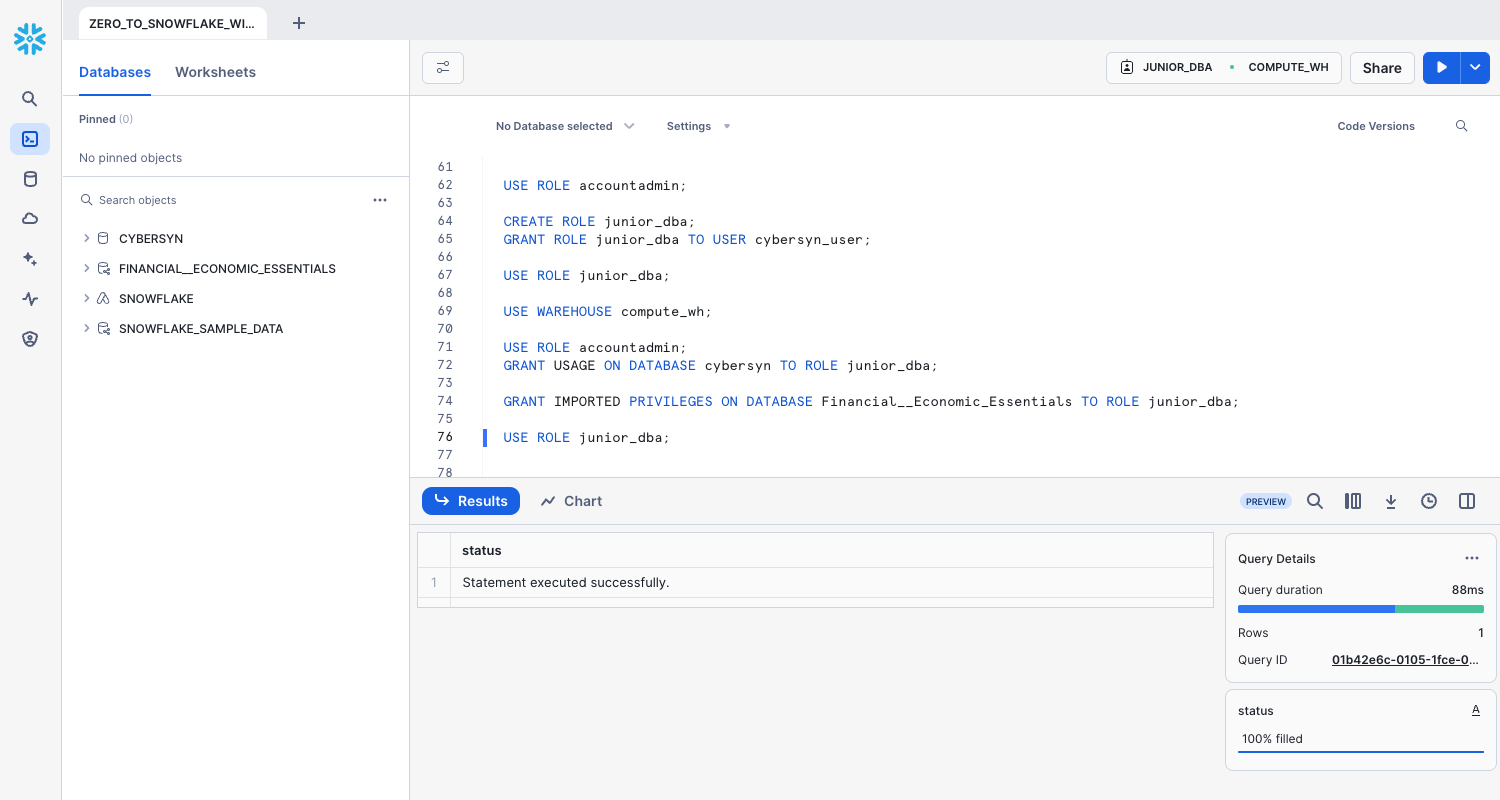
View the Account Administrator UI
Let's change our access control role back to ACCOUNTADMIN to see other areas of the UI accessible only to this role. However, to perform this task, use the UI instead of the worksheet.
First, click the Home icon in the top left corner of the worksheet. Then, in the bottom left corner of the UI, click your name to display the user preferences menu. In the menu, go to Switch Role and select ACCOUNTADMIN.
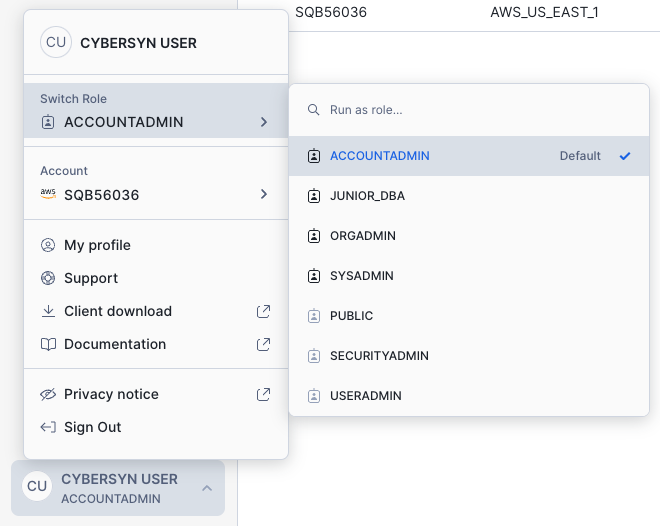
Notice that once you switch the UI session to the ACCOUNTADMIN role, new tabs are available under Admin.
Admin > Cost Management
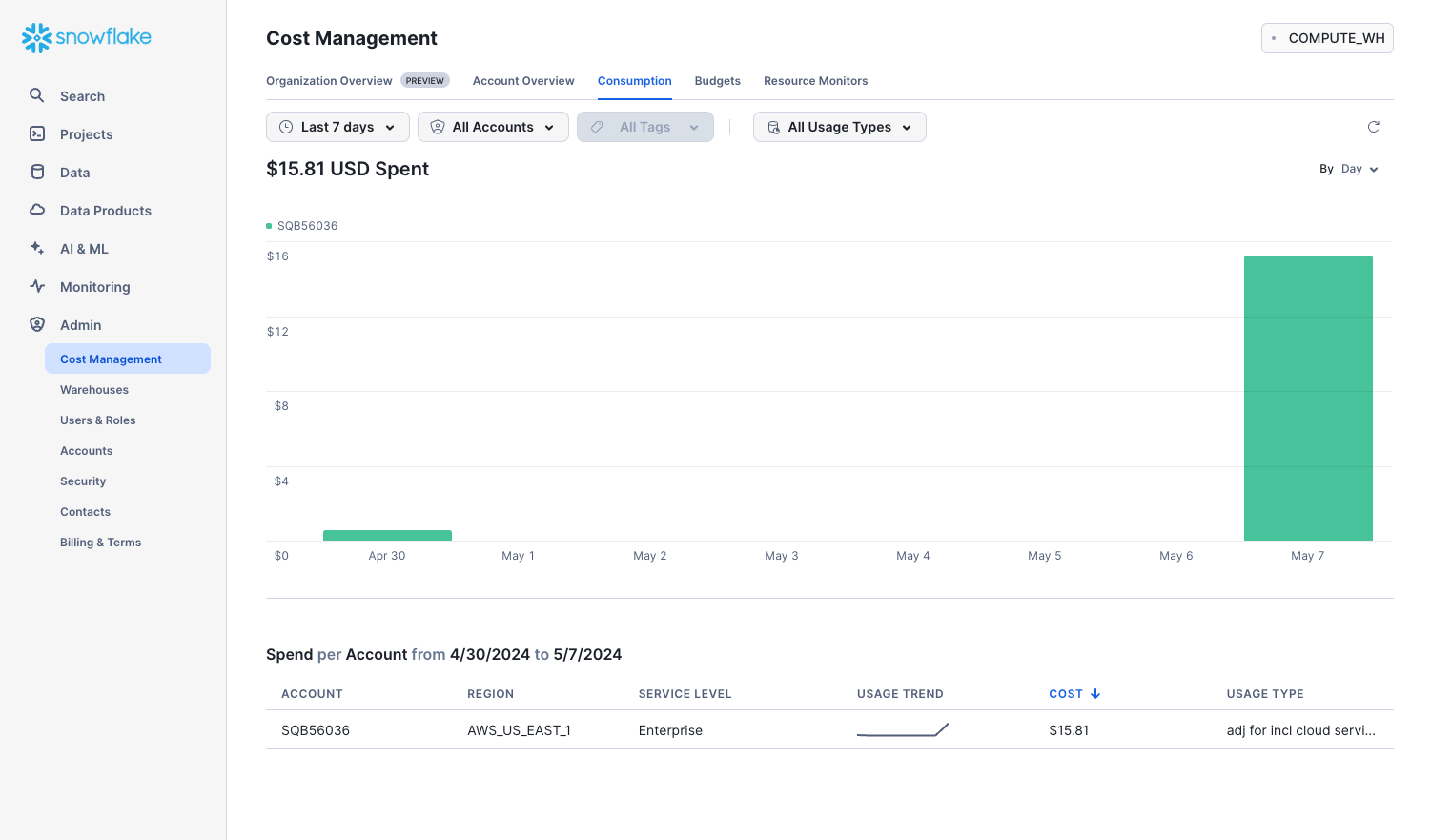
The Cost Management tab shows your usage of Snowflake credits, with filters by account and consumption types:
- Organization: Credit usage across all the accounts in your organization.
- Compute: Credits consumed by the virtual warehouses in the current account.
- Storage: Average amount of data stored in all databases, internal stages, and Snowflake Failsafe in the current account for the past month.
- Data Transfer: Average amount of data transferred out of the region (for the current account) into other regions for the past month.
Admin > Security
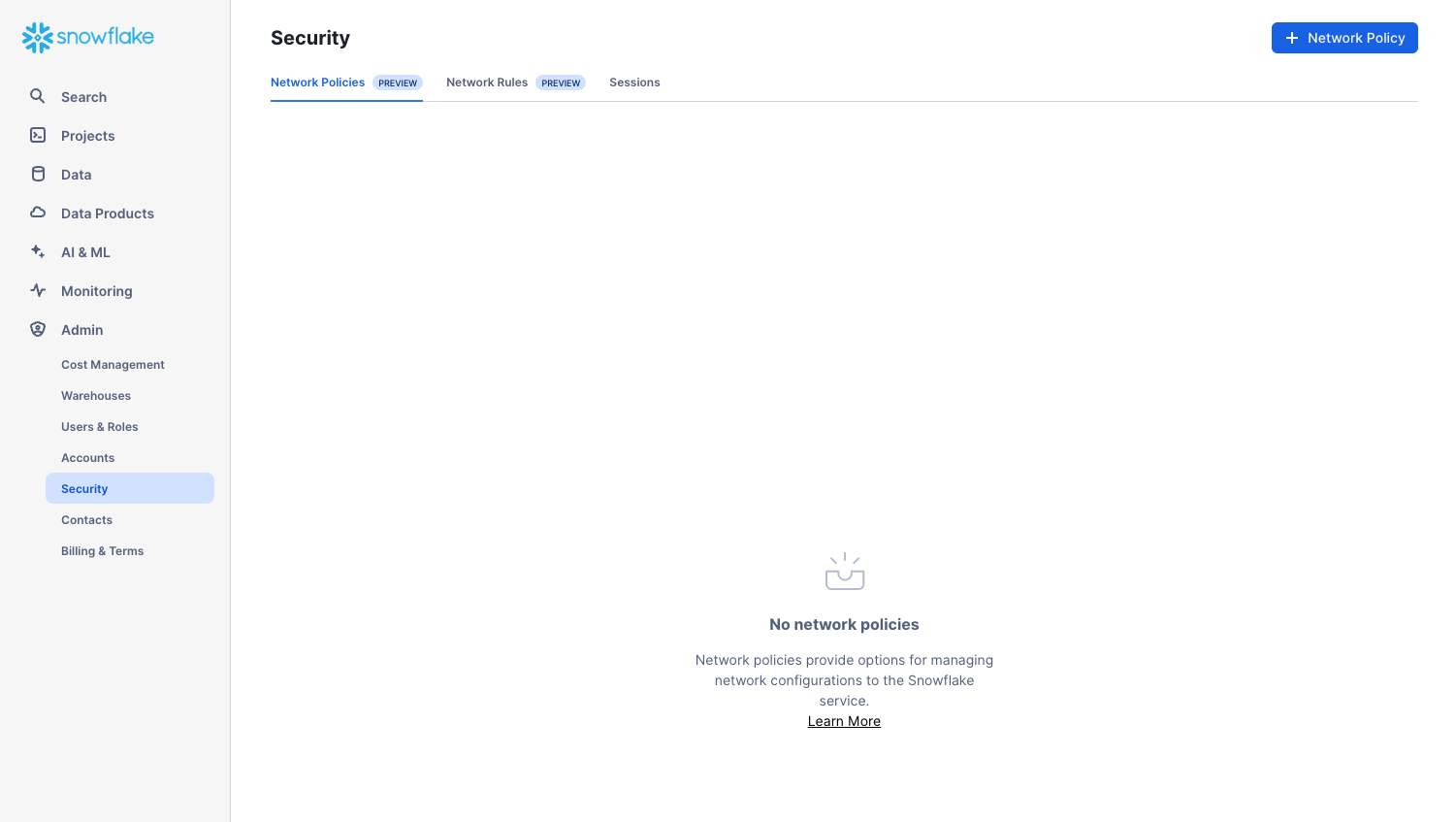
The Security tab contains network policies created for the Snowflake account. New network policies can be created by selecting "+ Network Policy" at the top right hand side of the page.
Admin > Billing & Terms
The Billing & Terms tab contains the payment method for the account:
- If you are a Snowflake contract customer, the tab shows the name associated with your contract information.
- If you are an on-demand Snowflake customer, the tab shows the credit card used to pay month-to-month, if one has been entered. If no credit card is on file, you can add one to continue using Snowflake when your trial ends.
For the next section, stay in the ACCOUNTADMIN role for the UI session.
Snowflake enables data access between accounts through the secure data sharing features. Shares are created by data providers and imported by data consumers, either through their own Snowflake account or a provisioned Snowflake Reader account. The consumer can be an external entity or a different internal business unit that is required to have its own unique Snowflake account.
With secure data sharing:
- There is only one copy of the data that lives in the data provider's account.
- Shared data is always live, real-time, and immediately available to consumers.
- Providers can establish revocable, fine-grained access to shares.
- Data sharing is simple and safe, especially compared to older data sharing methods, which were often manual and insecure, such as transferring large
.csvfiles across the internet.
Snowflake uses secure data sharing to provide account usage data and sample data sets to all Snowflake accounts. In this capacity, Snowflake acts as the data provider of the data and all other accounts.
Secure data sharing also powers the Snowflake Data Marketplace, which is available to all Snowflake customers and allows you to discover and access third-party datasets from numerous data providers and SaaS vendors. Again, in this data sharing model, the data doesn't leave the provider's account and you can use the datasets without any transformation.
View Existing Shares
In the home page, navigate to Data > Databases. In the list of databases, look at the SOURCE column. You should see one database with Local in the column, which we created previously in the lab. The other database, SNOWFLAKE, shows Share in the column, indicating it's shared from a provider.
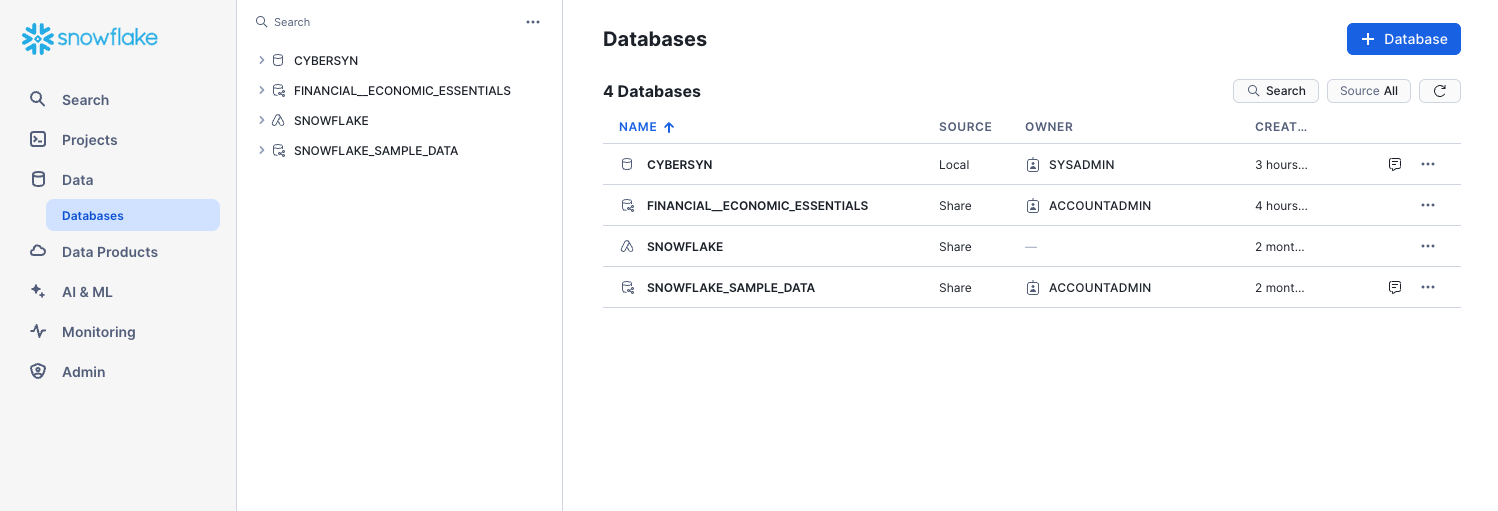
Create an Outbound Share
Assume we are the Account Administrator for our Snowflake account. We have a trusted partner who wants to analyze our data on a near real-time basis. This partner also has their own Snowflake account in the same region as our account. We can use secure data sharing to allow them to access this information.
Navigate to Data Products > Private Sharing, then at the top of the tab click Shared By Your Account. Click the Share button in the top right corner and select Create a Direct Share:
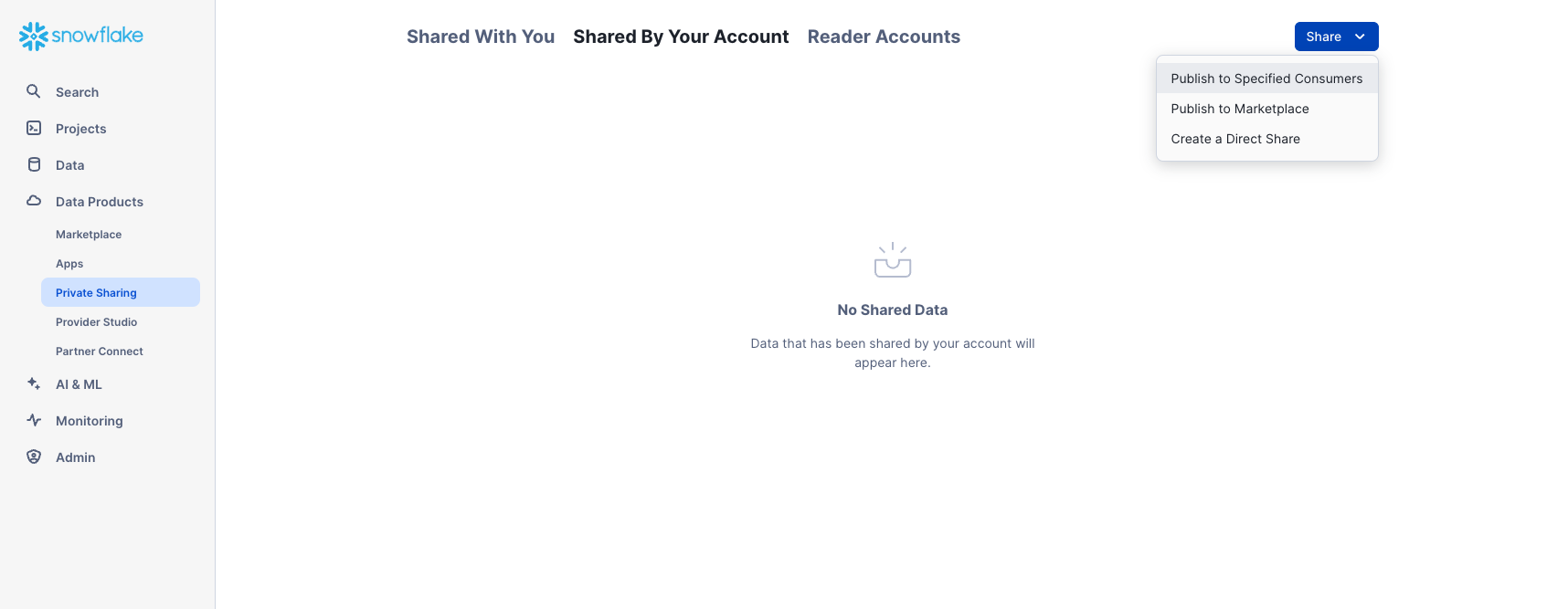
Click + Select Data and navigate to the database and schema you want to share. Select the tables and click the Done button:
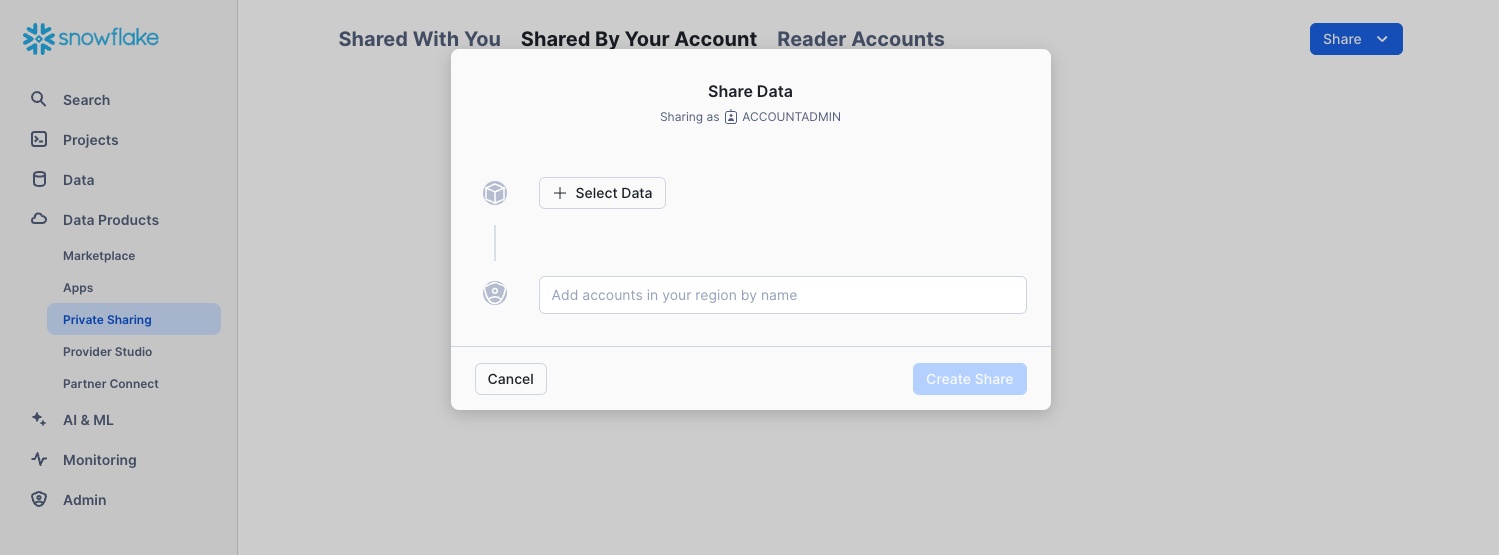
The default name of the share is a generic name with a random numeric value appended. Edit the default name to a more descriptive value that will help identify the share in the future (e.g. ZERO_TO_SNOWFLAKE_SHARED_DATA). You can also add a comment.
In a real-world scenario, the Account Administrator would next add one or more consumer accounts to the share, but we'll stop here for the purposes of this lab.
Click the Create Share button at the bottom of the dialog. The dialog closes and the page shows the secure share you created.

You can add consumers, add/change the description, and edit the objects in the share at any time. In the page, click the < button next to the share name to return to the Share with Other Accounts page.
We've demonstrated how it only takes seconds to give other accounts access to data in your Snowflake account in a secure manner with no copying or transferring of data required!
Snowflake provides several ways to securely share data without compromising confidentiality. In addition to tables, you can share secure views, secure UDFs (user-defined functions), and other secure objects. For more details about using these methods to share data while preventing access to sensitive information, see the Snowflake documentation.
If you would like to reset your environment by deleting all the objects created as part of this lab, ensure you are using the ACCOUNTADMIN role in the worksheet and run the following commands to drop the objects we created in the lab:
USE ROLE accountadmin;
DROP DATABASE IF EXISTS Public_Data;
DROP WAREHOUSE IF EXISTS analytics_wh;
DROP ROLE IF EXISTS junior_dba;
Congratulations on completing this introductory lab exercise! You've mastered the Snowflake basics and are ready to apply these fundamentals to your own data. Be sure to reference this guide if you ever need a refresher.
We encourage you to continue with your free trial by loading your own sample or production data and by using some of the more advanced capabilities of Snowflake not covered in this lab.
Additional Resources:
- Learn more about the Snowsight docs.
- Read the Definitive Guide to Maximizing Your Free Trial document.
- Attend a Snowflake virtual or in-person event to learn more about our capabilities and customers.
- Join the Snowflake Community.
- Sign up for Snowflake University.
- Contact our Sales Team to learn more.
- Access Snowflake Public Data's analytics-ready data on Snowflake Marketplace.
What we've covered:
- How to create stages, databases, tables, views, and virtual warehouses.
- How to load structured and semi-structured data.
- How to consume Snowflake Public data from the Snowflake Data Marketplace.
- How to perform analytical queries on data in Snowflake, including joins between tables.
- How to clone objects.
- How to undo user errors using Time Travel.
- How to create roles and users, and grant them privileges.
- How to securely and easily share data with other accounts.
- Fork repo on GitHub
- Download Reference Architecture
- Watch the Demo